#dragon's rising is more consistant in its plot and development
Explore tagged Tumblr posts
Note
hii I don't know anything about Ninjago but I'd like to give it a try! what would you recommend?
If you want to get to know the older cast and don't mind 14-15 seasons worth of bingeing the begining is alwaysthebest place to start, BUUUT if you want something shorter and with an actual continuous plot line throughout the seasons dragons rising is very accesable to new-comers
#in hindsight im sure ninjago can look scary to get into because theirs like the first two seasons then rebooted#and then like they start organizing it into secrets of forbidden spinjitzu on streaming services until like the seabound arc i think#its alll the same show until dragons rising#ninjago DOES have a continuous plot of sorts but its mostly based on thar years toy themes#and theirs some reconning depending on who write the season#most the time their standalone but other times they continue the plot of thelast season#dragon's rising is more consistant in its plot and development
10 notes
·
View notes
Text
Breath of the Wild / Age of Calamity / Tears of the Kingdom Zelda, part 1/2
The final Zelda (so far) of this character review series is the most developed of them all, and probably has more character content to her in just one game than any of the others, and she has three to boot! With full voice acting (I'm JP voice only), a huge and personal role in the story, diary entries, notable relationships to multiple characters and being discussed by many NPCs there is a lot to talk about, but I'm mostly going off of memory and rewatching the cutscenes since it would be too much work to research every mention of her in all three games.
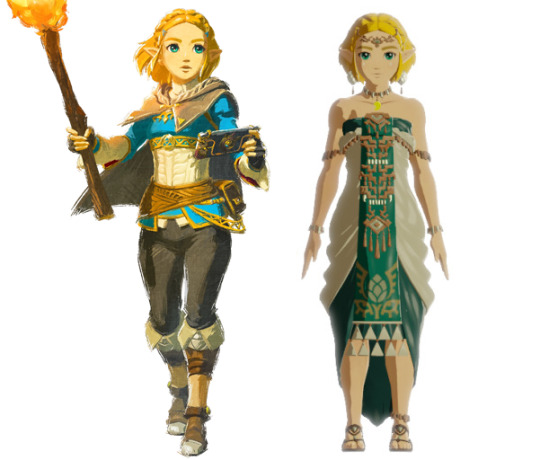
Design
(Ancient dress Zelda model from here)
Not going to copypaste my thoughts on her BotW look since this is long enough already.
It is a pity that Zelda didn't get a full redesign for TotK, but I'll take what I can get. The bob is really cute! And unusual among the Zeldas too, and I guess a nice way to represent that she has moved to the commoner lifestyle.
As for the ancient dress, it looks perfectly fine on its own, but since I value it when the designs have their own unique identity, I wish it wasn't so similar to her white dress from BotW. Maybe there is some connection, like Sonia used to be a priest so maybe the dress design survived through millennia as a prayer dress or whatever, but since that's not actually in the game, I'm not giving credit for that.
The bulkier and sort of unrefined jewelry does a good job making the outfit look ancient, but it's still fancy enough that I can believe it to belong to the royal family. That decorative accessory on the front of the dress is really cool looking and a nice and consistent detail among all the ancient clothes, but man is it a pain to draw. Finally I really like the big earrings and the tear makeup is a great little detail.

When I first saw the Light dragon in the final Zelda memory I thought it looked kind of doofy, with its bright colours, clumpy eyelashes, bulging eyes and borzoi nose, but it has since grown on me. I once read that some Pokemon designer said in an interview or such that if a Pokemon design looks too cool, they add something uncool to it to make it more memorable, and I think it's a pretty good design philosophy. There have been several LoZ designs that have shocked me at first, but eventually I get used to them and they will look just right. They could have given the dragons a more cool or elegant look, but that would have also risked making them more generic. Also the eyes give a good impression about Zelda's state that nobody is home there.
Character
This iteration of Zelda is easily the most fleshed out of them all, since we get to see so much of her relationships, character development, emotional reactions to plot events, and also stuff she does outside the immediate plot.
BotW Zelda's dread over the impending doom and the self esteem issues that rise from it are a large part of the story. There are other Zeldas who also worry about the Plot, but in BotW Zelda's case it's incredibly personal since her failure to do her crucial job in preventing the disaster is at the core of the story. According to Rhoam's diary, she had already internalised her duty at the age of six (and this caused her to not show any weakness even at her mother's funeral), and from there she spent her life trying and failing to awaken her powers. This lifelong crushing sense of responsibility and guilt and the failure to live up to her demanding father's expectations give BotW Zelda a very melancholic vibe that constantly pops up through the game. Though I must say that in the memory where the champions perform their little ceremony and Zelda gives a long speech to Link, her voice acting gets really awkward when it sounds like she's about to start crying with every word.
Once she finds her inner strength, Zelda gets her badass moments as well. I especially like the grand finale of BotW where she, glowing with power, calmly stands before Calamity Ganon's pig form and doesn't even flinch when he charges at her. And in the TotK flashback cutscenes she can apparently be taken to a battle against Ganondorf as a part of Rauru's sage posse.
I called out Skyward Sword Zelda for being a bit too much of an ideal girlfriend, so I'm really glad that the memory where BotW Zelda lashes out at Link exists. It works to prevent her from being just a pure maiden who is victimised by unfair outside circumstances. Or I mean that does happen to her, but letting her display some negative traits (like frustration and jealousy) that she's personally responsible for as well makes her feel more like an actual person and not just a perfect victim.
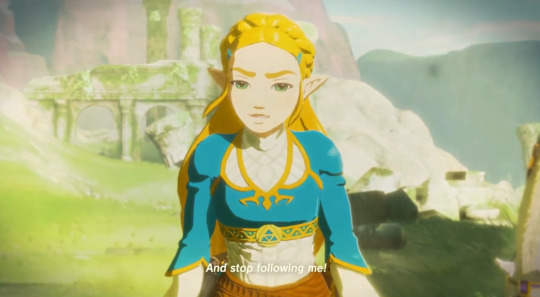
Even if BotW Zelda's heavy burden is a huge part of her character, luckily that's not all there is to her. And not just because being multifaceted of course makes her more interesting, but also I find it a lot more realistic that not every moment of her life had been constant suffering.
One of her most charming and notable traits is her nerdy scientist side. It certainly sets her apart from the other Zeldas, and also gives her something else to do than just worry about the plot and be a princess. The memory where she geeks over a frog and goes on such a ramble over its scientific properties that she forgets basic social norms is such a great piece of characterisation, and it's cute how her enthusiasm returns in TotK where she's excited over Zonai discoveries, and is also into Mineru's constructs. According to AoC, studying was also apparently something she did with her late mother as a child.
Her research notes also detail how together with Purah and Robbie they discovered various things about the ancient Sheikah tech, but I do think it's a little disappointing how we don't get much anything concrete about Zelda's contributions specifically. There's a lot about her being interested in the Sheikah technology and how she apparently was a part of research group, but all actual discoveries are attributed to different characters or left vague, so as a result she comes across more like an enthusiastic hobbyist who in the end doesn't actually get anywhere. I would have liked it if for example Purah's diary had a line of how Zelda's efforts helped them understand the Guardians better or something like that, but now you have to imagine her contributions yourself. The closest we get is how in AoC she gives one Sheikah artefact to Rhoam, which ends up saving his life, but it's not quite what I'm looking for since Zelda didn't know what the item would do, so it feels more like luck. But even if the execution didn't quite land, I'm glad that AoC took the time to give some kind of resolution to the Rhoam-forbids-Zelda-from-Studying aspect and has to admit that he was wrong. And regardless the Sheikah tech works well to give Zelda her unique identity, and it's also nice how two of her weapons in AoC are based on it.
BotW Zelda also has a playful side, like for example she runs up to play with a dog she just saw, or jokes with Urbosa about how they both had to act all formal in front of an audience despite being long time friends. She is also a very proactive character; thanks to the "find the memories" gameplay, we see her travel all across Hyrule instead of just sitting at her castle, she's the one to handle all business with the Divine Beast pilots (and since they're all high ranking individuals among their people, this makes Zelda pretty politically active as well), and BotW ends with her wanting to work on rebuilding Hyrule.
Zelda being active continues in TotK, where there's a lot of little snippets how she has founded a school, installed memorial monuments, managed survey teams, worked on gardens, and so on. And of course she also immediately volunteered for investigating the Gloom situation at the start of TotK as well, and from the stone tablets we can read how she also got into fiddling with Constructs and fashion in the ancient Hyrule. Obviously it would have been nice to actually see all of this instead of just reading or hearing it second hand, but I understand that not everything can get a fancy cutscene, so it's at least nice that this was included in the game at least in some fashion.
I touched on it in the part about her nerdy side, but let's also bring specific attention to the fact that BotW Zelda also has a delightfully weird and chaotic side to her. She tries to feed a frog to Link, and the TotK stone tablets tell about how she would ride Mineru's construct despite the protests of the chamberlain. And while the recipe she cooks in AoC is a legit BotW recipe, the way the scene is depicted clearly makes her come across as eccentric in her cooking.

AoC also casts her in a leadership role once her powers finally awaken and she becomes more confident. Honestly I prefer the insecure nerd Zelda over the charismatic leader because I don't think she quite has enough credibility to pull off rousing speeches to masses at this point of the story, but I guess it does make sense for the kind of story they're telling
Her powers are pretty inconsistent between games, BotW is obviously all about awakening her sacred sealing power, and the game ends with her saying that she used all that up. And then TotK reveals she had two different powers all along; Sonia's time power comes out of nowhere and Rauru's light power overlaps with her BotW ability a lot. But I can live with a discrepancy like this since I like the story of TotK.
Since I brought up how it's nice that Skyward Sword is implied to have a knitting hobby, I suppose it should be mentioned that BotW Zelda made the Champion's blue clothes and accessories. Though here it feels a lot less important and even a bit tacked on, since BotW Zelda already has so much going on that is more important and meaningful to her character. But I guess crafting clothes is princessy enough of a subject that Rhoam approves of spending time on it instead of prayer practice and even brags about it. A different little detail that I like more than this clothing thing is that we get to learn Zelda's favourite food (fruitcake).
In Japanese Zelda uses polite language, but no honorifics. I'm no Japanese expert, but to me this comes across as keeping a polite distance from everyone, while also implying status ("I'm a princess so I don't need to use a honorific for you"). Also in the beginning of AoC, Link (who at this point is just a random knight to Zelda) kneels in front of her and she doesn't even acknowledge him, so it appears she's pretty used to her standing. The stone tablets in TotK also describe her having an undeniable air of nobility.
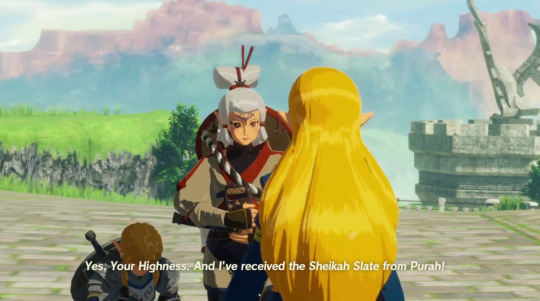
#breath of the wild#age of calamity#tears of the kingdom#legend of zelda#zelda#character review#meta#totk spoilers
30 notes
·
View notes
Note
https://www.tumblr.com/horizon-verizon/712224861642162176/i-dont-understand-why-people-use-the-book-as-an
well i think the reason why Aemond has turned out to be the "dutiful son" because at first the showrunners didn't want Daeron to be in the show, and it was Daeron who has the dutiful son/the most popular son of Alicent and the closest to her, so obviously they give him a lot of Daeron's personality traits. But since Grrm confirmed that Daeron will be in S2 maybe we will see more of Book!Aemond characterization or maybe it's me just being too hopeful that we will not get more of the whitewashing of Aemond, and it has been very annoying that they literally adapted Mushroom's claims about every and each character except Losermond. They're very close to turning him into Gary Stu. Also Helaena is highly underdeveloped she doesn't even feel like she is human, she is more like a mere plot device. and they didn't put any foundation for their made up ship. Is it because he said he will marry her? will that because he is oh so dutiful and cares about his house legacy. they looked at each other? Well Aegon kept staring at Rhaenyra during the dinner scene, does that means he is in love with her or has fathered Aegon iii and Viserys ii? This is silly.
Yes, it is silly, yet anon that is what we have as a reason for why some fans ship those two.
Even if Daeron hadn't been in the show, Aemond's characterization should not change, because he was what he was and it is integral to how the Dance played out as it did toward the end.
And how could one not have Daeron and his bungling of the taking of Tumbleton, how things went down there, and his burning Bitterbridge thinking Lady Caswell was responsible for Maelor's death?! Were they thinking of making Ormund Hightower the leader of that part of the green forces?! Like, how boring, if so!
Hate all this for Helaena, the underdevelopment. The lack of it. She's a nonentity, despite having such power. Gone to waste altogether. Not even scenes with her trying to use it for her family of either side or see her try to connect with Rhaenyra (what stops her? fear of repercussions? direct tellings from Otto and Alicent? disinterest? depression? we'll never know because the writers think that action>character development). She may have only been mentioned at most 10 times throughout the Dance and never played an active role besides killing herself and talking one quote of displeasure and sarcasm in canon, but the show had its opportunity to make her a real person and it instead decided to make her a nearly silent decoration that happens to see images in her head that everyone just...brushes off?!
I'm afraid I can't be optimistic as you about Aemond's whitewashing ending by the first episodes of the next season. In any first season, you set up your character's motivations and values to lead into the rest of the next episodes until its end, where their selves either undergo great changes or continue to serve a lighter purpose -- depending on how central they are and what the writer/director wants to do with them. Everything hinges on what's presented in that first season, in the first portrayal of that character, in the first turning points in their personal development. For Aemond, that was him in episode 6 being bullied due to not having a dragon by his own brother and the V boys, him claiming Vhagar and "proving" his Targness/strength, and him obviously eager to battle at least with Daemon.
The firsts are not only supposed to let the audience know who this character is and why we should care about them OR what get us hyped for the rest of more rising action; they set this character up and lets us know what sort of person/role they are and what the writers want to do with their arc, and it presents their perspective of that character and their arc.
So if we see Aemond consistently get whitewashed and it being done in the first season...there's a 98% certainty that he will continue to be whitewashed. The other two percent is the abused hope I'm currently putting up only for me to pretend I never said anything at all if I'm wrong (I jest).
#asoiaf#a song of ice and fire#asoiaf asks to me#daeron fire and blood#daeron the prince#daeron targaryen#daeron targtower#aemond targaryen#aemond's characterization#daeron's characterization#hotd characterization#hotd writing#hotd critical#hotd comment
18 notes
·
View notes
Text
why is rayllum popular?
I was thinking about Rayllum’s place in fandom, recently. I’ve made it no secret that the Rayllum and broader TDP fandom is by and large the biggest one I’ve been in, and as a blog who’s been here since pre-s1, it’s the only fandoms where it feels like my individual opinion... holds weight, I suppose is the best way to phrase it, no matter how strange it is to think.
So why, basically, is the question I want to answer, and I think I’m in a unique position to, as well. I’ve seen all TDP ships rise and fall, what got popular and when, pre and post every season. So why, then, is Rayllum ‘popular’? Why in a shipping survey would it be the ship at least half the fandom answers as their favourite?
I have a few theories, so without further ado, let’s get into it.
1) Dynamic
I’ve talked previously about why personality wise, Callum and Rayla mesh well, and this goes for them as a bond/friendship as well as a romance. I know for me it was their possible dynamic (as well as a few other reasons) that got me invested in their relationship, just from a singular screencap released before the show dropped and TDP’s basic premise.

What did I glean from this screencap, exactly? Well, we knew that Callum was an artist and interested in whatever seemingly magical object he was holding in his hand. He and Rayla are sitting comfortably close. Meanwhile, she’s looking off with a bit of an eye-roll — a little done with him — but she’s also smiling and judging by her posture, doesn’t seem to have been the one to sit down first. AKA he’s earnest and intrigued and she’s exasperated but fond. Sold. Mostly because this is a dynamic I know in other ships, but also because it communicates work. There’s something to be said for a ship between two people where one person isn’t as invested in something as the other, but still makes a damn good effort about it, or is at least endeared by it.
Rayla and Callum’s dynamic in S1 similarly suckered me in. They take each other and audience through a wide range of emotions: fear, anger, happy surprise, worry, relief, humour, and just happiness. They, point blank, have a fun and engaging dynamic. They push each other, inspire change in one another, tease and care for one another, and call each other out on their crap. They’re friends and it’s easy to believe, which is what you would want for a found family dynamic that includes two of your three Main Characters.
But what leads to this believability? Well, good
2) Development
The Dragon Prince, as of the completion of its first Arc (s1-s3) consists of 27 episodes. The main trio, and Callum and Rayla by extension, meet in 1x02 and only grow to be on friendlier terms (aka Not Enemies) in 1x03. There’s also a few episodes that doesn’t provide much for group bonding, like 2x05 and 2x06. But, because I think 1x02 is incredibly important for Rayla and Callum’s dynamic even if it hardly has them on good terms, we’ll go from there. Thus, from 27 episodes we’re down to 24 episodes that also has to include a worldbuilding, and plenty of other characters who aren’t the main trio, and create and resolve conflict, and entirely separate plot points.
It’s not like Callum and Rayla don’t disagree or act poorly towards each other in all of those episodes, either. Sometimes they argue and treat each other like downright jerks (more on that here). But over time, they learn to disagree more respectively to not having a single actual fight in s2 and just one in s3, which is also quickly resolved.
I don’t think I’m remiss, then, in saying that while there are relationships that are just as distinct and well developed, Rayla and Callum are the relationship that has the largest amount of sheer screentime, even before s3. I’ve talked before about how even more ‘trio’ centred scenes in s1 usually hone a focus on Callum and Rayla’s relationship. This does not mean that Callum and Ezran’s, or Ezran and Rayla’s, relationship are not important, because they are, and the show treats them as such. Screentime just gets allotted differently sometimes.
But let’s do a quick break down at the main, season long persisting relationships. The trio (up until s1); Soren and Claudia (but not in every episode and they also spend a decent amount of time having separate plotlines); Callum and Ezran (up until s3); Viren and Aaravos (s2 & s3); Janai and Amaya (s3); Viren and his children (s1 & s3); Soren and Ezran (beginning of s2, & s3); Callum and Claudia (beginning of s1, & s2); Ezran and Rayla (until s3); Ezran and Zym (mostly s2).
Callum and Rayla? S1-S3, all the way through.
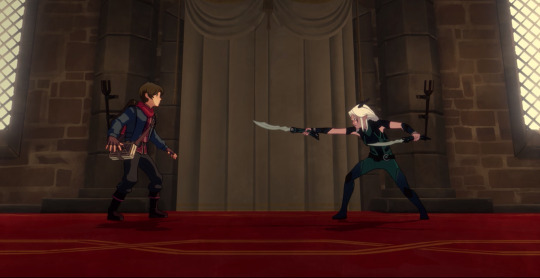

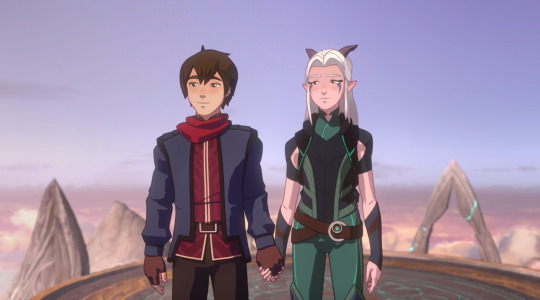
And because of that, Callum and Rayla’s relationship is incredibly multifaceted. And most of the problems they face — the initial arc at the castle; bonding and trust in s1; Soren and Claudia’s lies in S2; mourning and everything with Harrow; Dark Magic and the dragon; getting past Sol Regem; the Ghosting; whether to trust Nyx; whether to stay at the Spire or not — directly cater to developing and changing their relationship.
Ezran and Rayla have less places to go in the first arc of the show because they have less mistrust and remain on easy terms for the majority of their two season run. Callum and Ezran have disagreements, particularly on Callum’s end, but you know from the very start that there’s nothing he wouldn’t do for his baby brother and that they’re family. Well they’re enemies, and then they’re friends, and they drive each other crazy sometimes, but they also have each other’s backs, and shape each other’s worldviews in new directions. When Callum crumbles from the loss of his father and a lack of magic, Rayla is there with full honesty between them; when Rayla breaks down because she’s been banished and is still wrestling with an unwanted legacy, Callum holds steadfast in patience and support. They disagree. They problem solve. They make each other laugh. They platonically adore and love each other. They romantically love and adore each other. We see them address and overcome conflicts and choose each other every time when push comes to shove.
They’re two characters who naturally complement each other very well and just work as a dynamic. They occupy a unique space in each other’s lives and arcs. They change each other.��Their arcs intersect in near perfect circles. Most of what we know about each of them as people comes from their interactions with each other in the first place.
They’re two of the show’s three Main Characters, and the amount of screen time their relationship receives reflects that. It’s therefore not surprising that a lot people who like The Dragon Prince as a show also really like Rayllum (even if it’s hardly everyone). If you don’t ship them, of course, that’s 100% fine; you can still enjoy their bond easily outside of romance because there’s enough depth to. But if you just hate watching them interact in any way? Yeah, you’re going to have a rough time of things.
3) Plot relevance
This is semi connected to my last point, of Callum and Rayla being two of the show’s three main characters, but I thought it was worth mentioning as this point ties into a character type and ship preference of mine I’ve had for a long time. Which is to say: I always really like the protagonists.
Callum, Rayla, and Ezran are — on the clear cut “good side” but also, I think, of the series in general — the most important characters on the show. Story wise, broader narratively wise, etc. They’re the core three. Rayla is the one who messes up the mission and has her team discovered, which is what sets in motion literally everything else for the show: Viren’s snapping point when Harrow rebukes his plan; Callum snapping at Ezran because he knows their father’s days are numbered; and Ezran finding the egg of the Dragon Prince, hidden deep in the castle, as a result.
If you’re drawn to characters who shape the story in an extremely active way, you probably want the protagonists or the direct antagonist. Their motivations are unique and largely stem from within themselves. As a simple contrast, the trio choose to take the egg to Xadia. Nobody tells them. The boys make the decision to go with Rayla fairly independently. Compare this to Soren and Claudia’s decisions for most of s1 and s2, which always stem back to what Viren — the main antagonist of those seasons — told them. This is not to say Claudia and Soren don’t have independent choices/desires (that’s why they chafe against their dad’s orders in the first place) or that the trio aren’t built as interpersonal characters or aren’t influenced by their relationships (one of my favourite things about TDP is that it builds character through relationship) but that the trio have more active than reactive story decisions earlier than most of the supporting cast. Callum and Rayla’s decisions usually stem from their relationship with each other in some way (not always, but usually) and how they’ve been changing each other.
For Callum and Rayla this manifests in a particular way even within the group dynamic. For example, Ezran’s existence is what brings them together in the first place. Him finding the egg changes Callum and Rayla’s developing relationship, as Callum has had conversations with her as an enemy, and Ezran hasn’t at that point. (That’s not say they don’t start out as enemies, because they do, but it’s, ironically, far less personal.) Then, Callum decides he can fully trust Rayla when she says she would lose a hand for her baby brother; the trio’s hug on the ice solidifies the trio’s group bond and Rayla and Callum’s individual love for Ezran, but also in two operating as a team from this point on (in so far of taking care of him, at the very least).
Another aforementioned thing, like I said, is driving the plot forward with decisions. I made this post after S2 and before S3 about how, in the first two seasons, Ezran doesn’t make too many decisions, and how I was hoping they would turn this story consistency / character flaw in some ways into a plot point in S3 (and was very pleased when they did, and Ezran had to confront his own lack of decision making).
But the reason that point exists is because Callum and Rayla are making the decisions. In season one and season two, for trio related plotlines, they’re usually the ones driving it. Callum and Ezran, as a human primal mage and a peace championing king, have the most clear cut narrative routes forward that will each most directly affect the world. And while politics in TDP are incredibly fascinated, I know an equal if not greater area of interest for me is the magic and its related systems, and the furthering of Callum’s mage arc. An arc that was already driven by Rayla in so many ways, as I’ve talked about before. (Promise I’ll stop plugging more of my own meta now, lol.)
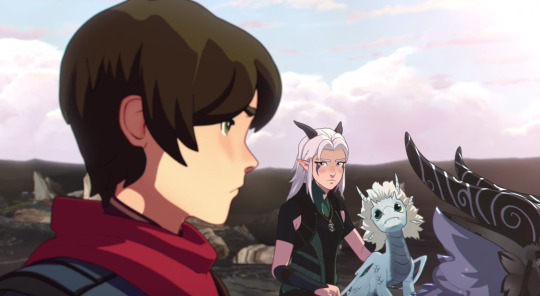
Again, since they’re main characters, this isn’t surprising. You usually want your main characters to be active and driving the plot. And it’s not as though other, more side characters, like Amaya or Janai (at this point in time), or minor characters, like Ellis and Lujanne, don’t have relevant plot lines or don’t drive the plot. They very much do. But for far less episodes, and that less consistent drive means other people are often driving it more.
Like, I’ve always loved the Leader archetype in media because I always gravitate towards the character who has to make the most Hard, Defining Decisions in any given piece of media. And if the character I’ve fallen for in a piece of media doesn’t occupy that role, I’ll often put them in it in a sort of AU, because that’s what I enjoy reading and writing. So it’s not surprising that Callum and Rayla are my favourites as that’s their present job in the series and throughout, and not surprising that this may be a factor in their popularity, too.
4) Narrative
Narrative, to me at least, is different than plot or story. Maybe I’ve spent too much time in Narrative Theory courses, but Narrative, to me, is the parallels and premise a show builds itself upon. Two peoples start off at war? By the end, that war will probably be resolved. Generational parallels in fantasy are exceedingly common, too. For The Dragon Prince, despite its name, thus far mostly has the conflict between elves and humans at its core.
The point I’m making here isn’t that “Rayla and Callum had to have a romance to fulfill the show’s narrative” because they didn’t, although it does help reinforce it and it’s a nice touch. The show could’ve left them as friends and of course another elf-human romance with Janai and Amaya was planned even before Rayllum was.
My point with this is that Rayla and Callum occupy a unique position in the narrative, as does their relationship. Rayla is the main elf we know for the majority of two seasons (with Lujanne and Runaan as the exceptions). Humans, and maybe even to a greater extent, elves (because of their magic) are one of the main draws of the show. So are the human kingdoms and politics.
Soren, Claudia, and Viren are all fan favourites, but they’re mostly kept to Dark Magic, human politics, and their family unit. Runaan and Ethari are deep in elf central. Ezran is now fairly locked down in Katolis and always had a different set of responsibilities as crown prince than Callum did. Janai and Amaya toe the line but will most likely be stationed in Lux Aurea more commonly together and that will likely be their endgame location, too.
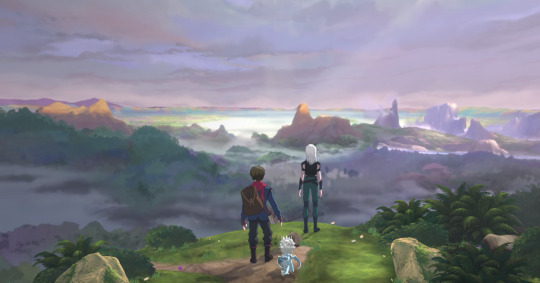
Callum and Rayla can go anywhere. Callum has looser responsibilities to the throne but also has a stake in politics. He wants to explore Xadia. Rayla is by and large his guide to her homeland and can likewise travel anywhere, especially now that her place in the Silvergrove is up in the air. She could also go back to Katolis. This is all true post S3, and to a degree was true post S2.
Rayllum had a massive boom in popularity following S2 and for good reason. They had more screentime, softer but more romantic leanings, would be travelling Xadia alone for at least a little while, and more. But another reason I think is that S2 made it clear how much these two bring the two halves of the show together.

Magic and politics. Grief and forgiveness. Elves and humans. Callum ties Rayla to the human side of things (Claudia and Soren for example) and Rayla ties Callum to the elven side of things (Xadia and primal magic). A lot of their S2 conflict comes from trying to make these things work and strike that balance. And by S3, when they do get together. they have a lot of it figured out.
Both are characters uniquely connected to other characters we tend to like. For Callum, he has the royal family - his parents, Ezran, and Amaya - and their connections/companions - Opeli, Corvus, Gren, Janai, Soren, Claudia. Rayla does the same for the majority of the elven side with Runaan - who would have a complicated relationship with Callum to say the least - and Ethari. They connect the show through each other and their relationship, regardless of whether it’s romantic or not (although fandoms are gonna ship) and it’s not surprising that the audience connects to them so much for it either.
Conclusion:
There a lot of things that can explain a ship’s popularity. I’ve seen fandom ships rise to popularity that I called from miles away whether they were my fave or not, and I’ve also seen super popular ships that are very surprising to me, although that doesn’t mean they’re either ‘good’ or ‘bad’.
Another aspect of Rayllum’s popularity that I want to talk about is their race. While gender can play a part in a ship’s popularity (it’s definitely more rare for big ships in fandom / on tumblr to not be gay, specifically mlm, for example) I think race also plays a big role and people talk about it far less. I see a lot of people who ship gay ships, for example, and really emphasize that part of representation - which is important! - but not that those characters are also characters of colour / are in an interracial relationship, or that by shipping that gay ship (if it’s white) is refuting a canonical interracial relationship. Shipping, of course, isn’t dictated by gender or race, but as someone who tends to ship m/f interracial couples, it is something I’m familiar with. People ignore interracial rep in favour of propping up or emphasizing same sex representation all the time.
Which is to say: sometimes people put Rayllum down for being a ‘het’ ship without factoring in its importance of being an interracial relationship, and Callum being a lighter skinned mixed character of colour (or even a white passing character of colour) lending itself to Rayllum’s popularity as a ship can coexist simultaneously, and I think awareness of both is important.
I also know though, as someone with a decent amount of interracial ships that include no white characters, are between two darker skinned characters of colour, etc. that I would be here shipping Rayllum no matter what. I’m also not saying that if you don’t have any interracial ships you love other than Rayllum that it indicates anything about racism. Some people just aren’t shippers usually and Rayllum’s a general exception, or a unique bond between two white characters really grabbed you, and that’s 100% fine. Shipping is complex and should always be fun.
But this is something I wanted to mention. However, I also don’t think it actually contributes to Rayllum’s popularity very much (like maybe 1%). TDP as a whole is praised for its racial diversity, which is actually the area I think it succeeds the most of. All of its canon ships and with some exceptions for fanon ships (Gren/Soren and Rayla/Claudia) are interracial.
Basically, in summary, I think Rayllum is as popular as it is due to its layered dynamic, steady development, pointed plot relevance, and the way it encompasses so much of the show’s narrative (of love). For more details about why they work so well and all the richness in their dynamic, turn to the very talented writers, artists, meta writers, editors, and more that the Rayllum fandom has to show.
Because, really, they’re just cute as hell.
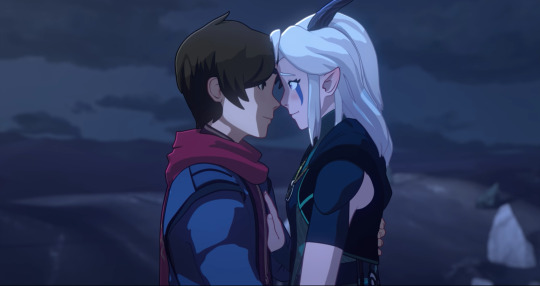
What about you? What are the things that drew you to Rayllum and when did you enter the fandom? What do you think other people love about them? Feel free to share below with your reblogs, tags, or replies. I’d love to hear them as I’m just one person, and can only really speak from my experience and what I’ve seen. I’d love to know what you have!
184 notes
·
View notes
Text
Final Fantasy II review
One of the most interesting parts of the Final Fantasy series, and a big reason why I’m so fond of it, is that every main series game takes its own approach to the gameplay. From the job systems of III and V, the Materia system of VII, the Junctioning system of VIII, or the straight up action combat of XV, every game has a different focus that makes them stand out, and while the results can certainly fall short at times, it’s still something worth commending. For example, take the subject of today’s review, Final Fantasy II. For the second game in the series, and a game that came out in 1988, it’s a huge step up from the original game in a lot of ways. A much more detailed plot, containing several defined playable and supporting characters, a much more experimental battle system, the introduction of many elements, gameplay and otherwise, that would establish a true identity for the series, away from just being a ripoff of Dungeons & Dragons 1st edition, it’s an impressive and critical step forward for the series. Unfortunately for the game, it hasn’t been 1988 in over 30 years, and it’s now easily the weakest game in the series in my opinion. As for why that is, well, that’s what we’re taking a look at today. As with the first game, I’m reviewing the PSP version. Note I’ll be pretty lax with spoilers, so take caution, if you actually care to avoid spoilers.
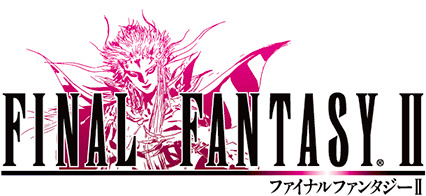
Story: Final Fantasy II takes place in an entirely different world than Final Fantasy I, a tradition that every main series game would follow. The peace of this world is shattered after the rise of Emperor Mateus of Palamecia, who, bent on world domination, raises a fearsome army and unleashes the denizens of Hell upon the land, conquering a large portion of the world. The city of Fynn organizes a large resistance effort, only to be attacked by the Emperor’s army, forcing a small remnant to flee to the town of Altair, establishing the Wild Rose Rebellion, led by Princess Hilda. During the fall of Fynn, four youths, Firion, Maria, Guy, and Leon, attempted to escape as well, only to be attacked and left for dead by the Emperor’s soldiers, with Leon going missing as well. Rescued by the rebellion, and healed by the white wizard Minwu, Firion, Maria, and Guy, having nothing left to return to, and wishing to search for the missing Leon, join the rebellion to fight back against Palamecia. Meanwhile, the Emperor, his army having taken heavy losses taking Fynn, takes to devising much less conventional methods of establishing his rule, starting with a massive airship called the Dreadnought, meant to scare the populace into obedience, on threat of total destruction.
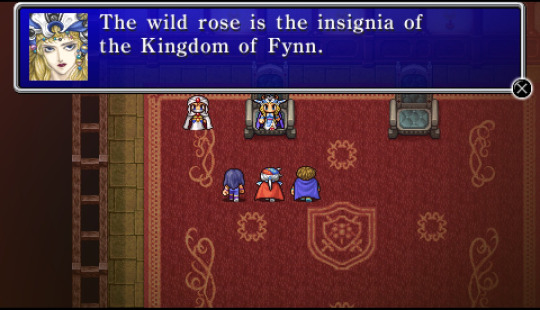
Compared to the very light plot of Final Fantasy I, the story here is much more involved. Instead of wandering between locations more or less aimlessly, there’s always an explicit plot reason to go to new locations, the party being given tasks like finding mythril to supply the rebellion with better equipment, or trying to recruit potential allies. Compared to the party in the first game just being completely blank slates, the party consists of the more distinctive Firion, Maria, and Guy, with the fourth slot being filled by various guest characters that come and go as the story goes on, such as Gordon, the prince of the fallen kingdom of Kashuan, and Ricard Highwind, the last of the dragoons, and there’s actually an established side cast, including characters like Hilda, the leader of the rebellion and princess of Fynn, Paul, a noble thief assisting the rebellion, and Cid, a former knight who maintains the world’s only airship, with this notably being Cid’s first appearance in the series.
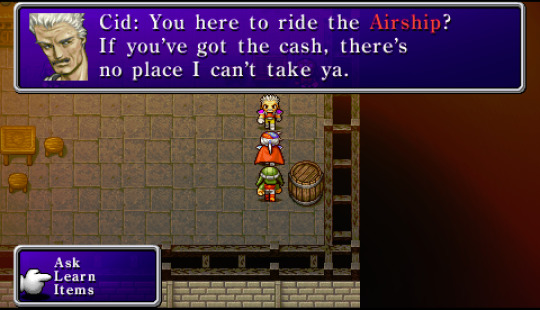
Final Fantasy II is also very noticeably darker than the first game. While the plot circumstances of the first game weren’t exactly cheerful, with the world falling apart due to the influence of the Fiends, outside of a select few towns, this wasn’t very obvious, and the game overall carried a bright, adventurous feel. Not so with Final Fantasy II, where the Emperor is a much more prominent and ruthless villain who’s already conquered or ruined a majority of the world, always keeping another plan on standby, and staying one step ahead of the heroes. Many characters die over the story, from random NPCs to even temporary party members, and the game overall carries a prominent melancholic, empty feel to it, one that’s very impressive considering the time it was made.
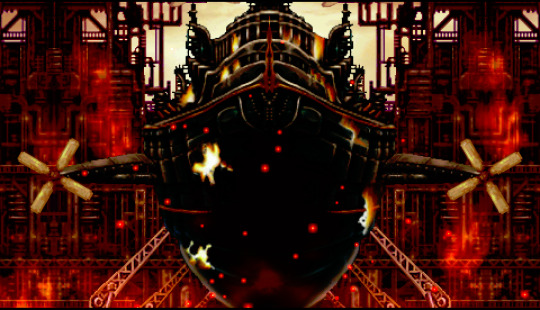
To be honest, however, it actually goes a bit too far in this regard. Almost everything the protagonists accomplish comes at the cost of allies dying, or something preventing them from fully completing their mission. Many NPCs are pessimistic about the chances of humanity being able to win against the Emperor, and so much destruction is wrought upon the world by the end that it seems there’s not even much left to save. From the very beginning of the game, which starts with your party instantly being destroyed in an unwinnable battle, the game is nothing but a constant stream of death and hollow victories, with plenty of characters you can find mourning their losses, and there’s very, very few points in the story that offer any sort of relief from it. Combined with the Emperor barely seeming bothered by anything the party accomplishes, and running circles around them more than a few times, it’s very easy to simply lose any investment in the story.

The characters unfortunately only add to this lack of investment. It’s hard to hold it against the game, but the main party of Firion, Maria, and Guy is still easily the least developed cast in the series. They have little dialogue to themselves to begin with, and have very minimal personality traits, especially Firion, who pretty much only exists to be the hero by default. Additionally, whereas in most RPGs, the cast’s varying personalities and skills tend to gain importance, here, the only skill any of them have is Guy being able to talk to beavers, which only comes up once in a way that doesn’t even affect the story, and, again, they have nearly no personality otherwise, which totals out to each of them having, at best, 1 moment each throughout the story where they’re not completely interchangeable with each other, which barely elevates them above the completely blank slate party of FF1.

The guest party members and NPCs fair a bit better, but not by much. The guests tend to be at least mildly interesting, like the fatalistic Minwu, the cowardly Gordon, who learns to be courageous as the story goes on, to the pirate girl Leila, but they’re still nothing special, and there’s surprisingly few other NPCs, most of which aren’t too memorable either. Even the Emperor himself is about one of the most stereotypical evil emperor characters you could have, not helped by the very few scenes he gets. That’s not to say he’s a bad villain, though. His successfulness does create a presence that looms over the entire story, and he pulls off one of the coolest plot twists in the series; after being killed by the party in a very easy battle late in the game, he simply returns as a demon himself, having become far, far stronger than he had ever been in life, to the point of taking over Hell itself. It’s such a unique and unexpected twist on the seemingly weak political villain that it alone cements the Emperor as one of the more memorable villains in the series. Overall, while the writing of the game is quite impressive for the time, and laid a good deal of groundwork for the improved writing of future entries, it’s just passable at best nowadays.
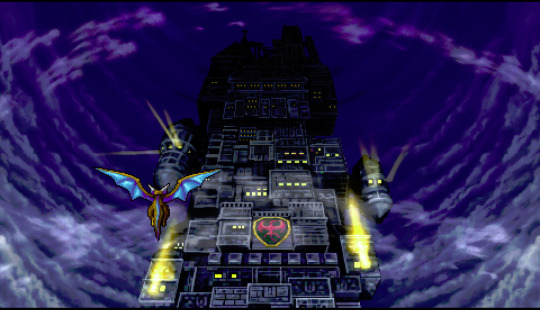
Gameplay: Here’s where things really start falling apart. On the surface, not much the combat doesn’t seem terribly different from Final Fantasy I, with it still being a standard turn based system with basic commands like attacking, using magic, and defending. The big differences in Final Fantasy II’s combat lie in the character progression. The first game had you simply selecting a party of 4 classes at the start of the game, gradually making them stronger across the game by leveling them up and acquiring specific equipment and spells for each, like pretty much every normal JRPG. FF2, on the other hand, uses a much more complex system. Every party member is capable of using every weapon and learning every spell, in the process abandoning the D&D system of set spell charges and instead introducing the traditional MP system, and characters are not set in specialized classes and roles. Instead, FF2 discards the usual EXP based leveling system, and instead uses a stat leveling system, where the individual stats of each character level up separately depending on the course of battle, and while each character starts with predetermined stats that favor a particular role for them, with enough grinding, you can still reshape them however you wish. This stat growth system would later be used and refined for the SaGa series, and it’s a very ambitious attempt at improving upon the party building system the first game established.
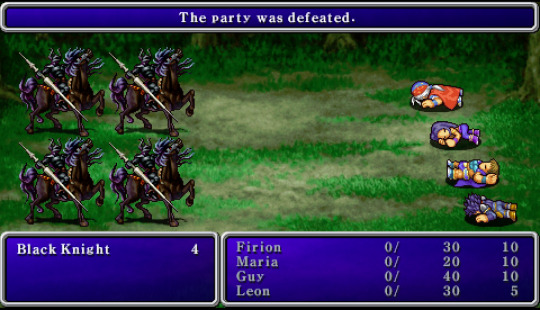
In total, there are 12 main stats that can be increased through battle: HP, your health points, which is raised in regular intervals, or losing HP in battle, MP, magic points that allow you to use spells, which is raised by having MP reduced in battle, Strength, which determines your physical attack, and is raised by using the attack command, Magic, which determines how much MP you get when it is gained, and is raised by having MP reduced in battle, Spirit, which determines the strength of white magic spells, and is raised by casting white magic in battle, Intelligence, which determines the strength of black magic spells, and is raised casting black magic in battle, Stamina, which determines how much HP you get when it is gained, and is increased by losing HP in battle, Evasion, which determines how likely a character can dodge physical attacks, and is raised by being targeted by attacks in battle, Agility, which factors into evasion calculation, and is raised by having high evasion, and Magic Defense, which determines how resilient a character is to offensive magic, and is raised by being targeted by offensive magic in battle.
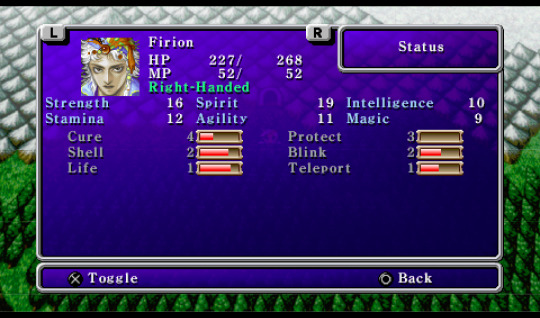
However, it doesn’t stop there, as individual weapon types and spells also have levels that can be raised, which is done so by gaining skill points in them by attacking or casting them during battle. Once enough skill points are gained, they advance to the next level, with the hard cap being 16. Gaining weapon levels allows that character to be more accurate and attack more times at once with that type of weapon, and raising spell levels increases their power and makes them more accurate. Each weapon type, consisting of swords, spears, axes, staves, knives, bows, shields, and unarmed, have different attributes, such as spears being a relatively balanced type, with lower individual power than swords and axes, but higher accuracy, while bows are allow characters to attack from the newly introduced back row, which makes them immune to physical attacks, but prevents them from attacking with any other weapon type. While focusing on one weapon type with each character would seem the most efficient, the game only tends to give you one or two weapons of each type at a time, many of which have good boosts in power or added effects, making focusing on a few different types a decent idea.
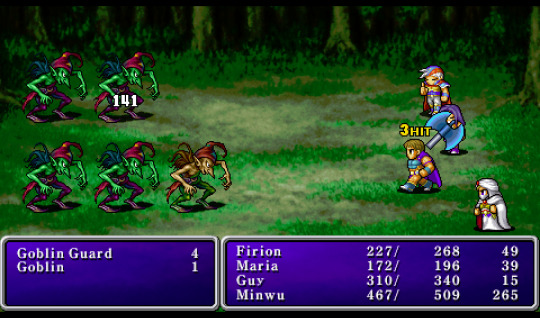
Shields are unique in that, while equipping them doesn’t raise your defense as might be expected, and actually lower your attack, they give large evasion bonuses that makes dodging attacks much easier, and have the chance of blocking a physical attack completely even if something does connect, all of which increases as you gain levels in it. As for other defensive equipment, you have heavy and light types of armor, with light armor giving less defense bonuses than their heavier counterparts, but not weighing nearly as much, and thus leaving you much more evade. As for spells, they start out very underpowered, and have awful accuracy in the case of buff and debuff spells, but become much more effective after a few levels, with the downside of them costing more MP to cast with each level gained. Characters can learn up to 16 spells, and are free to remove them at any time, at the cost of having to level them again from scratch if they ever relearn them. Instead of simply learn spells by buying them in towns, spells are instead learned from tomes, which can be bought from shops, found in treasure chests, or dropped from enemies. Using them on the field teaches a character that spell, while using the tomes in battle instead casts a high level version of the spell, at the cost of losing that tome.
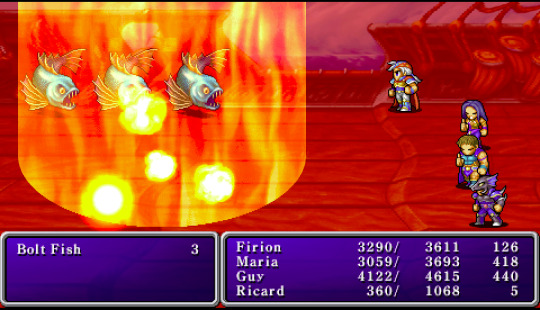
Unfortunately, as creative as this all is, this system has some serious issues. The main one, which you have already guessed, is that the game is incredibly, incredibly grindy because of these mechanics, and in a much worse way than most other RPGs. While not every stat is going to be important for each character, depending on how you build them, there’s still a lot of things it forces you to keep track of. Even if you want to make a dedicated mage, sticking in the back row with a bow for the whole game will leave them with so little vitality and HP that they’ll just be uncomfortably fragile, and with the magic attacks enemies have by the endgame, you really want to keep them in the front row for a good part of the game. Most spells, including important ones like Life and Esuna, for reviving party members and removing status effects respectively, while extremely useful, have such horrible accuracy to start that they’re completely useless before you level them up, and the weapon distribution is quite unbalanced, with swords having easily the best selection even in the midgame, essentially leaving most other types as stopgaps.
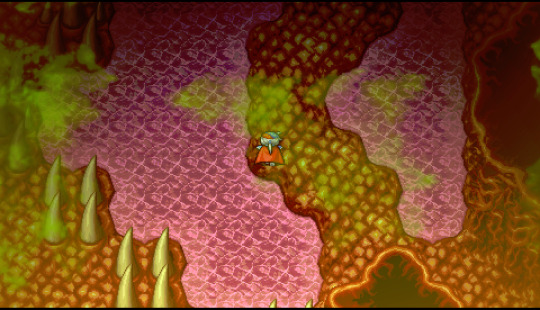
While you might level your important stats a good bit just naturally going through areas, trying to deliberately level any of them is a commitment. While HP, strength, spirit, intelligence, and magic defense tend to come easily enough, increasing stamina often only happens through the loss of a large chunk of their maximum HP, which, obviously, preferably doesn’t happen on a regular basis. This goes likewise for MP and magic, which is rather irritating, as not only do you need more and more MP as your spells level up, but ways to restore MP are extremely limited and costly. The bizarre loop of agility factoring in to evasion increasing, while itself only leveling up based on your current evasion, means that the only reliable way of increasing either is to equip the lightest equipment you have. While leveling up weapon levels is easy enough, especially since you can dual wield different types at once, leveling up spells is a much slower process, with casting low level spells during random encounters, even those that won’t actually help at the moment, often being one of the only feasible ways to get them leveled quick. You may even be tempted to ignore magic beyond simple spells like Cure because of the individual effort needed, but the game will quickly hammer the importance of magic into you; from the randomly encountered flans and bombs that either have absurd physical defense or tend to explode if not fully defeated in one turn, with magic being the only reasonable way to take them out, to mandatory bosses that hit quite hard, and also have enough physical defense to make physical attacks nearly worthless without absurd grinding, you’re not getting through the early game without dedicating some time to magic. On the flip side, another early dungeon has a boss that outright absorbs magic, making physical attacks the only way to beat it.
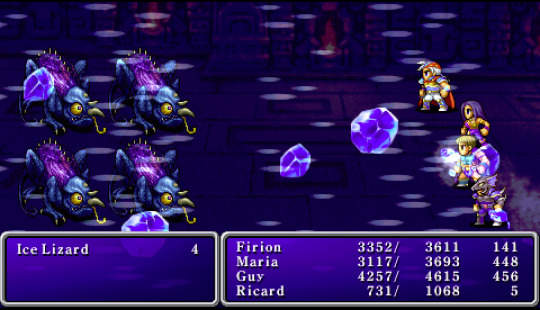
The game has quite a reputation for being brutal, and it’s not inaccurate, with most dungeons being more than glad to beat you down without remorse, and there’s tons of troublesome enemies to be found throughout the game, doubly so if you try to go for all the treasure chests in the area, as many of them are guarded by encounters called monster-in-a-box, which are often much more powerful than other encounters around. Most bosses are more than happy to make your life miserable too, especially the infamous Lamia Queen and Behemoth. However, this difficulty is in no way fair or well designed. While the growth system can easily leave you unsure as to whether or not you’re prepared for a dungeon, since you have no easy guideline to go off of compared to standard leveling, that’s not even the worst of it. The design of the dungeons, and even the world map, are horrible. There’s tons of doors scattered throughout pretty much every dungeon, and 90% of them lead to dead end rooms with raised encounter rates. There is absolutely no way to tell which doors are dead ends and which are necessary to progress, so you’re reduced to trial and error, which is extremely exhausting when there’s so many doors per dungeon, and you’re almost guaranteed to get into an encounter before you can leave each one, and if you’re tempted to ignore any doors when they don’t seem mandatory to progress, in many of those cases, there’s treasure rooms hidden among them, once again with no way to figure out other than guessing.
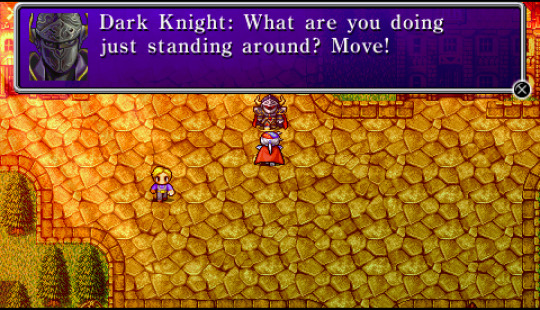
The world map, on the other hand, is one of the best arguments against open ended world design there is. Compared to the first game, there are almost no physical obstacles barring where you can go, other than a few rivers that are only crossable by canoe, something you get almost immediately, and a few areas only accessible by boat. Instead, you’re kept out of where you’re not supposed to be through the Dragon Quest 1 method of having the random encounters kill you horribly. The problems with this method are twofold: not only are the borders between where you’re supposed to be and where you’re not very thin, to the point of running into late game enemies just outside of the first town if you go just a biiit too far to the left, compared to Dragon Quest 1 often using bridges as visible borders between areas, but it just doesn’t really fit with how the game is designed. Dragon Quest 1′s pacing is rather relaxed, as while you do have plot objectives, the game doesn’t rush you to fulfill them. You’re meant to just hang around the areas you can survive in, grinding your way up and getting whatever equipment you need until you feel confident to move onto whichever area seems to be designed for next. In Final Fantasy II, you’re constantly being sent back and forth between areas to get new orders or do whatever the plot wants of you at that moment, but while the game loves telling where to go, it’s pretty bad at telling you how to get there, with its often vague directions being spread out between NPCs in multiple towns, to boot. While there is a map of the overworld you can access, it can still get pretty annoying having to meticulously check where you’re going, and you’re still liable to being decimated just because you wandered into a harmless seeming area. One nasty example comes after completing Kashuon Keep, not too far into the game. You’re expected to head back to Altair, which is on the other side of the world and is quite a bit of a walk, but heading south soon loops back to the Altair area, making for a much shorter walk. Trying to put this idea into practice, however, sends you across the large Palamecian desert, full of enemies more than eager to tell you that this area is still a few dungeons away from being accessed. It’s not completely unsurvivable, and can be safely traversed by finding the nearby hidden Chocobo, but it’s still a nasty situation after a very irritating dungeon.
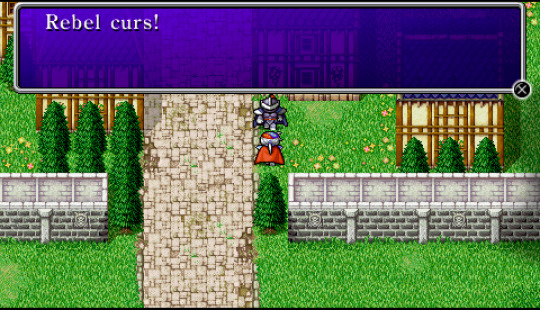
The biggest, and most frustrating, source of difficulty, however, is that the game stubbornly refuses to tell you anything about what’s going on behind the scenes. There’s so many mechanics left unexplained that cause a lot of difficulty if you don’t understand them. For example, every enemy has a stat called rank, which determines how many skill points for your weapons and magic you’ll actually get by using them on said foes. Essentially, if your weapon or magic levels are higher than the enemy’s rank, you need to use that weapon or spell more times in that battle based on the difference between the numbers to actually get any skill points. Not an unreasonable system, and you can view every enemy’s rank in the bestiary, but the game never directly addresses this, and even the most powerful enemies only go up to rank 10, effectively softcapping your skills and spells at 10, which often leads into having your party attack each other to bypass the entire mechanic, a depressingly efficient solution most of the time. Other stats the game never cares to explain are evasion and magic defense, which both display both numbers and percentages. For evasion, the number represents the number of attacks that character is capable of dodging, as physical attacks strike multiple times per round, and the likeliness of evading each attack. With magic defense, the number represents the number of attempts at avoiding a status effect can be made, and the percentage represents the chance of successfully doing so. Despite the name, the stat does not reduce damage taken from magic attacks.
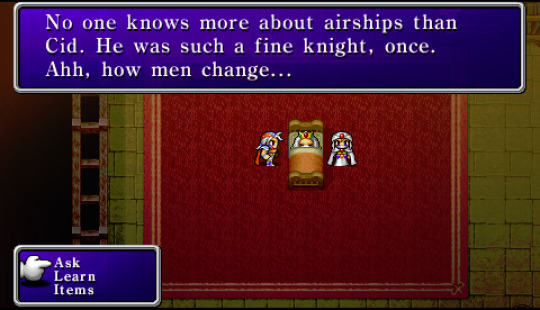
On the subject of magic, the spells available to you are also plagued with unneeded complexity and vagueness. First off, the descriptions for many spells tend to only give you the barest idea of what they actually do; Aura “Enhances effectiveness against various foes.” It never tells you what enemy types count, or that it only becomes effective against certain types as its level increases, you just have to hope that it’s working whenever you use it. Barrier “Raises a barrier to defend against special attacks.”, again giving you no indication as to what it’s actually protecting against. Shell and Wall both claim to raise magic defense, but give no obvious indication how they’re actually different from each other, and Dispel claims to remove protective magical barriers, which lowers the target’s magic defense, even though you may infer that it removes buffs, like in later games. Other spells tend to be redundant or very situational. Basuna removes temporary status effects, compared to Esuna removing permanent status effects, which is near worthless since not only do temporary effects wear off after a number of turns, but they go away after battle regardless, and are rarely effective enough to waste a turn removing. Fear increases the likelyhood of enemies fleeing battle, which is not only rare to actually work, but is worthless, since you don’t get any credit for defeating any enemies that do flee. Sap reduces the MP of the target, which is not only rarely likely to work, but counterintuitive if you have the infamous Osmose spell, which saps large amounts of MP while restoring the same amount for the user. Status effects also have different elements to them, namely body, mind, and matter, with most enemies having different resistances. Some spells, like Stop and Paralysis, have the same effect, but different elements, and keeping track is both difficult, both remembering which spell is which element, and what enemies are actually affected by each element, and nearly pointless, since the effects are rarely worth bothering with in favor of just attacking. Matter elemental spells, however, are rarely resisted by most enemies, even bosses, and mostly comprise of instant death spells like Mini, Break, Teleport, and most infamously, Toad. Not only does this game make instant death spells effective, it makes them downright overpowered, with almost every encounter being capable of being solved through judicious application of Toad.
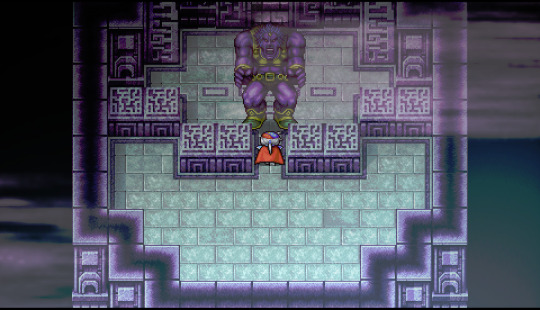
But the peak of all this is a special property that some enemies, like ghosts and the final boss, have applied to their physical attacks: a draining effect that not only restores their HP by the amount of damage inflicted, but specifically inflicts 1/16th of the target’s maximum HP per hit, with them eventually attacking 8 times per turn by the final dungeon. To sum this up simply, this makes heavier equipment worse than worthless. Not only will the defensive power do nothing to protect from this damage, but it actively weighs you down and destroys your evasion, guaranteeing you’ll take all those possible hits unless your did some extreme evasion grinding. You’d be protected better by not wearing anything at all, because at least then you’ll make use of all your natural evasion. Unless you want to constantly heal your characters for half their health everytime you run into specific encounters, you have to dedicate a lot of your time, or most of your run through the game, to getting their evasion leveled enough that this isn’t a problem. Knowing this can be the difference between fruitlessly blowing all your resources and breezing through effortlessly, and there is a certain weapon, the Blood Sword, that has this same draining effect, which can singlehandedly annihilate the final boss once you’ve figured this out. While there’s a few other smaller issues, like several encounter formations that cannot be ran from for no apparent reason, other than possibly being formations used in certain monster-in-a-box encounters, those are the main issues, and being aware of them, and having the information to circumvent them, makes the game much, much easier. If anything, it makes the game extremely breakable. From physical attackers that dodge everything thrown at them, to spellcasters that can wipe out encounters with a single cast, it doesn’t take much to erase the difficulty once you know what you’re doing.
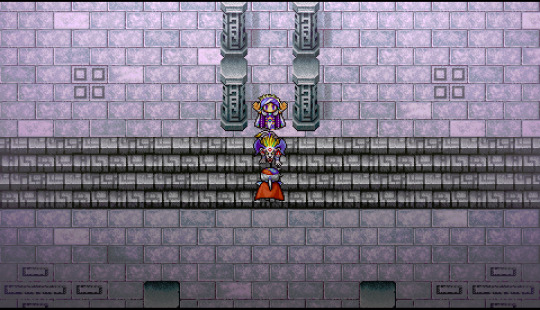
As for bonus content, there’s Soul of Rebirth, a bonus mode unlocked after completing the main game, first added in the GBA version, which focuses on several characters who die in the course of the story finding themselves in what they think is the Jade Passage, the path to Hell. While a cool concept that has a really neat final boss of its own, namely the light side of the Emperor, who split off from his dark half after death and instead took over Heaven, it still has issues of its own, namely that most of the party are guest characters in the main game, and carry over the stats, equipment, and spells they had when they left the party, meaning if you didn’t bother training them and stripped them of all equipment before they departed, you’re in an absurd time. The mode is also quite short, and only consists of two dungeons that are just mirrored versions of the final two dungeons of the main game and a town. A neat addition, but not much more than that. Other than that, the only optional content to find in the main game is the Arcane Labyrinth, a bonus dungeon added specifically for the PSP release. The game uses a keyword system where you can learn important terms from NPCs, and ask about those terms to get directions or a bit more plot. It’s sort of neat in concept, but in practice it doesn’t amount to much other than make it slightly more annoying to find out what to do, especially if you manage to miss a keyword. The Arcane Labyrinth, however, revolves around its use. In order to progress past the entrance, you must select a keyword at the portal to the next floor, which then takes you to a specific floor based around the keyword you chose. Almost every floor has a little sidequest to solve, like defeating specific enemies or giving items to NPCs, which give you new keywords exclusive to the labyrinth, or hints for some of the trickier floors. While they can be kinda annoying to do, you only ever have to complete them once for their reward, and can otherwise run straight to the exit on subsequent visits.
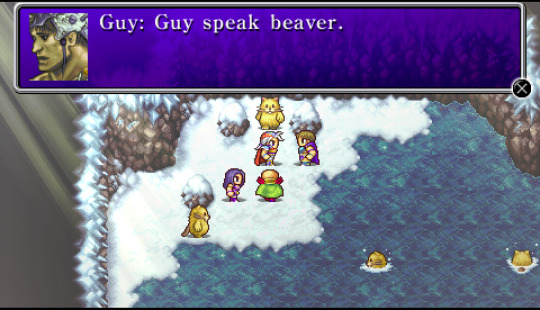
Every floor requires you to select keywords for the next, with 45 different floors being available in total, and the Arcane Labyrinth is actually split into 3 sections, with the northwest section requiring four floors to be visited, the northeast seven floors, and the south ten floors, though while you can’t visit the same floor twice in the same section, you can choose repeats in separate sections. There is much more strategy than simply randomly selecting floors, however. Each keyword belongs to a different category, which cause different reactions depending on your next choice. Picking keywords in the same category in a row cause better treasure to spawn and lower the encounter rate, while picking something in a category that opposes it, such as a matter and materials floor after going through a magic and spirits floor, has the opposite effect. Even more importantly, each playable character has a set of keywords that resonate with them, to varying degrees. This becomes important after finishing all three sections, which unlocks the Arcane Sanctuary. Within is Deumion, the master of the Labyrinth, who summons a superboss, Phrekyos, to test you, with its strength varying depending on how many keywords you’ve gotten through the story, making it beatable even in earlier parts of the game. Beating Phrekyos allows you to get a reward from Deumion; if you picked enough keywords that resonate with a certain party member, you will be able to get their ultimate weapon, which not only have tons of power, but confer massive stat boosts when equipped. If your keywords didn’t resonate enough, you only get an elixir, something that you can buy, albeit with absurd amounts of money. The optimal keywords for the main party are only unlocked in the endgame, but it can actually be worth visiting early for the party members that are used in Soul of Rebirth, as the weapons make it much more manageable, though visiting too early can end with you being much too powerful compared to how you should be. A special set of keywords also allow you to see Deumion’s past, leaving you able to either peacefully receive from him the Revive spell, or fight him as the ultimate superboss for the Destroy spell. Both are disgustingly impractical, but it’s a neat idea nonetheless. Overall, the Arcane Labyrinth, though still rife with its own set of frustrations, is actually one of the more enjoyable bonus dungeons I’ve come across, with a very creative concept that actually leaves you curious as to what the next floor could hold.
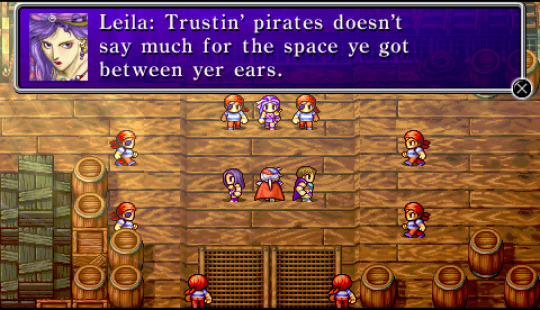
Overall, while the gameplay of Final Fantasy II has some interesting ideas, it’s held back by an irritating lack of explanation as to how it works, the overly grindy design, and just plain poor design and execution. It’s a miserable experience that makes even other early JRPGs seem appealing, just because their grinding is so much simpler to handle, and I need to note, this is the most polished version of the game. Between bugs, a horribly limited inventory, and even more absurd design decisions, like stats sometimes decreasing instead of increasing, or weapons massively decreasing magic accuracy, and increasing skills taking even longer, any version earlier than the GBA version is even more infuriating and even less playable.
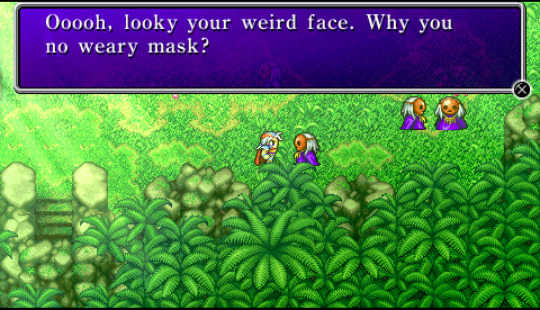
Graphics: Final Fantasy II is actually a quite nice looking game, as with the rest of the Final Fantasy releases on PSP. Locations have a lot of detail to them, like ambient effects like rolling fog, and noticeable lighting effects, with a few areas like Pandemonium having pretty fascinating designs, and there’s some pretty good looking cutscenes for bigger story events. Spell animations are pretty neat, and attack spells have a nice detail where their animations become more elaborate as you level them up more. Characters even finally look accurate to their original art by Yoshitaka Amano, unlike earlier versions, though that’s not necessarily a positive: between Firion’s random mishmash of materials and colors, Maria and Guy’s awkward, half complete outfits, and the terrifyingly gaudy Emperor, this is possibly the tackiest looking cast in the series. The monster designs, on the other hand, are top notch. After Final Fantasy I’s bestiary was lifted almost entirely out of D&D, this game introduced a lot of original and iconic enemies, like the coeurls, the bombs, the malboros, the adamantoises, and the behemoths. It even introduced chocobos, though it’s easy to miss their existence, as their confined to one spot on the world map that’s decently hidden. While there are still a lot of oddities like vampires and giant mantises, it’s still one of the biggest advancements in the series in this regard. The enemy designs also excel in that they look much more threatening than in the first game. These enemies literally come from Hell, and look the part. I’d even go so far as to say that this is the best looking Final Fantasy game on the PSP, and has some of the coolest enemy designs in the series.
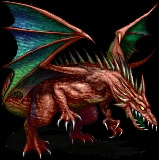
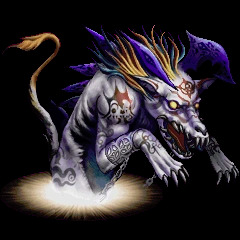
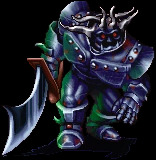
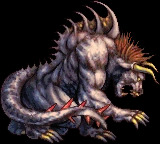
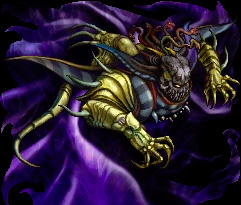
Sound: Final Fantasy II’s soundtrack was composed by Nobuo Uematsu, as usual, and remixed by Tsuyoshi Sekito for the remakes. All things considered, it’s my least favorite soundtrack in the main series. That’s not to say it’s bad at all, and there are some great tracks like the Rebel Army Theme, the somber main theme which plains on the overworld, Ancient Castle, the Tower of the Magi, Battle Theme A, typically used for major boss encounters, and Battle Theme 2, the final boss theme. However, as an overall, it’s just not quite as good as the soundtracks for the rest of the main series, to me. It also contains my least favorite version of the Prelude, being just a bit too high pitched for my liking, and my least favorite battle theme, sounding way too intense just for regular encounters, and quickly becoming grating not too far into the game. The soundtrack is good in its own right, and is worth a listen, it just doesn’t quite reach the heights that some of the others do.
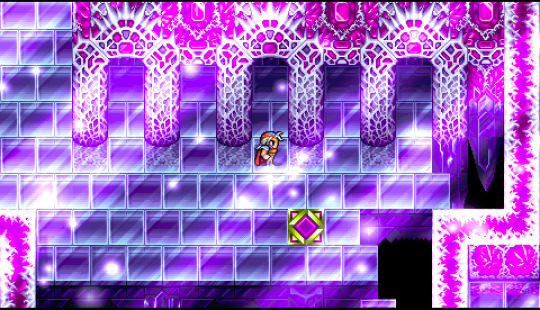
Conclusion: Overall, I give Final Fantasy II a firm not recommended. Though very ambitious and important for its day, its story, design, and mechanics have aged like milk compared to the other Final Fantasy games on the NES. While technically still perfectly playable, especially with deeper knowledge as to how the mechanics work, it doesn’t make for much fun at all. You’re better off keeping your distance from this entry. Now, with this absurdly long review finally done, finishing this game, and the subject of my next review, hopefully to be soon, have convinced me I need a break from older RPGs for a while. Till next time. -Scout
6 notes
·
View notes
Text
Dragons of Summer Flame - A (very sad) review
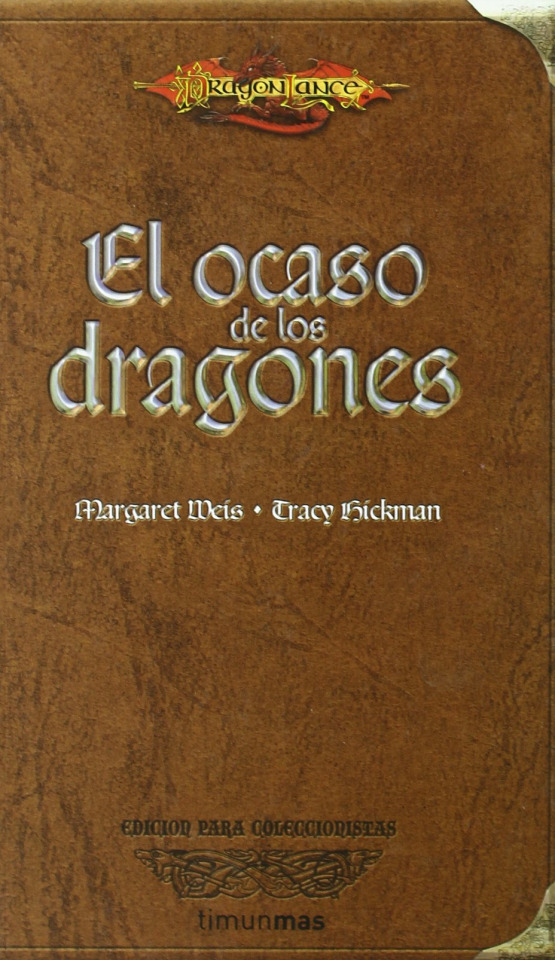
"So you would not apologize to her. You would not ask for forgiveness. What, then, did you want to say to her?" Raistlin was silent long moments. He had turned back to the bookshelves and was staring now at the shadows that surrounded the books, staring at a time that would never happen. "I wanted to tell her that sometimes, in my long sleep, I dreamt of her," he said softly.
Just for this moment, this sad, sad book is worth it.
Why sad? Because after the constant rise that the Chronicles and Legends have been, this closure is a bitter disappointment.
Dragons of Summer Flame is the conclusion of the cycle started with the Dragonlance Chronicles. Honestly, I’ve not re-read the 6-9 books that would go between the Legends and the present one I am going to review - series known as Dragonlance Tales and published as The Second Generation - because I don’t own copies nor did I ever. I didn’t enjoy them enough to buy them. Neither does this one, and it’s in my possession because it belongs to my husband, specifically.
From the Dragonlance Tales, a series of short stories in the style of the Preludes and other prequels and spin-offs, it was only memorable the moment when Palin Majere - younger son of Caramon and Tika and nephew of Raistlin - passed his Test for be a mage. And that's because of the chance of seeing Raistlin again, who’s mostly dead, although the idea that he survived to suffer daily the torture of Prometheus at the hands of his goddess has its macabre appeal. In the end it is just a hoax, like that abomination called Raistlin's Daughter, which I don't know how the authors could have come up with, since it fits the character like a slipper on top of a television.
But let us go to the present volume, Dragons of Summer Flame, a duology that includes The Knights of Takhisis and The War of the Gods in Spain. I said it’s a bitter disappointment, and not because it’s bad in itself - the story’s very original and very well written - but because the authors suffer what I call SAS (Successful Author Syndrome) that has led them, basically, to write a lot of fanservice and pull flashbacks because they already assume that readers will settle for it.
The story revolves around the second generation of the Dragonlance's heroes, that is, their children (or alleged children) and their actions to prevent Chaos, the father of all the gods of Krynn, who has managed to escape his confinement in the Graygem of Gargath, destroy the known world and all gods with it. As I said, it’s not a bad plot. The book rarely gets boring, although it does depending on the section. It has very positive things, such as giving more consistency to the social context, for example, of the city of Palanthas, providing more lore and depth to the story, something that they have rarely done until then. The idea of the evil knights adopting a honor code and polite behaviors to their enemies is also excellent. Not to mention the humor, as good as is always was in this series.

Dragons of Summer Flame. Cover art by Matt Stawicki.
BUT, unfortunately, they take it for granted that, as far as characterization, dialogues and character development are concerned, at this point their readers are unconditional fans and will accept anything. Nope, gentlemen, anything is not enough, no matter how great you were with the Chronicles and wonderful with the Legends. Unforgivable mistakes? Hold my tea:
1. Bring back characters that are already dead. Sorry, but in my modest view, this is a bad author resource. Yes, we loved them, we miss them, but they are dead. Leave them alone. Removing them from the grave is not going to make them better or more lovable. Sometimes the last memory, painful as it is, is the best memory we can have of a character. So leave them alone. The authors abuse visions, flashbacks, or even the physical return (it's a kind of magic!) of beloved characters from the past. Nope, it’s a mistake, because they don’t even play a prominent or relevant role. They are only there out of nostalgia, fanservice and to serve as motivation for the second generation of characters, who are alive. NO, NO, AND NO.
Raistlin was dead, a martyr to his own ambition, from villain to hero in an instant, a living legend forever in Krynn. Why bring him back stripped of his magic, but still suffering his ill health, so that everyone rubs in his face his many past mistakes, suddenly forgetting that he also died because of them? You’re mean, people. Kitiara, Sturm, Flint, they are dead, let them rest in peace, it’s very annoying constantly bringing them back in visions or flashbacks. Even Tanis, who dies in this book, is soon brought back in another vision. Oh, c’mon!
2. The characters of the second generation are not well developed, they don’t have autonomy or their own personality, I don’t get to love them as I loved their parents. Why? Well, because the authors have made them live in the shadow of their parents (or uncle), stripping them from their self-agency.
About Tanin and Sturm Majere I hardly remember a thing, they start the book already dead, and I can't figure out if they were developed much in the Tales. Palin Majere is a shadow of his uncle, poor thing. I say this because there’s nothing wrong with him - he’s handsome, he’s young, he’s brave, he’s kind - and therein lies the problem, he’s a certified Gary Stu. But he lives with the expectations of being like his uncle, all the time compared to Raistlin, which is absurd, because Raistlin is/was incomparable. His evolution isn’t believable, because we know that he’s a mediocre mage - at best - and in the end we see him guided by his uncle, endowed with invaluable artifacts like the staff and the book of Magius, and doing an OP super-spell that hurts Chaos. Come on, please. We are not blind: victory belongs to Raistlin, who’s the one leading him throughout the book. And that final statement that he’s the greatest mage in Krynn? Please. We all know WHO is the greatest mage in Krynn - and poor Palin doesn't even get to the tip of his golden heel.
Steel Brightblade is Sturm 2.0 despite his mother, Kitiara, suddenly super interested in him - although she’s dead - constantly tries to turn him towards evil. Usha "Majere" is really nobody - thank you, glorified authors, for confirming that she’s NOT Raistlin's daughter and fixing this mess a bit - apart from being another Mary Sue who’s only there to be a link between the Irda - practically just taken out of the sleeve of the authors - and the other mortals. Oh, and to be Palin's love interest, of course.
The only decent character is Tasslehoff again, who, thanks to the gods, although more mature, remains faithful to his essence - and then they go and kill him. And how. Life sentence for Weis and Hickman for doing this to him.
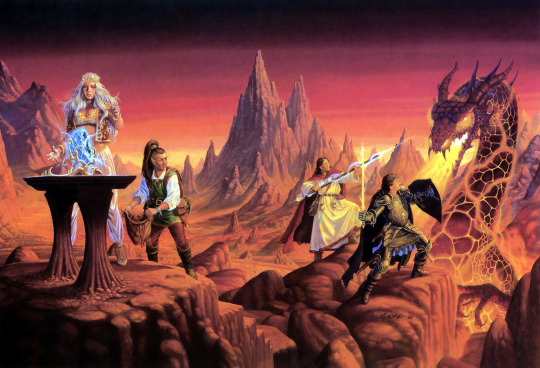
Dragons of Summer Flame. Cover art by Larry Elmore.
3. Flashbacks, repetitions, memories, nostalgia, repeated explanations throughout the same book of events that we already know - and reencounters. Many reencounters. Tense reencounters. Happy reencounters. Reencounters. And the only reencounter that we don't have, the only one that I wanted, that I really needed, never happens - the one with Raistlin and Crysania. Yes, I admit it, it's very problematic. It’s to reunite the victim and her aggressor. Only that a part of me refuses to victimize Crysania, because as Raistlin well says, she knew - mostly - what she was getting into, and besides, Raistlin is totally unrepentant, he doesn't regret anything. But you get to see him reunited with the one that IS his true, real victim - his twin Caramon. In this bloody book full of unnecessary reencounters by mere fanservice, couldn't you have given me this one? Life sentence for Weis and Hickman for doing this to ME.
Anyway, I leave this ranting because I won’t solve anything either. Dragons of Summer Flame, and in general, all the books dedicated to the second generation are an example of why sometimes it’s better to stop writing about the same thing and give rest to your beloved characters. This epilogue, to be honest, was superfluous, better to have closed with the Legends. As a friendly reader out there says, seeing what Weis and Hickman have done to our beloved characters makes you want to shave your head and attack someone's car with an umbrella - only in quarantine I shouldn't and I also like my hair.
SAS. Successful Author Syndrome. When you have succeeded, it’s best to quit. And if you're still going to write more - among other reasons, because the bosses make you - at least leave your dead rest in peace. It’s the golden rule.
Needless to say, I haven't even bothered to read more Dragonlance books from this point on.
#dragonlance#books#margaret weis#tracy hickman#dragons of summer flame#reviews#my reviews#you committed every sin except reuniting raist and crysania#HOW YOU DARE
5 notes
·
View notes
Note
The reason I don't like Hannibal Rising is bc ot takes away the mystery about his past. It explains a character who is better off left without explanation
My post wasn’t actually meant to be that deep but...in all seriousness, I personally always prefer to have more material on a character rather then less, because if there’s something I don’t like or would rather ignore, I can easily do that. If I don’t like something or prefer the mystery I just ignore the canon. I understand where you are coming from and I know “Hanibal Lecter is supposed to be a larger than life villain/monster” or “Hannibal Lecter being inexplicable is makes him such a good villain” was a common argument against Hannibal Rising. On the other hand, it was no secret that Hannibal Rising would give us a backstory so anyone who doesn’t want a backstory, can easily ignore the novel - bc Dragon, Lambs and Hannibal where already out and you don’t need Rising to understand them. Harris didn’t force it on anyone, there is no extra chapter in Silence of the Lambs containing the backstory - it’s a book of its own that was widely marketed as the story of Hannibal’s childhood. When you read the earlier novels it’s pretty clear that Rising and the backstory Harris gave Lecter hadn’t been planned when he wrote them (I know the last time I read all the books one after the other was in 2012 and I read Hannibal Rising last and noticed some contradictions but don’t nail me down on what it was, bc I don’t remember) and personally, that’s something that bothers me more than over-information or too many details - lack of consistency. That’s why I, personally, prefer to have a backstory for a character in mind when I write them, even when I don’t disclose it or just give a few hints and let the audience fill in the blanks for themselves. It’s something that helps me keep a character consistent and to lend weight to their actions and decisions. There are great villains and characters who’s backstory is never explained - and who become scarier for it and I think at the end of the day, it definitely has to do with personal taste. There are also poor examples. There was a lot of debate on Tumblr lately about “spoiler culture” and stories that only work through plot twists rather than actual stakes and developments and personally, the same thing can be said about villains - because villains are always part plot-deviced, no matter how well they are conceived.
They are always the antagonists and have to keep the plot going. There are villains that are basically walking plot-twists. And while they may be exciting and keep us and the other characters on our toes, they have little substance. If you look closer, they only consist of quirky traits and sudden changes of mind with little substance. They are fun but forgettable. They are the opposite of fleshed-out. A character whose not fleshed out has a backstory, motivation, and a moral alignment, but no traits or personality or interests or interesting quirks or feelings. Villains that only have personality and quirks and plot-twists lack a skeleton - something that gives them consistent a motivation and moral alignment. It does strip them somewhat of their mystery and maybe even makes them less scary - but in my opinion, it makes them more interesting and, I think Hannibal is an excellent example of that - it doesn’t make them less scary or effective. We know that Harris looked at actual serial killers as role-models for Lecter. And maybe it’s lack of creativity on my part, but before Hannibal Rising came out, my mind usually wandered to those people, Ted Bundy etc.. And personally...I always felt like that corroded the mystery far more than any actually tragic dark backstory I could come up with, because...I find these biographies are pathetic and mundane whenever I read up on them. So it didn’t bother me much when Rising gave Hannibal Lecter a backstory different from what I had assumed until then. That said, for me personally, Rising as a story is very separate from the rest of the series. I don’t even have Rising in mind when I watch Silence of the Lambs or Hannibal. And Hannibal Rising doesn’t need Hannibal Lecter as the main character to be an interesting story. I probably would have bought it even if it wasn’t about Hannibal. Of course, knowing how Hannibal is going to turn out impacts the way the audience reads this story, but it might actually be interesting how people experience the novel and the main-character if they hadn’t known how he’s going to turn out. But either way, in the setting of Hannibal Rising, he isn’t yet the Hannibal Lecter we know from Lambs or Dragon. Personally, that’s maybe where I would draw the line. I don’t want to read “Hannibal Rising 2″ or “Hannibal Rising 3″ or “Red Dragon the Prequel.” I don’t need to see the entire path between adult Lecter and child Lecter mapped out and maybe that’s also rooted in a certain desire for mystery, but for me, child!Lecter is so far away from Red Dragon-Lecter that I don’t feel it gives us too much information.
Rising could have been a singular story - and that was mostly how my post was intended, anyway. That Hannibal Rising wasn’t a bad film or a bad book. It’s definitely legitimate to debate what exactly this story adds to the Hannibal Lecter trilogy, but it doesn’t affect the other books and while it did affect the TV series, there it was drastically changed bc they couldn’t place Hannibal in a WW2 setting.
The film had a trailer and the book and a summary that was publicly available. No one was tricked into reading/watching it and therefore I’m a bit annoyed at the dislike it gets for its mere existence. Imo it’s honestly very simple: You don’t want to know a backstory for Hannibal Lecter? Don’t read the book about Hannibal Lecter’s backstory or critique it. You want a backstory for Hannibal Lecter? Sure, read the book, watch the film - and then tell us if you liked it. It’s perfectly understandable if someone reads Hannibal Rising and doesn’t like the backstory it gives him, points out the inconsistencies or dislikes the implications of the story or the pacing, writing, presentation, setting - whatever. Those are absolutely fine to critique but I get the sense that many people are just annoyed that this book and this film exist at all and not about the story itself or how it is presented.
11 notes
·
View notes
Text
BattleTech: The Star League - an exercise in advanced Fridge Logic
“I’ve considered “BattleTech: Star League” an all-time great sourcebook. It tells the origin story of the whole BattleTech universe up until the First Succession War. It also explains the full story behind General Kerensky’s Exodus, a major plot point repeatedly referred to in books, finally detailed.
Back then when I got the book originally in the 90s I might not have really known that this was a setup to follow up with the Clan Invasion era of BattleTech. Or maybe I personally got it after that had already been launched. When it was released in 1988 the timeline shifted into the Fourth Succession War and there had been release referring to that mythical Star League.
Some books don’t fare as well when being re-read decades later, and “The Star League” is not an exception, though I have to admit I might be applying impossibly high standards...
Don’t think about it too hard
One talks of “fridge logic” when you set a piece of fiction aside, go to the fridge, and realize that the inner logic of the work does not quite add up. The point of fridge logic is that it is sufficiently convincing to keep you absorbing a piece of fiction but you might end up taking it apart later.
I’ve also been re-reading the Warrior Trilogy by Michael A. Stackpole and reminiscing about “Heir of the Dragon”. While Stackpole’s novels about the Fourth Succession War lay out a template for other BT novels, they also skew the setting heavily, completely upend its balance. “Heir to the Dragon” contrives as hard as it can to construe a War of 3039 that restore the setting balance long enough for it to persist until the events of 3050 - the Clan Invasion. In hindsight that book is full of fridge logic it seems unfair to call out “The Star League” but here I am.
It’s any author’s prerogative to time situations to maximize drama, to have events happen in a convenient way, to maximize the impact of a work of fiction. If there is too much of that with events happening all-too-convenient, we talk about a “deus ex machina.” The authors of “The Star League” (SL from now on) were trying hard to avoid that and to have a string of logical-seeming events follow like pearls on a chain. But when you look too close, it all comes apart...
Setting and world design can often become subservient to requirements of the plot. As I said, SL tries hard to avoid that, but it doesn’t quite accomplish it. The events I will focus on are the Periphery Uprising and the Amaris Coup (also names of chapter headings). These are part of the climax and are supposed to explain the downfall of the marvelous Star League itself.
What is needed?
The SL was the most advanced golden age of mankind, but the standard setting of BT in the 80s was an era of technological decline and petty scuffles. The challenge for the authors was to explain not only the rise of such a realm but describe its fall in a way that the downward spiral seems inevitable.
The original realm at the heart of human-occupied space, the Terran Hegemony, had to vanish through the course of events because the map of 3025 existed long before the map of 2781. For this to happen it was not enough to let a line of royal succession end, a whole realm had to collapse. Also, the end of the SL had already been blamed vaguely on treachery and so the story of that treachery had to be set up.
Furthermore, the fall from glory was a great opportunity for memorable drama, the end of a golden age, after all, and the preclude for centuries of war.
There was only one problem: the SLDF.
The Star League Defense Forces were not only the most advanced but also basically the biggest fighting force in the BT history, led by brilliant General Kerensky. You cannot set that up and then hand-wave your way out of that setup. But the authors kind of did.
The basic plot points of the Periphery Uprising
The Periphery realms are exploited by the Inner Sphere lords and businesses for their own gain, resentment builds.
The ruler of the SL dies, orphaning his son. General Kerensky is named Protector of the Realm and the young lord his ward, but circumstances pretty much prevent the general from executing any of these duties.
Stefan Amaris, the leader of the Rim Worlds, conspires with other Periphery governments to ultimately achieve independence.
He befriends the future lord of the SL, a lonely minor and orphan. He proceeds to manipulate the young lord and gain influence over him.
A tense stand-off between the SLDF and Periphery rebels develops, including terrorism against the SLDF.
Suddenly 50 full mech divisions of fighting force appear that have been secretly built up and end up destroying almost as many divisions of SLDF forces scattered throughout the periphery. (There’s roughly 100 divisions of the SLDF in the periphery according to the book.) Where they cannot defeat the SLDF directly they drop prohibited nuclear bombs and move on.
[EDIT: To put this number into context: “ At its peak prior to the Clan Invasion, the AFFC represented the largest single military since General Aleksandr Kerensky took most of the Star League Defense Force beyond the Periphery, with over 268 BattleMech regiments.” (from: sarna.net) In the BT universe, according to the same source, a division is made up of 3 brigades, and a brigade of 3 regiments. Even if we assume that only 1 out of 3 brigades in a division is a mech brigade - after all a tank division does not consist entirely of tanks! - we still might be contemplating 150 mech regiments - a bit less than the Draconis Combine at the beginning of the First Succession War. Supposedly the Draconis Combine was involved in providing those mechs. Would they supply as many as they have themselves out of pure greed??]
Meanwhile Amaris’ Rim Worlds are suspiciously peaceful and the young lord calls in Amaris’ troups to protect the Hegemony as more and more troops of the SLDF leave it to fight in the Periphery Uprising.
In the final act, Amaris personally murders the young ruler, abusing his trust, and lets his troops enact a coup, almost completely overcoming the unsuspecting local forces (which they outnumber 2:1).
These are the events that earned Amaris the “honorific” the Ursurper and the events that follow see the destruction of the Hegemony in the liberation campaign, ending with a drive for freeing Earth itself and killing Amaris.
Why it doesn’t work
The bigger a conspiracy is the more likely it is that somebody talks. Supposedly the conspiracy involved...
the governments of all four periphery realms,
the members of dozens of independence movements spread over 1,000s of light years,
the militias and their many thousands or more members,
the personnel of half a dozen major merchant companies,
most of the military of the Rim worlds,
the members of those 50 divisions, and
their mercenary company trainers.
We are supposed to believe that the SL intelligence services were not capable to undermine a conspiracy numbering in the millions, that nobody went rogue, nobody talked. None of the Rim Worlds soldiers ever got drunk and said too much to a local during a night of debauchery of any kind. Nobody ever went to the authorities.
Not only that, all these people either enlisted in the plan or kept quiet for money.
The SL is concerned where certain shipments of battlemechs are going but cannot squeeze it out of a single crew member even though they know who handled the shipments.
Amaris explicitly betrays a major independence movement but everyone else sticks to the plan.
There is enough black money moved around to fund not only the independence movements, but 50 divisions of battlemechs and more. The equipment is bought, so is the silence of those transporting it, and finally these people are trained in the Deep Periphery for years - which means building bases to host them on unsettled worlds beyond realm borders, requiring a constant stream of resources to sustain them.
Nothing of that left a trail for SL intelligence to follow?
We’re talking sums of money probably equivalent to the budget for the SLDF because these troops have to be created anew. In other words, vast amounts. How do the governments change their spending unnoticed? The SL does not do basic accounting? [EDIT: According to sarna.net the SLDF at its peak fielded 125 battle mech divisions. This is the result of 1 1/2 centuries of military spending. The Periphery governments are supposedly capable of creating 40% of that force on-the-fly with a training program hosted by a few mercenary units. How can you effectively train so many soldiers, especially to fight as large formations, without having an organization to match the SLDF or a major house military? It’s doubtful any Inner Sphere lord could match this feet - because they never have. If this was easily possible, why not double your own forces “in secret?”]
And here’s the worst part: It is established that the periphery is actually being exploited by the Inner Sphere for their own gain, so this major spending comes while essentially massive amounts of riches are funneled away anyway, in times of exploitation.
Does this really make sense? Do people take part in a scheme that takes a decade to unfold, including five years of separation from loved ones for many of them? Can the personnel of 50 divisions really be hidden in the ranks of staff of half a dozen transporting companies?
(Also: Take for example the American War of Independence. Roughly a third of the people of the Colonies were Loyalists. Even in occupied populaces resenting their occupiers you would have some people actively collaborating with their oppressors. Even more - many periphery worlds owe the SL for either being settle-able or for making their lives a lot easier through things like cheap water purification technology...)
More fridge logic
Other facts that have been established:
The SL has entrenched its troops in fortifications in the periphery.
The SL doctrine for fortifications is to enable troops to strike from hidden exits, not to lock itself in or simply concentrate its forces.
The prime fortifications of the SL, “Castles Brian”, are under mountains and underground with many tunnels and hidden exits.
So, can the rebels simply drop nuclear bombs on these guys “and move on?”
They can’t. These devices don’t raze mountains. Also you need a delivery vehicle. These fortifications should have had anti-air defenses, but even if not or if ineffective against the chosen delivery vehicle, they are still hidden behind tons and tons of rock.
The popular image of nuclear bombs is of an all-destroying force but this is not accurate. Militarily the stopping power of a nuclear bomb has been established and for use against armored forces like tank divisions the actual kill zone is rather small - like a third of a mile in diameter if I remember correctly. Take then into account that battlemechs are better armored and secured also against radiation than modern armored vehicles and they can even be made to operate in the vacuum of space. (And space and radiation go together...)
Furthermore, given that terrorist strikes have been an tactic mentioned within the same pages I’m covering here, including suicide attacks and a localized nuclear strike, which SLDF commander would not spread his or her forces to the best of their abilities to avoid vulnerability?
Thinking this further, the SLDF is operating in enemy territory - these people are bombing their own land. So they just blow up a few megatons next to their own population centers? Ignore the fallout on civilians that are entirely their own population??
It quickly becomes clear that this “tactic” is more a plot device than anything. These rebels are so unscrupulous and amoral, they can resort to things the SLDF wouldn’t do and therefore best it easily. This supposedly explains away all the advantages the SLDF enjoy - their stockpiles, technological superiority, fortifications, advanced training and doctrines, even the many years of actual combat experience.
The same plot device is used in how Amaris’ Rim Worlds troops eliminate resistance in the Hegemony. Now there’s less inhibition to use such weaponry given these are not their home worlds. But the other conditions still apply - especially since many of the Hegemony worlds explicitly have Castles Brian, and many several.
And regular plot convenience
Other things like the automated defense systems of the Hegemony were simple plot convenience, there to be ironically used against those that hoped to enjoy their protection. This helps explain the bloody and protracted campaign need to win the Hegemony back.
The Amaris Coup’s basic design depends on many things - including...
the greed of the Inner Sphere lords completely clouding their self-preservation. After all they sell materiel to staff 50 mech divisions when originally the presence of a single mech battalion in one periphery realm was almost a casus belli.
the continued cooperation and secrecy of all participants during the decade where Amaris unfolds his plan to win Richard Cameron’s confidence. What was the backup plan if that wasn’t possible?
the complete lack of anyone else caring even a little about Richard Cameron, like Kerensky doing his actual duties during this time period, especially given the fact that he’s supposedly meticulous, dutiful, and virtuous without measure.
the administration of the Hegemony not developing the least of initiative.
that the Kerensky reforms made the SLDF so dependent on his leadership he couldn’t delegate this duty to anyone else. What kind of genius makes themselves unreplaceable and traps themselves in a situation where they cannot serve their duties?
that nobody notices Amaris deploys double as many soldiers to the Hegemony than he originally stated. So nobody noticed the extra beds, extra meals, extra vehicles, extra battlemechs? Did half of them hide in the toilets and get their half-meals shoved under the door? These troops were housed on Hegemony territory and supplied by the Hegemony administration. How do you pull off such a sleight-of-hand?
We’re actually closing in on “deus ex machina” quick. Yes, such big plots are often contrived. But there is a measure, and if you look closely, this book does not come together as well as it seems.
Conclusion
Just as Kerensky’s Exodus, it’s best not to think too hard about how all of this is even possible or all unravels. It’s both disillusioning and concerning that this is still one of the best setting books I have ever read. For all its flaws it creates really a lot of good lore and has an engaging plot.
This is kind of what to expect when the broad strokes are already made and somebody has to fill them in. Kerensky’s Exodus or the sudden fall of the SL were outlined, and filling in the gaps makes kind of clear that this was a tall order. The book mostly succeeds, even. It just has to perform a few sleights of hand too many to get there...
[PS and foot note: I’m currently reading also bits of “BattleTech: Explorer Corps”. When reading about ComStar Primus Simms’ visions I noticed that in the BT universe if somebody has visions they are usually accurate and plot-relevant, linking plot elements without apparent cause. In “The Star League” one Cameron predicts the end of the Terran Hegemony, for example. Such visions usually revolve around elements whose meaning is clear in hindsight, like Simms’ seeing “visions of monsters” who really are the symbols or emblems of invading Clans. If we add Stackpole’s foray into a mystical duel between mech warriors defying scientific explanation (in the Warrior Trilogy between Yorinaga Kurita and both Kell brothers, Patrick and Morgan). From this we can conclude that deep down the BT universe has a supernatural element.]
2 notes
·
View notes
Link
Now available for order from our partners at Indie Press Revolution: Beckett’s Jyhad Diary Deluxe Edition!
It’s ever been a loaded word among vampires. Jyhad is in force everywhere from lofty, perfumed Elysium to cloying, smoke-filled blood feasts. Jyhad’s the eternal game played by elders, Methuselahs, and worse — it’s the agenda of beings so utterly beyond humanity, one such as yourself could scarcely understand its movements.
Luckily for you, you’ve picked up a copy of my diary. With my help you may just take a step on the first rung of understanding. Information worth having is information you must earn through blood, and oh, how I’ve bled for what’s contained within these pages.
— Beckett
Beckett’s Jyhad Diary serves as the definitive book of setting and plot for Vampire: The Masquerade, containing 30 chapters spanning different geographical regions, encountering vampires of every clan, profiling obscure and profound segments of the mythology, and providing countless story hooks on every page.
Masterfully written by the likes of Neall Raemonn Price, Joshua Alan Doetsch, Myranda Sarro, Steffie de Vaan, Malcolm Sheppard, Alan Alexander, Renee Knipe, and Matthew Dawkins, Beckett’s Jyhad Diary is as fascinating to read as to use for your game Chronicles.
Also available for V20: Beckett’s Jyhad Diary V20 Storyteller’s Screen and Vampire: The Masquerade 20th Anniversary Edition Dice! The screen is a sturdy three-panel foldout with pertinent charts and quick-reference information for V20 games. The dice are, made by Q Worshop, are elegant grey-and-black featuring the numbers 1 through 9 in the familiar Vampire title font, and the V20 ankh taking the place of the 10, surrounded by thorned rose vines.
Also available: Changeling: The Dreaming 20th Anniversary Edition Deluxe Edition!
Judge us not by our seemings for we are never what we appear. Come hither, changelings and join the dream-dance, lest the winter come and the Dreaming pass into memory.
Recall your heritage! Let the games begin!
Twenty years ago, White Wolf published Changeling: the Dreaming, the fifth of their promised five game-lines that together comprised the World of Darkness. Seen by some as a lighter, more fantasy-based setting in the modern-day, and by others as the darkest game White Wolfhad yet created, players had to face the question of what happens once creativity and magic fades from their world.
This 20th Anniversary Edition of Changeling: the Dreaming returns to that deceptively bright yet terrifying world and both compiles and completes the concepts of the previous two editions. Led by veteran White Wolf and Onyx Path developer “Blackhat” Matt McFarland, our writing team consists of longtime Changeling creators like Ian Lemke, Jackie Cassada, Nicky Rea, and Peter Woodworth, as well as familiar names such as Holden Shearer, John Snead, Maggie Carrol, Matthew Dawkins, and Krister Michl. One and all are dedicated to making Changeling: the Dreaming Twentieth Anniversary Edition the most playable edition yet – while not losing the wonder, awe, and majesty that Changeling is known for.
A revised and up to date look at the World of Darkness through the eyes of the Kithain – what has happened to the Dreaming in the last 20 years, and what is the state of Glamour and dreams?
Rules for all of the kiths including in 2nd ed, plus fan favorites from other books: selkies, piskies, clurichaun, and both Arcadian and Concordian sidhe.
Rules for the Gallain: The inanimae, the hsien, the Nunnehi, and others!
An overhauled and reimagined system for fae magic, including new Arts and the powerful but dangerous practice of Unleashing!
New full-color beautiful artwork as well as classic Changeling illustrations including remastered full page pieces of the kiths by Tony Diterlizzi.
Also available for Changeling: Changeling: The Dreaming 20th Anniversary Edition Storyteller’s Screen and Changeling: The Dreaming 20th Anniversary Edition Dice! Like the screen above, this is a sturdy three-panel foldout with useful reference information for Changeling Storytellers. The Q Workshop dice display the numbers 1 through 9 (with the signature Changeling luna moth on the 0 face) placed in a stained glass motif.
For more about our partnership with IPR, please see Rich’s recent Monday Meeting Notes.
Kickstarter Update
Our next Kickstarter is going to be Lunars: Fangs at the Gate for Exalted 3rd Edition, coming up on February 12 at 2pm Eastern!
Did you miss one of our previous Kickstarters? The following Kickstarted products are still open for preorders via BackerKit:
Dystopia Rising: Evolution: Dystopia Rising: Evolution rulebook
Scion: Scion 2nd Edition (Origin and Hero)
Trinity Continuum: Trinity Continuum (core rules and Trinity Continuum: Æon)
Exalted: Dragon-Blooded: What Fire Has Wrought
Vampire: The Masquerade: V5 Chicago by Night
Chronicles of Darkness: Chronicles of Darkness: Dark Eras 2
Geist: The Sin-Eaters: Geist: The Sin-Eaters 2nd Edition
Community Spotlight
The following community-created content for Scarred Lands has been added to the Slarecian Vault in the last week (to be updated once DTRPG is back up):
Your product could be here! Have you considered creating your own to sell?
The following community-created content for Realms of Pugmire has been added to Canis Minor in the last week:
Calling: Librarians
Your product could be here! Have you considered creating your own to sell
5 notes
·
View notes
Text
Binge-Watching: Zero no Tsukaima S4, Episodes 10-12
At long last, we reach the end! In which we get the coolest final battle yet, things come together in a satisfying fashion, and I bid goodbye to one of the most unique experiences of by blogging “career”.
Wrath of the Ancient Dragon
I’ve mentioned before that one of the more interesting aspects of this season of Zero no Tsukaima has been how unusually loose and unstructured the plot has been. Compared to the long build-up to the inevitable climaxes of the previous few seasons, F has played more like a roadside showcase, traveling to new and interesting locations and seeing how our characters interact with them. It’s an interesting track to take with the final season of your show, but I think it ended up being the right call: free from the constraints of needing an ever-advancing plot, the show was able to take a step back and re-orient itself in the right direction after so much time traveling in the very wrong one. That said, this is the finale of the entire show, and it would be foolish to bid goodbye without some sort of fitting climax.
And god damn, did it deliver.
In a broad sense, the sudden rise of the Ancient Dragon is nothing that special. It’s a villain we’ve never seen before, with no personal stakes invested in our characters’ development; it’s just a massive force of nature that threatens to destroy the world and must be stopped. Thematically, it’s pretty empty. But perhaps that’s fitting for a season that’s been all about just relaxing and not worrying about the big picture too much. After all, the point of this series, from the very beginning, was always first and foremost to be fun. And what this monster lacks in emotional resonance, he more than makes up for in pure spectacle. This is the single coolest villain battle Zero has ever thrown at us. The animation on the massive dragon itself is really damn spectacular; it really feels like a part of the earth itself that was roused from its slumber, big and lumbering and chunky and furious. It goes a long way in selling just what an overbearing menace this thing is. And as it gets more and more battle-damaged, its earthen scales peeling off to reveal the magma core underneath, it only gets cooler and cooler. This is the kind of no-bullshit reveling in fun fantasy nonsense that Zero excelled at back in the first season. This is the spark I’ve been missing for so long.
Should I Stay or Should I Go?
It should be noted, though, that just because we’re getting back to the fun roots of this show doesn’t mean we’ve abandoned all sense of stakes. What really makes this final battle work so well is how consistently the show puts its heroes in peril, adding a welcome level of darkness to the proceedings that befits the gravitas of such a climax. The scene where Derf is shattered by the dragon’s breath might have this show’s best animation of all time, intense and glaring and chaotic, selling the shock of losing one of our oldest mainstays incredibly well. Never mind the literal Pope getting chomped like a piece of popcorn chicken. If there was any way to signal “we’re going out with a bang”, that would be it.
But the real drama is still centered exactly where it should be: on Louise and Saito themselves. There’s something fittingly circular about their conflict in these final episodes: just like in the first season finale, Saito is caught between the opportunity to return to his world and the desire to stay here with the woman he loves. Only this time, there was never any question in his mind which one he was going to pick. He and Louise have been through too much together for him to leave her behind now. And Louise, in turn, has grown up enough to want to prioritize Saito’s safety over her own desires, pushing him into his own world without a second thought when before she kept her feelings too close to her chest. They’ve both grown so much that they find themselves of the opposite side of that same divide, still searching for that middle ground. But in reality, the choice was clear from the start. Saito is, and always has been, the Familiar of Zero. That’s the life he’s chosen. And just like in the season 1 finale, he proves that dedication by flying a fighter jet out of a solar eclipse back into this new world of his new life. The more things change, the more they stay the same.
Good to Have You Back
And with promises upheld and faith restored, there’s nothing left to do but send this show out with one hell of a fireworks display. Once again, all the disparate pieces of the season’s drifting plotlines- the fire orbs, the elves, the Elemental Siblings- come together in spectacular fashion, the show’s impressive interconnected worldbuilding on display once more. The return to the Magic Academy itself also feels fitting: after a season of traveling around new places, we’re coming back home for the final stretch. And after an exhilarating areal battle, we climax with Saito kamikaze-ing his plane into the dragon and Louise finishing it off with the coolest fucking explosion she’s ever pulled, whirling with all four elements in addition to her own void magic in an impressively animated blast of sakuga. There are some very noticeable logical shortcuts at play- Derf somehow being alive, the eclipse conveniently being this very same day, Saito somehow sneaking into a freaking military compound to steal a plane, the complicated way by which his dual Familiar status keeps him alive after exhausting his power- but those were never the point. The point, like I said before, was fun. And on that level, these final episodes have been the best showing this show’s put out in a very long time.
And, of course, after far too much time wasted on backtracking and side-stepping, Louise and Saito finally tie the knot. Again, it’s taken far too long to get to this point, but now that the show’s finally let them be a genuine couple again, they’ve really both come alive. For as fractured as the path has been to get here, the ultimate conclusion really is damn sweet. I imagine his parents are gonna have a metric buttload of questions for him when they answer the doorbell, but I think those two will be okay. At the very least, they’ve certainly earned their happy ending a hundred times over.
Odds and Ends
-”It’s about time you realized you’re a terrible liar.” I REALLY like this new Siesta. Give me the life coach over the third wheel any day.
-So, is the implication here that Julio and the Pope also have a romantic connection? Is that just the fate of every Void mage and their familiar?
-”If only I still had that rocket launcher from last time.” Yeah, very few problems a rocket launcher couldn’t solve.
-”Why is he telling them what to do?” “He likes it.” aksjdhha Ari you drama queen
-Henrietta’s battle armor is stiiiiiil stupid.
-”I hired them.” Tabitha is still cool by me.
Wow, am I finally done with this show? What a time it’s been. Expect my season 4 reflection later today, as well as what show will take its place!
4 notes
·
View notes
Text
Lovecraft Fic/RP Prompts
The Commonplace Book of H.P. Lovecraft
This book consists of ideas, images, & quotations hastily jotted down for possible future use in weird fiction. Very few are actually developed plots—for the most part they are merely suggestions or random impressions designed to set the memory or imagination working. Their sources are various—dreams, things read, casual incidents, idle conceptions, & so on.—H. P. Lovecraft
Presented to R. H. Barlow, Esq., on May 7, 1934—in exchange for an admirably neat typed copy from his skilled hand.
1. Demophon shivered when the sun shone upon him. (Lover of darkness = ignorance.)
2. Inhabitants of Zinge, over whom the star Canopus rises every night, are always gay and without sorrow.
3. The shores of Attica respond in song to the waves of the Aegean.
4. Horror Story. Man dreams of falling—found on floor mangled as tho’ from falling from a vast height.
5. Narrator walks along unfamiliar country road,—comes to strange region of the unreal.
6. In Ld Dunsany’s “Idle Days on the Yann.” The inhabitants of the antient Astahan, on the Yann, do all things according to antient ceremony. Nothing new is found. “Here we have fetter’d and manacled Time, who wou’d otherwise slay the Gods.”
7. Horror Story. The sculptured hand—or other artificial hand—which strangles its creator.
8. Hor. Sto. Man makes appt. with old enemy. Dies—body keeps appt.
9. Dr. Eben Spencer plot.
10. Dream of flying over city.
11. Odd nocturnal ritual. Beasts dance and march to musick.
12. Happenings in interval between preliminary sound and striking of clock—ending— “it was the tones of the clock striking three”.
13. House and garden—old—associations. Scene takes on strange aspect.
14. Hideous sound in the dark.
15. Bridge and slimy black waters.
16. The walking dead—seemingly alive, but—.
17. Doors found mysteriously open and shut etc.—excite terror.
18. Calamander-wood—a very valuable cabinet wood of Ceylon and S. India, resembling rosewood.
19. Revise 1907 tale—painting of ultimate horror.
20. Man journeys into the past—or imaginative realm—leaving bodily shell behind.
21. A very ancient colossus in a very ancient desert. Face gone—no man hath seen it.
22. Mermaid Legend—Encyc. Britt. XVI—40.
23. The man who would not sleep—dares not sleep—takes drugs to keep himself awake. Finally falls asleep—and something happens. Motto from Baudelaire p. 214.
24. Dunsany—Go-By Street. Man stumbles on dream world—returns to earth—seeks to go back—succeeds, but finds dream world ancient and decayed as though by thousands of years.
1919
25. Man visits museum of antiquities—asks that it accept a bas-relief he has just made—old and learned curator laughs and says he cannot accept anything so modern. Man says that ‘dreams are older than brooding Egypt or the contemplative Sphinx or garden-girdled Babylonia’ and that he had fashioned the sculpture in his dreams. Curator bids him shew his product, and when he does so curator shews horror. Asks who the man may be. He tells modern name. “No—before that” says curator. Man does not remember except in dreams. Then curator offers high price, but man fears he means to destroy sculpture. Asks fabulous price—curator will consult directors. Add good development and describe nature of bas-relief.
26. Dream of ancient castle stairs—sleeping guards—narrow window—battle on plain between men of England and men of yellow tabards with red dragons. Leader of English challenges leader of foe to single combat. They fight. Foe unhelmeted, but there is no head revealed. Whole army of foe fades into mist, and watcher finds himself to be the English knight on the plain, mounted. Looks at castle, and sees a peculiar concentration of fantastic clouds over the highest battlements.
27. Life and Death. Death—its desolation and horror—bleak spaces—sea-bottom—dead cities. But Life—the greater horror! Vast unheard-of reptiles and leviathans—hideous beasts of prehistoric jungle—rank slimy vegetation—evil instincts of primal man—Life is more horrible than death.
28. The Cats of Ulthar. The cat is the soul of antique Ægyptus and bearer of tales from forgotten cities of Meroë and Ophir. He is the kin of the jungle’s lords, and heir to the secrets of hoary and sinister Africa. The Sphinx is his cousin, and he speaks her language; but he is more ancient than the Sphinx, and remembers that which she hath forgotten.
29. Dream of Seekonk—ebbing tide—bolt from sky—exodus from Providence—fall of Congregational dome.
30. Strange visit to a place at night—moonlight—castle of great magnificence etc. Daylight shews either abandonment or unrecognisable ruins—perhaps of vast antiquity.
31. Prehistoric man preserved in Siberian ice. (See Winchell—Walks and Talks in the Geological field—p. 156 et seq.)
32. As dinosaurs were once surpassed by mammals, so will man-mammal be surpassed by insect or bird—fall of man before the new race.
33. Determinism and prophecy.
34. Moving away from earth more swiftly than light—past gradually unfolded—horrible revelation.
35. Special beings with special senses from remote universes. Advent of an external universe to view.
36. Disintegration of all matter to electrons and finally empty space assured, just as devolution of energy to radiant heat is known. Case of acceleration—man passes into space.
37. Peculiar odour of a book of childhood induces repetition of childhood fancy.
38. Drowning sensations—undersea—cities—ships—souls of the dead. Drowning is a horrible death.
39. Sounds—possibly musical—heard in the night from other worlds or realms of being.
40. Warning that certain ground is sacred or accursed; that a house or city must not be built upon it—or must be abandoned or destroyed if built, under penalty of catastrophe.
41. The Italians call Fear La figlia della Morte—the daughter of Death.
42. Fear of mirrors—memory of dream in which scene is altered and climax is hideous surprise at seeing oneself in the water or a mirror. (Identity?)
43. Monsters born living—burrow underground and multiply, forming race of unsuspected daemons.
44. Castle by pool or river—reflection fixed thro’ centuries—castle destroyed, reflection lives to avenge destroyers weirdly.
45. Race of immortal Pharaohs dwelling beneath pyramids in vast subterranean halls down black staircases.
46 . Hawthorne—unwritten plot. Visitor from tomb—stranger at some publick concourse followed at midnight to graveyard where he descends into the earth.
47. From Arabia Encyc. Britan. II—255. Prehistoric fabulous tribes of Ad in the south, Thamood in the north, and Tasm and Jadis in the centre of the peninsula. “Very gorgeous are the descriptions given of Irem, the City of Pillars (as the Koran styles it) supposed to have been erected by Shedad, the latest despot of Ad, in the regions of Hadramaut, and which yet, after the annihilation of its tenants, remains entire, so Arabs say, invisible to ordinary eyes, but occasionally and at rare intervals, revealed to some heaven-favoured traveller.” // Rock excavations in N.W. Hejaz ascribed to Thamood tribe.
48. Cities wiped out by supernatural wrath.
49. AZATHOTH—hideous name.
50. Phleg′-e-thon: a river of liquid fire in Hades.
51. Enchanted garden where moon casts shadow of object or ghost invisible to the human eye.
52. Calling on the dead—voice or familiar sound in adjacent room.
53. Hand of dead man writes.
54. Transposition of identity.
55. Man followed by invisible thing.
56. Book or MS. too horrible to read—warned against reading it—someone reads and is found dead. Haverhill incident.
57. Sailing or rowing on lake in moonlight—sailing into invisibility.
58. A queer village—in a valley, reached by a long road and visible from the crest of the hill from which that road descends—or close to a dense and antique forest.
59. Man in strange subterranean chamber—seeks to force door of bronze—overwhelmed by influx of waters.
60. Fisherman casts his net into the sea by moonlight—what he finds.
61. A terrible pilgrimage to seek the nighted throne of the far daemon-sultan Azathoth.
62. Live man buried in bridge masonry according to superstition—or black cat.
63. Sinister names—Nasht—Kaman-Thah.
64. Identity—reconstruction of personality—man makes duplicate of himself.
65. Riley’s fear of undertakers—door locked on inside after death.
66. Catacombs discovered beneath a city (in America?).
67. An impression—city in peril—dead city—equestrian statue—men in closed room—clattering of hooves heard from outside—marvel disclosed on looking out—doubtful ending.
68. Murder discovered—body located—by psychological detective who pretends he has made walls of room transparent. Works on fear of murderer.
69. Man with unnatural face—oddity of speaking—found to be a mask—Revelation.
70. Tone of extreme phantasy. Man transformed to island or mountain.
71. Man has sold his soul to devil—returns to family from trip—life afterward—fear—culminating horror—novel length.
72. Hallowe’en incident—mirror in cellar—face seen therein—death (claw-mark?).
73. Rats multiply and exterminate first a single city and then all mankind. Increased size and intelligence.
74. Italian revenge—killing self in cell with enemy—under castle.
75. Black Mass under antique church.
76. Ancient cathedral—hideous gargoyle—man seeks to rob—found dead—gargoyle’s jaw bloody.
77. Unspeakable dance of the gargoyles—in morning several gargoyles on old cathedral found transposed.
78. Wandering thro’ labyrinth of narrow slum streets—come on distant light—unheard-of rites of swarming beggars—like Court of Miracles in Notre Dame de Paris.
79. Horrible secret in crypt of ancient castle—discovered by dweller.
80. Shapeless living thing forming nucleus of ancient building.
81. Marblehead—dream—burying hill—evening—unreality.
82. Power of wizard to influence dreams of others.
1920
83. Quotation “. . . a defunct nightmare, which had perished in the midst of its wickedness, and left its flabby corpse on the breast of the tormented one, to be gotten rid of as it might.”—Hawthorne
84. Hideous cracked discords of bass musick from (ruin’d) organ in (abandon’d) abbey or cathedral.
85. “For has not Nature, too, her grotesques—the rent rock, the distorting lights of evening on lonely roads, the unveiled structure of man in the embryo, or the skeleton?” Pater—Renaissance (da Vinci).
86. To find something horrible in a (perhaps familiar) book, and not to be able to find it again.
87. Borellus says, “that the Essential Salts of animals may be so prepared and preserved, that an ingenious man may have the whole ark of Noah in his own Study, and raise the fine shape of an animal out of its ashes at his pleasure; and that by the like method from the Essential Salts of humane dust, a Philosopher may, without any criminal necromancy, call up the shape of any dead ancestor from the dust whereinto his body has been incinerated.”
88. Lonely philosopher fond of cat. Hypnotises it—as it were—by repeatedly talking to it and looking at it. After his death the cat evinces signs of possessing his personality. N.B. He has trained cat, and leaves it to a friend, with instructions as to fitting a pen to its right fore paw by means of a harness. Later writes with deceased’s own handwriting.
89. Lone lagoons and swamps of Louisiana—death daemon—ancient house and gardens—moss-grown trees—festoons of Spanish moss.
1922
90. Anencephalous or brainless monster who survives and attains prodigious size.
91. Lost winter day—slept over—20 yrs. later. Sleep in chair on summer night—false dawn—old scenery and sensations—cold—old persons now dead—horror—frozen?
92. Man’s body dies—but corpse retains life. Stalks about—tries to conceal odour of decay—detained somewhere—hideous climax.
93. A place one has been—a beautiful view of a village or farm-dotted valley in the sunset—which one cannot find again or locate in memory.
94. Change comes over the sun—shews objects in strange form, perhaps restoring landscape of the past.
95. Horrible Colonial farmhouse and overgrown garden on city hillside—overtaken by growth. Verse “The House” as basis of story.
96. Unknown fires seen across the hills at night.
97. Blind fear of a certain woodland hollow where streams writhe among crooked roots, and where on a buried altar terrible sacrifices have occur’d—Phosphorescence of dead trees. Ground bubbles.
98. Hideous old house on steep city hillside—Bowen St.—beckons in the night—black windows—horror unnam’d—cold touch and voice—the welcome of the dead.
1923
99. Salem story—the cottage of an aged witch—wherein after her death are found sundry terrible things.
100. Subterranean region beneath placid New England village, inhabited by (living or extinct) creatures of prehistoric antiquity and strangeness.
101. Hideous secret society—widespread—horrible rites in caverns under familiar scenes—one’s own neighbour may belong.
102. Corpse in room performs some act—prompted by discussion in its presence. Tears up or hides will, etc.
103. Sealed room—or at least no lamp allowed there. Shadow on wall.
104. Old sea tavern now far inland from made land. Strange occurrences—sound of lapping of waves.
105. Vampire visits man in ancestral abode—is his own father.
106. A thing that sat on a sleeper’s chest. Gone in morning, but something left behind.
1923
107. Wall paper cracks off in sinister shape—man dies of fright.
108. Educated mulatto seeks to displace personality of white man and occupy his body.
109. Ancient negro voodoo wizard in cabin in swamp—possesses white man.
110. Antediluvian—Cyclopean ruins on lonely Pacific island. Centre of earthwide subterranean witch cult.
111. Ancient ruin in Alabama swamp—voodoo.
112. Man lives near graveyard—how does he live? Eats no food.
113. Biological-hereditary memories of other worlds and universes. Butler—God Known and Unk. p. 59.
114. Death lights dancing over a salt marsh.
115. Ancient castle within sound of weird waterfall—sound ceases for a time under strange conditions.
116. Prowling at night around an unlighted castle amidst strange scenery.
117. A secret living thing kept and fed in an old house.
1924
118. Something seen at oriel window of forbidden room in ancient manor house.
119. Art note—fantastick daemons of Salvator Rosa or Fuseli (trunk-proboscis).
120. Talking bird of great longevity—tells secret long afterward.
121. Photius tells of a (lost) writer named Damascius, who wrote “Incredible Fictions,” “Tales of Daemons,” “Marvellous Stories of Appearances from the Dead”.
122. Horrible things whispered in the lines of Gauthier de Metz (13th cen.) “Image du Monde”.
123. Dried-up man living for centuries in cataleptic state in ancient tomb.
124. Hideous secret assemblage at night in antique alley—disperse furtively one by one—one seen to drop something—a human hand—
125. Man abandon’d by ship—swimming in sea—pickt up hours later with strange story of undersea region he has visited—mad??
126. Castaways on island eat unknown vegetation and become strangely transformed.
127. Ancient and unknown ruins—strange and immortal bird who speaks in a language horrifying and revelatory to the explorers.
128. Individual, by some strange process, retraces the path of evolution and becomes amphibious.
1925
129. Marble Faun p. 346—strange and prehistorick Italian city of stone.
130. N.E. region call’d “Witches’ Hollow”—along course of a river. Rumours of witches’ sabbaths and Indian powwows on a broad mound rising out of the level where some old hemlocks and beeches formed a dark grove or daemon-temple. Legends hard to account for. Holmes—Guardian Angel.
131. Phosphorescence of decaying wood—called in New England “fox-fire”.
132. Mad artist in ancient sinister house draws things. What were his models? Glimpse.
133. Man has miniature shapeless Siamese twin—exhib. in circus—twin surgically detached—disappears—does hideous things with malign life of his own.
134. Witches’ Hollow novel? Man hired as teacher in private school misses road on first trip—encounters dark hollow with unnaturally swollen trees and small cottage (light in window?). Reaches school and hears that boys are forbidden to visit hollow. One boy is strange—teacher sees him visit hollow—odd doings—mysterious disappearance or hideous fate.
135. Hideous world superimposed on visible world—gate through—power guides narrator to ancient and forbidden book with directions for access.
136. A secret language spoken by a very few old men in a wild country leads to hidden marvels and terrors still surviving.
137. Strange man seen in lonely mountain place talking with great winged thing which flies away as others approach.
138. Someone or something cries in fright at sight of the rising moon, as if it were something strange.
139. DELRIO asks “An sint unquam daemones incubi et succubae, et an ex tali congressu proles nasci queat?” [Red Hook]
140. Explorer enters strange land where some atmospheric quality darkens the sky to virtual blackness—marvels therein.
1926
141. Footnote by Haggard or Lang in “The World’s Desire”: “Probably the mysterious and indecipherable ancient books, which were occasionally excavated in old Egypt, were written in this dead language of a more ancient and now forgotten people. Such was the book discovered at Coptos, in the ancient sanctuary there, by a priest of the Goddess. ‘The whole earth was dark, but the moon shone all about the Book.’ A scribe of the period of the Ramessids mentions another in indecipherable ancient writing. ‘Thou tellest me thou understandest no word of it, good or bad. There is, as it were, a wall about it that none may climb. Thou art instructed, yet thou knowest it not; this makes me afraid.’ Birch Zeitschrift 1871 pp. 61–64 Papyrus Anastasi I pl. X, l.8, pl. X l.4. Maspero, Hist. Anc. pp. 66–67.
142. Members of witch-cult were buried face downward. Man investigates ancestor in family tomb and finds disquieting condition.
143. Strange well in Arkham country—water gives out (or was never struck —hole kept tightly covered by a stone ever since dug)—no bottom—shunned and feared—what lay beneath (either unholy temple or other very ancient thing, or great cave-world).
144. Hideous book glimpsed in ancient shop—never seen again.
145. Horrible boarding house—closed door never opened.
146. Ancient lamp found in tomb—when filled and used, its light reveals strange world.
147. Any very ancient, unknown, or prehistoric object—its power of suggestion—forbidden memories.
148. Vampire dog.
149. Evil alley or enclosed court in ancient city—Union or Milligan St.
150. Visit to someone in wild and remote house—ride from station through the night—into the haunted hills—house by forest or water—terrible things live there.
151. Man forced to take shelter in strange house. Host has thick beard and dark glasses. Retires. In night guest rises and sees host’s clothes about—also mask which was the apparent face of whatever the host was. Flight.
152. Autonomic nervous system and subconscious mind do not reside in the head. Have mad physician decapitate a man but keep him alive and subconsciously controlled. Avoid copying tale by W. C. Morrow.
1928
153. Black cat on hill near dark gulf of ancient inn yard. Mew hoarsely—invites artist to nighted mysteries beyond. Finally dies at advanced age. Haunts dreams of artist—lures him to follow—strange outcome (never wakes up? or makes bizarre discovery of an elder world outside 3-dimensioned space?)
154. Trophonius—cave of. Vide Class. Dict. and Atlantic article.
155. Steepled town seen from afar at sunset—does not light up at night. Sail has been seen putting out to sea.
156. Adventures of a disembodied spirit—thro’ dim, half-familiar cities and over strange moors—thro’ space and time—other planets and universes in the end.
157. Vague lights, geometrical figures, etc., seen on retina when eyes are closed. Caus’d by rays from other dimensions acting on optick nerve? From other planets? Connected with a life or phase of being in which person could live if he only knew how to get there? Man afraid to shut eyes—he has been somewhere on a terrible pilgrimage and this fearsome seeing faculty remains.
158. Man has terrible wizard friend who gains influence over him. Kills him in defence of his soul—walls body up in ancient cellar—BUT—the dead wizard (who has said strange things about soul lingering in body) changes bodies with him . . . leaving him a conscious corpse in cellar.
159. Certain kind of deep-toned stately music of the style of the 1870’s or 1880’s recalls certain visions of that period—gas-litten parlours of the dead, moonlight on old floors, decaying business streets with gas lamps, etc.—under terrible circumstances.
160. Book which induces sleep on reading—cannot be read—determined man reads it—goes mad—precautions taken by aged initiate who knows—protection (as of author and translator) by incantation.
161. Time and space—past event—150 yrs ago—unexplained. Modern period—person intensely homesick for past says or does something which is psychically transmitted back and actually causes the past event.
162. Ultimate horror—grandfather returns from strange trip—mystery in house—wind and darkness—grandf. and mother engulfed—questions forbidden—somnolence—investigation—cataclysm—screams overheard—
163. Man whose money was obscurely made loses it. Tells his family he must go again to THE PLACE (horrible and sinister and extra-dimensional) where he got his gold. Hints of possible pursuers—or of his possible non-return. He goes—record of what happens to him—or what happens at his home when he returns. Perhaps connect with preceding topic. Give fantastic, quasi-Dunsanian treatment.
164. Man observed in a publick place with features (or ring or jewel) identified with those of man long (perhaps generations) buried.
165. Terrible trip to an ancient and forgotten tomb.
166. Hideous family living in shadow in ancient castle by edge of wood near black cliffs and monstrous waterfall.
167. Boy rear’d in atmosphere of considerable mystery. Believes father dead. Suddenly is told that father is about to return. Strange preparations—consequences.
168. Lonely bleak islands off N.E. coast. Horrors they harbour—outpost of cosmic influences.
169. What hatches from primordial egg.
170. Strange man in shadowy quarter of ancient city possesses something of immemorial archaic horror.
171. Hideous old book discovered—directions for shocking evocation.
1930
172. Pre-human idol found in desert.
173. Idol in museum moves in a certain way.
174. Migration of Lemmings—Atlantis.
175. Little green Celtic figures dug up in an ancient Irish bog.
176. Man blindfolded and taken in closed cab or car to some very ancient and secret place.
177. The dreams of one man actually create a strange half-mad world of quasi-material substance in another dimension. Another man, also a dreamer, blunders into this world in a dream. What he finds. Intelligence of denizens. Their dependence on the first dreamer. What happens at his death.
178. A very ancient tomb in the deep woods near where a 17th century Virginia manor-house used to be. The undecayed, bloated thing found within.
179. Appearance of an ancient god in a lonely and archaic place—prob. temple ruin. Atmosphere of beauty rather than horror. Subtle handling—presence revealed by faint sound or shadow. Landscape changes? Seen by child? Impossible to reach or identify locale again?
180. A general house of horror—nameless crime—sounds—later tenants—(Flammarion) (novel length?).
181. Inhabitant of another world—face masked, perhaps with human skin or surgically alter’d human shape, but body alien beneath robes. Having reached earth, tries to mix with mankind. Hideous revelation.
182. In ancient buried city a man finds a mouldering prehistoric document in English and in his own handwriting, telling an incredible tale. Voyage from present into past implied. Possible actualisation of this.
183. Reference in Egyptian papyrus to a secret of secrets under tomb of high-priest Ka-Nefer. Tomb finally found and identified—trap door in stone floor—staircase, and the illimitable black abyss.
184. Expedition lost in Antarctic or other weird place. Skeletons and effects found years later. Camera films used but undeveloped. Finders develop—and find strange horror.
185. Scene of an urban horror—Sous le Cap or Champlain Sts.—Quebec—rugged cliff-face—moss, mildew, dampness—houses half-burrowing into cliff.
186. Thing from sea—in dark house, man finds doorknobs etc. wet as from touch of something. He has been a sea-captain, and once found a strange temple on a volcanically risen island.
1931
187. Dream of awaking in vast hall of strange architecture, with sheet-covered forms on slabs—in positions similar to one’s own. Suggestions of disturbingly non-human outlines under sheets. One of the objects moves and throws off sheet—non-terrestrial being revealed. Sugg. that oneself is also such a being—mind has become transferred to body on other planet.
188. Desert of rock—prehistoric door in cliff, in the valley around which lie the bones of uncounted billions of animals both modern and prehistoric—some of them puzzlingly gnawed.
189. Ancient necropolis—bronze door in hillside which opens as the moonlight strikes it—focussed by ancient lens in pylon opposite?
1932
190. Primal mummy in museum—awakes and changes place with visitor.
191. An odd wound appears on a man’s hand suddenly and without apparent cause. Spreads. Consequences.
1933
192. Thibetan ROLANG—Sorcerer (or NGAGSPA) reanimates a corpse by holding it in a dark room—lying on it mouth to mouth and repeating a magic formula with all else banished from his mind. Corpse slowly comes to life and stands up. Tries to escape—leaps, bounds, and struggles—but sorcerer holds it. Continues with magic formula. Corpse sticks out tongue and sorcerer bites it off. Corpse then collapses. Tongue become a valuable magic talisman. If corpse escapes—hideous results and death to sorcerer.
193. Strange book of horror discovered in ancient library. Paragraphs of terrible significance copies. Later unable to find and verify text. Perhaps discover body or image or charm under floor, in secret cupboard, or elsewhere. Idea that book was merely hypnotic delusion induced by dead brain or ancient magic.
194. Man enters (supposedly) own house in pitch dark. Feels way to room and shuts door behind him. Strange horrors—or turns on lights and finds alien place or presence. Or finds past restored or future indicated.
195. Pane of peculiar-looking glass from a ruined monastery reputed to have harboured devil-worship set up in modern house at edge of wild country. Landscape looks vaguely and unplaceably wrong through it. It has some unknown time-distorting quality, and comes from a primal, lost civilisation. Finally, hideous things in other world seen through it.
196. Daemons, when desiring an human form for evil purposes, take to themselves the bodies of hanged men.
197. Loss of memory and entry into a cloudy world of strange sights and experiences after shock, accident, reading of strange book, participation in strange rite, draught of strange brew, etc. Things seen have vague and disquieting familiarity. Emergence. Inability to retrace course.
1934
198. Distant tower visible from hillside window. Bats cluster thickly around it at night. Observer fascinated. One night wakes to find self on unknown black circular staircase. In tower? Hideous goal.
199. Black winged thing flies into one’s house at night. Cannot be found or identified—but subtle developments ensue.
200. Invisible Thing felt—or seen to make prints—on mountain top or other height, inaccessible place.
201. Planets form’d of invisible matter.
202. A monstrous derelict—found and boarded by a castaway or shipwreck survivor.
203. A return to a place under dreamlike, horrible, and only dimly comprehended circumstances. Death and decay reigning—town fails to light up at night—Revelation.
204. Disturbing conviction that all life is only a deceptive dream with some dismal or sinister horror lurking behind.
205. Person gazes out window and finds city and world dark and dead (or oddly changed) outside.
206. Trying to identify and visit the distant scenes dimly seen from one’s window—bizarre consequences.
207. Something snatched away from one in the dark—in a lonely, ancient, and generally shunned place.
208. (Dream of) some vehicle—railway train, coach, etc.—which is boarded in a stupor or fever, and which is a fragment of some past or ultra-dimensional world—taking the passenger out of reality—into vague, age-crumbled regions or unbelievable gulfs of marvel.
1935
209. Special Correspondence of NY Times—March 3, 1935 “Halifax, N.S.—Etched deeply into the face of an island which rises from the Atlantic surges off the S. coast of Nova Scotia 20 m. from Halifax is the strangest rock phenomenon which Canada boasts. Storm, sea, and frost have graven into the solid cliff of what has come to be known as Virgin’s Island an almost perfect outline of the Madonna with the Christ Child in her arms. The island has sheer and wave-bound sides, is a danger to ships, and is absolutely uninhabited. So far as is known, no human being has ever set foot on its shores.”
210. An ancient house with blackened pictures on the walls—so obscured that their subjects cannot be deciphered. Cleaning—and revelation. Cf. Hawthorne—Edw. Rand. Port.
211. Begin story with presence of narrator—inexplicable to himself—in utterly alien and terrifying scenes (dream?).
212. Strange human being (or beings) living in some ancient house or ruins far from populous district (either old N.E. or far exotic land). Suspicion (based on shape and habits) that it is not all human.
213. Ancient winter woods—moss—great boles—twisted branches—dark—ribbed roots—always dripping. . . .
214. Talking rock of Africa—immemorially ancient oracle in desolate jungle ruins that speaks with a voice out of the aeons.
215. Man with lost memory in strange, imperfectly comprehended environment. Fears to regain memory—a glimpse. . . .
216. Man idly shapes a queer image—some power impels him to make it queerer than he understands. Throws it away in disgust—but something is abroad in the night.
217. Ancient (Roman? prehistoric?) stone bridge washed away by a (sudden and curious?) storm. Something liberated which had been sealed up in the masonry of years ago. Things happen.
218. Mirage in time—image of long-vanish’d pre-human city.
219. Fog or smoke—assumes shaped under incantations.
220. Bell of some ancient church or castle rung by some unknown hand—a thing . . . or an invisible Presence.
221. Insects or other entities from space attack and penetrate a man’s head and cause him to remember alien and exotic things—possible displacement of personality.
#prompts#fic prompts#rp prompts#starters#rp starters#drabble prompts#lovecraft#cw: horror#cw: death#cw: body horror#ooc? what's ooc?
26 notes
·
View notes
Text
Mass Effect: Every Legendary Edition Squad Companion Ranked
https://ift.tt/3tH2zJa
Along with the promise that our decisions would have galaxy-wide consequences (which turned out to be…mostly true), one of Mass Effect‘s biggest selling points was the ability to command a ship and assemble a squad of companions that would join us on our journeys and help us fulfill our Star Trek dreams.
While Shepard is the star of the Mass Effect trilogy, it’s hard to deny that some of the game’s most compelling characters are the ones who serve alongside him aboard the Normandy and stand by his side during the game’s most dangerous adventures. Many Mass Effect players know their crew better than they know their family, which is both a testament to the quality of the game’s characters and a testament to the quality of awkward Thanksgiving dinner guests everywhere.
Which squad member is the best, though? As you’ve probably guessed, that’s the question that we’ll try to answer as we rank the various companions that Shepard can add to his away crew at various points in the game. While characters that couldn’t be added to your away team at some point in the game weren’t eligible for consideration (sorry Joker), we hope this list will remind you of your own Mass Effect adventures and the friends you made along the way.
cnx.cmd.push(function() { cnx({ playerId: "106e33c0-3911-473c-b599-b1426db57530", }).render("0270c398a82f44f49c23c16122516796"); });
22. Kaidan Alenko
To be fair to Kaidan, someone had to fill the “standard human dude” squad companion spot in the original Mass Effect, and Kaidan is nothing if not a seat filler.
By and large, though, there’s just not much interesting about Kaidan. He rarely rises above “serviceable” despite clear attempts at making him more interesting.
21. Jacob Taylor
Honestly, the only things that elevate Jacob above Kaidan are a few lines that may be unintentionally hilarious but at least help you remember him.
Other than that, Jacob stands as another sad example of how the Mass Effect team sometimes struggled to make human companions as exciting as their alien alternatives.
20. Nyreen Kandros
Nyreen doesn’t make her (in-game) appearance until Mass Effect 3’s Omega DLC, which means that it’s kind of hard to rank a character who appears so late in the game and only serves as a squadmate for a brief period of time.
This self-sacrificing leader of a mercenary group might have been more interesting if she hung around a little longer, but she’s just not around enough to make a lasting impression.
19. Morinth
Maybe this placement is just a tad harsh on Morinth, but because she essentially replaces someone I’d consider to be a much more interesting character, it’s hard to rank her much higher than this.
Her introduction is interesting and the results of her romance storyline are tragically hilarious, but the ways that Morinth could have been a much more well-rounded character are just never explored as often as they should have been.
18. James Vega
Vega’s “meathead” moments and pretty good (if incredibly brief) eventual romance storyline elevate him over Kaidan and Jacob, but it’s understandable if you struggled to recall who, exactly, James Vega is.
BioWare has said that Vega was meant to be something of a new player surrogate, which is kind of odd given his relatively late debut and the ways that design decision ultimately makes him come across as somewhat vacant.
17. Aria T’Loak
Aria gets a slight nod over Nyreen by virtue of her “Pirate Queen” title (which is awesome) and for being one of the best parts of Mass Effect 3’s DLC.
However, the truth of the matter is that Aria just isn’t around enough as a squadmate to comfortably rank her above some of the regulars who better define this series.
16. Zaeed Massani
As a battle-tested veteran turned mercenary who always has a story to tell and a scar to show, Zaeed really should be more interesting than he ultimately is.
Unfortunately, Zaeed rarely rises above the level of standard tough guy. He feels like he belongs as a side character in a Gears of War game, and he never really has that defining moment that elevates him above the level of serviceable archetype.
15. EDI
EDI’s highly sexualized design is sometimes a point of contention, as is this A.I.’s story arc which sometimes tried too hard to examine the philosophical implications of its eventual physical existence.
Having said all of that, the relationship between Joker and EDI is often too good to ignore. EDI may fall a bit short of being as complete a character as they could have been, but they’re often a tremendous source of comedic relief.
14. Javik
Ranking Javik is tough. As the last of the Protheans, Javik is an inherently interesting character whose bitter and combative personality is genuinely hilarious most of the time.
It’s just a shame that Javik is introduced so late in the franchise. He’s not really given the time to develop that a character like him needs, and it just feels like the writers sometimes struggled to work his character into the bigger plot points.
13. Samara
I completely understand if Samara’s quiet nature and sometimes cold vibes make her one of your least favorite characters. She’s certainly not for everyone.
However, there’s something to be said about Samara’s strict moral code and how it allows her to offer a consistent point of view whenever you’re struggling between decisions. Samara’s incredible backstory and always functioning (if sometimes strange) moral compass makes her a compelling companion.
12. Grunt
In a lot of ways, Grunt is the better version of Zaeed Masani. As a kind of “Alpha Krogan,” Grunt is practically a tank who talks. It’s often hilarious to watch him boil down complex issues into whatever solution allows him to employ the most force.
Grunt kind of gets lost in the shuffle a bit after Mass Effect 2, but his hilarious appearance in Mass Effect 3’s Citadel DLC helps ensure the character “ends” on a high note.
Read more
Games
Mass Effect’s Hidden Kirk/Picard Morality System
By Matthew Byrd
Games
Future Dragon Age and Mass Effect Games Won’t Be Like Anthem
By Matthew Byrd
11. Miranda Lawson
Miranda Lawson proves to be something of a mixed bag as far as squad companions go. At the very least, her mysterious intentions and potentially heated romance storyline make her one of Mass Effect 2’s most interesting additions.
While it feels like Mass Effect 3 could have found more room to expand Miranda’s story, she ends up being a pretty fleshed out (no pun…ah, never mind) character at the end of the day, and the events of Mass Effect 3’s Citadel DLC certainly go a long way towards offering her a more satisfying “conclusion” than she would have otherwise received.
10. Liara T’Soni
I’d argue that Liara benefits from one of the most complete and satisfying character arcs, but there are certainly some who feel that Liara’s intentionally disconnected nature and surprising (some say unlikely) plot twists make her hard to like.
In any case, the thing that really puts Liara over-the-top is her optional romance storyline and the events of Mass Effect 2‘s Shadow Broker DLC. If you take the time to get to know her, you’ll likely find that Liara is one of the most complete and fascinating companions in the Mass Effect trilogy.
9. Kasumi Goto
I’ll say right away that the biggest problem with Kasumi is that there’s just not enough of her. That’s kind of a compliment, but it’s a detriment when you consider that many Mass Effect players may decide to stick with other companions and ignore most of Goto’s relatively short arc.
With that out of the way, it must be said that Goto is an incredible character. She’s basically a rogue in the Mass Effect universe, which not only makes her a pretty cool squadmate from a storytelling perspective but grants her a unique set of combat abilities. I also have to give a shoutout to her Stolen Memory DLC appearance which is one of the best Mass Effect adventures ever.
8. Ashley Williams
Ashley Williams has to be the most divisive major companion in the Mass Effect trilogy. Not only is she initially somewhat underdeveloped, but her hostility towards multiple alien races has led some to call her xenophobic and sometimes something worse.
However, there’s something to be said for how Willaims has always come across as one of the most complete companions in the Mass Effect universe from a storytelling perspective. She feels like someone who exists even and lives a life even when Shepard isn’t interacting with her, and her appearance in Mass Effect 3 shows just how much she’s grown over the years by virtue of her (and your) adventures.
7. Legion
Legion initially comes across as a cheap nod to Star Trek: TNG’s Borg (mixed with a little Data and some other sci-fi characters), but spend a little time with this Geth, and you’ll find that they’re so much more than that.
Legion’s attempts at understanding the nature of its existence is less of a Pinnochio situation and more the result of its ability to process incredible amounts of data and turn that information into new outlooks. It’s tough to say whether Legion is more philosophical or analytical, but it’s that dynamic that makes it so compelling.
6. Thane
As an expert assassin who feels morally conflicted about almost every kill, Thane’s “samurai-like” lifestyle and complex views are more than enough to make him one of the companions that you’ll often want by your side.
Yet, it’s Thane’s disease that makes him a truly classic companion. What could have been a cheap emotional ploy instead becomes the storytelling device that strengthens Thane’s internal debates and regrets over how his actions will affect his distant son (among others). He’s just a great character.
5. Jack
I love how Jack is a fundamentally damaged person whose life is the product of one bad turn after another, but I understand if you feel that her earliest hours are trying too hard to present her as an overly edgy character.
However, Jack grows in a way that showcases just how talented the Mass Effect writers were at the top of their games. She warms up to the rest of the party as she comes to terms with the events of her life, but she never magically becomes an entirely different person. She’s also ridiculously powerful in the best way.
4. Mordin Solus
In some ways, Mordin Solus is Mass Effect’s Spock. Both are highly intelligent, both sometimes suffer from a “detached” view of others, and both are funny in a way that no other person around them quite is.
The biggest differences are that Solus is a hell of a singer who almost always has a tune in his head, and he’s partially responsible for countless deaths. It’s when you realize that Mordin’s “quirky” nature is the product of a darker mind than you could ever imagine that he becomes one of the franchise’s best characters, but Mordin is almost always entertaining no matter how much time you spend with them.
3. Tali
I could talk about Tali’s incredible backstory, great design, or even how she’s the co-star of one of Mass Effect’s best romances, but the thing about Tali that ultimately stands out is how she has one of the few stories that remain compelling across all three games in the Mass Effect trilogy.
There’s been a lot of talk about how Mass Effect 3 failed to end the series in a way that satisfyingly built on more of the player’s decisions, but Tali’s story showed that the Mass Effect team was more than capable of utilizing the trilogy’s ambitious format to weave a complex story across multiple entries.
2. Garrus
I’ve never met the Mass Effect player who doesn’t at least kind of like Garrus, and I’m not sure I ever will. He is not only Shepard’s right-hand man through much of the trilogy; he’s one of Mass Effect’s most complicated characters.
Many of the things that are so easy to love about Garrus don’t change throughout the trilogy, but as Garrus’ situations change wildly across those three games, we get to see him shine in a variety of roles as we learn more about how one of the coolest characters in the galaxy often struggles to find where he belongs if he’s not by the player’s side.
1. Urdnot Wrex
At the risk of making too many Star Trek comparisons, it has to be said that Wrex will remind many players of one of TNG’s best characters: Worf. Both are members of a seemingly violent alien race whose intelligence, warmth, and leadership immediately leave most players to realize that the assumptions they made about them may not be entirely fair.
Not only is Wrex one of the clearest early examples that the Mass Effect universe is more complicated than you maybe thought it would be, but he’s one of the few companions in the first game whose incredible backstory and various conflicts may leave you wondering if he should have been the star of this impressive show.
The post Mass Effect: Every Legendary Edition Squad Companion Ranked appeared first on Den of Geek.
from Den of Geek https://ift.tt/3of0UJR
0 notes
Text
``Dapp Market Report Q1 2020'' New Coronary Pneumonia has far-reaching effect, and DeFi is strike by systemic risks
In the first quarter of 2020, the global market place has experienced way too many black swan events. New crown pneumonia, global stock marketplaces plummeted, and Bitcoin fallen more than 20% for two consecutive days. The macro atmosphere has also experienced a direct effect on the introduction of the Dapp industry.

Q1 Summary of essential trends: * The Dapp market transaction volume in the first quarter was US$7.9 billion, a rise of 82.2% over the same time period last year. Among them, Ethereum, TRON and EOS accounted for 99.1% of the marketplace share. * Ethereum-based DeFi tasks are the primary growth point, a rise of 778% over the same period last year * Final year's hot lottery dapp transaction volume fallen by 64.58% * The number of energetic addresses in the first quarter reduced by 22.1% from the same time period last year * The number of fresh Dapps in the first quarter has been 254, just 39.6% of the first quarter of 2019 * In the areas of games, NFT, and encryption artwork, many innovative products have slowly landed. This report is split into two parts. The initial part is a overview and overview of essential projects and very hot events within the dapp industry in the first quarter, to assist you sort out the most recent developments in the industry; the second part focuses on the info charts to imagine the dapp industry in the first quarter The growth trend of the business has insight in to the connotative worth behind the numbers. (Take note: DappReview English version of the original report is the information chart in the first part, and the industry overview review is within the second part) 2020 Q1 Essential Tasks and Hot Events Despite the global market stress and sell-off in the first quarter, the Dapp industry still keeps a confident development trend, and several high-quality tasks have emerged. The next is an up-to-date set of Q1 tasks, definitely not to be missed. (Because of limited period, the list may not cover all important activities/up-dates/items. If you wish to add more content, please leave us a note) Must-read prerequisites: Probably the most comprehensive guide to getting started with DeFi: How come decentralized finance the second breakthrough in the annals of encryption? Prolonged reading: ?Basic knowledgeDApp ecology-N things you must find out about DApp Video game Skyweaver: Skyweaver builder Horizon received a $5 zillion investment at the start of this year, led by Initialzed Funds, followed by Consensys, CMT Digital, and Regah Projects. Skyweaver ended the pre-season tests and started the 0th time of year about March 20. At exactly the same time, the project also added many fresh elements, which includes 5 fresh heroes, 100 fresh cards, and a fresh season matching program. The Sandbox: Blockchain sandbox game The Sandbox project, Animoca's TSB Gaming announced that it has received 2.01 million US dollars in expense by the end of last year. Traders consist of Square Enix, B Cryptos, and Genuine Global Ventures. Since that time, Sandbox has moved frequently. In February and March this season, the second and 3rd rounds of land pre-sales were carried out respectively. In addition, it cooperated with arcade game huge Atari, the well-known blockchain RPG game Neon Region and Opera web browser and other tasks or The establishments have reached cooperation with a view to building their very own ecosystem from mainstream social channels, game community functions and wallet software support.
* Blockchain land speculation tendency! Ethereum game The Sandbox "Virtual Land Pre-sale III" Earned 3,400 ETH in 5 Hours
* Industry Special VII "Review and Prospect of Blockchain Video games" - Lootex. Justine Lu2020 Taiwan Blockchain Illustration Decentraland: Blockchain virtual entire world game Decentraland has been officially launched on February 20th and launched a 4-day time treasure hunt. During this period, gamers can explore in various places and discover treasure chests for benefits. Rewards include Decentraland's common trading foreign currency MANA, as well as some NFTs for personality costumes. On March 20, the digital image named "Crypto" on Decentraland has been offered at 61,550 MANA, which was worthy of 1,500 US dollars at the trade rate at that time.
* Blockchain virtual world evaluationI have been purchasing in Decentraland for any day, admiring artwork, wool, pole dance...Axie Infinity: Axie Infinity is a cute pet selection game, which started the Alpha edition of the fight in Q4 2019 Mode, and held the Infinity Cup in Q1 this season. It has moved into the third time of year and the bonus is DAI. In addition, Axie Infinity also integrates the Kyber process to simply accept ERC20 tokens to purchase NFTs. SoRare: Sorare is a blockchain-based football cards game. It has reached cooperation with many well-known football clubs which includes Juventus, Atletico Madrid, Western world Ham United and Lyon to jointly issue gamers' NFT cards. On February 26, the Juventus player card package arranged a new product sales record at a cost of 10.992ETH. Nine Chronicles: Nine Chronicles is a blockchain RPG game, jointly produced by the French game giant Ubisoft as well as the start-up Planetarium. The task will go through a shut beta in mid-April. The story of the game takes place within a dream world where gamers can discover dungeons and create crafts for trading. Players who want to take part in the shut beta can currently fill out an application. My Crypto Heroes: In February 2020, My Crypto Heroes announced a relationship with CryptoSpells, allowing gamers to exchange NFT possessions between different games. By the end of February, the amount of My Crypto Heroes users exceeded 100,000. From March 9th to March 23rd, the second round of the game and Osamu Tezuka's IP linkage will undoubtedly be launched, and gamers will have the chance to obtain NFTs with many well-known characters.
* Blockchain games versus. traditional games, Ethereum game "My Crypto Heroes" financial model and worldview challenges Daring Frontier Heroes: The brand new game Daring Frontier Heroes, produced by the builder of My Crypto Heroes doublejump.tokyo, has been officially released on The month of january 30th, and received an enormous response once it was released. Nine qualifying rounds had been successfully kept in the first quarter. In the land sale that began on March 30, the famous land was sold-out within 3 hours. Gods Unchained: The blockchain cards game Gods Unchained launched the Flux &Fusing function on February 20, enriching the game's play to earn mechanism. However, due to the network congestion after the ETH plummet, the Fusing function is temporarily unavailable. On March 24, 151 fresh cards were put into the GU extension pack, and the game content was more expanded.
* 500 days later, the second "big gamble" around the blockchain edition of Hearthstone game Gods Unchained
* Tencent major shareholder photo, DApp edition of Hearthstone "Gods Unchained" received another 15 million US dollars investment
* The game director from the Magic Club joins the Dapp edition of Hearthstone "Gods Unchained": "It's time to ensure it is mainstream." Somnium Area: Virtual Truth Game Somnium Area developed rapidly in the first quarter of 2020. After integrating the MetaMask pocket and the circulation foreign currency Somnium Cubes around the CoinPark Exchange, Somnium Space released the 2 2.0 version from the VR digital world game on February 21. In the subsequent land purchase, all 25 plots of land were sold-out, and a complete of 110 ETH has been acquired. Somnium Cubes, the existing in-game currency, may also be bought on OpenSea. F1 Delta Time: Blockchain racing game F1 Delta Time won 91 ETH within the public sale of the new magic size China Version 2019 Azure Dragon. From February 25th to March 9th, the game opened its initial official box product sales, with 2,37 boxes sold, and much more than 36,400 USD, which immediately grew to become the Dapp with the best transaction volume on OpenSea. The game's time trial mode was officially launched on March 30. As a little game, the time test mode gives gamers the opportunity to test their race NFT around the track before the full version of the game is launched.
* The racing game F1 Delta Time offered the ``blockchain digital treasure'' on Ethereum in a ``sky cost of 3.36 million'' NFTOpenSea: On March 27, the decentralized trade OpenSea announced that it supports embeddable NFT, that's, users can embed NFT on their blog or site for display by generating a web link on OpenSea. OpenSea is contacting bloggers and site owners to show their NFT choices in this manner. At the start of this year, OpenSea co-founder Devin released the "NFT Bible", which is by far the most comprehensive and insightful article within the NFT industry. highly recommended. Cryptovoxels: The blockchain virtual entire world game Cryptovoxels released edition 2.22.0 on The month of january 6. In those days, more than 2,000 plots (called parcels in the game) were offered, and various dealings and game activities on Cryptovoxels began to be frequent happen. On February 6, the NFT transaction volume of Cryptovoxels surpassed Decentraland for the very first time. It was the biggest blockchain virtual entire world game before. The NFT transaction volume that week was close to 400,000 US dollars. Cryptovoxels has also carried out various activities like the opening of VR galleries, concerts and VR parties, as well as an art public sale with a complete amount of more than 3,000 US dollars. The public sale proceeds will undoubtedly be donated to the Australian wildfire. By the end of March, edition 3.19.5 was officially released.
* Blockchain game evaluationThe virtual world about Ethereum Cryptovoxels - the expense reasoning behind 30 moments the land speculation SuperRare: As one of the largest encrypted artwork platforms within the circle, you can find already more than 5,000 artworks about SuperRare, and XCOPY is among the most initial artist whose product sales of works exceed 200ETH. In mid-March of this year, SuperRare grew to become the number one NFT-type software in weekly transaction volume. Async.Art: Async.Art can be an encrypted artwork auction site. On February 26th, the task was up-to-date and the first auction transaction has been opened. The initial auction work is a programmable encrypted artwork "Very first Supper". On February 28, "First Supper" was offered at a cost of 103 ETH, generating the annals of encrypted artwork.
* An "encrypted painting" of 720,000 yrs . old that could not really be completed in 1,000 many years was sold, making use of NFT to accomplish a constantly altering programmable artwork Avastars: Avastars can be an avatar-like NFT selection project predicated on Ethereum. The pre-sale premiered around the Opensea system on February 7th, as well as the NFT well worth 183 ETH has been offered within 4 days. Each Avastar comprises randomly generated hairstyles, epidermis colors, mouths and other features. Users can choose their favorite combos and generate NFTs for selection. By the end of March, Avastars introduced that the task will be formally launched and will launch more feature combinations. DeFiMaker: In the first quarter of this year, Creator released the "Dai IDEA" to market the use of DAI in games. Games such as for example Axie Infinity, Ignored Artifacts, and SkyWeaver have integrated DAI. On March 12, the price of Ethereum plummeted, leading to Maker to create a lot of assets to be liquidated. Due to the lower gas value set with the clearing bot (Keeperbot), the network congestion and higher GAS charges of Ethereum clogged the bidding. A liquidator ( Keeper) Get the auction at a cost of 0 DAI when there is no competitor. Subsequently, Maker launched a liquidation freeze module and launched the first debt auction to repay nearly $5 million with debt. In late March, the Creator Foundation introduced that it would completely transfer control of MKR tokens to token holders.
* MakerDAO's "no dollar bidding" caused 170 million loss, and the united states lawyer is convening a "collective problem" for that victims
* McAfee: Bitcoin is a junk coin, and Ethereum, Monroe, DAI is the upcoming of cryptocurrency
* Decentralized central lender MakerDAO cooperates with Xinchuang Monolith to launch a cryptocurrency economic card Uniswap: Uniswap introduced that it will discharge the V2 edition in the second quarter. Its fresh features include support for any ERC20 / ERC20 trading pair, marketing of cost oracles, and lightning mortgage functions. During the currency cost plummet in March, Uniswap's 24-hour trading volume attained $53 million.
* Launch for newbiesHow to earn money on the favorite DeFi task "Uniswap"?
* Beginner to DefiUnderstand Uniswap in this specific article, what's the "token trade protocol" about Ethereum Dharma: Encrypted Finances Dharma has deployed a fresh smart contract program: dTokens, dToken holders will receive 90% from the interest revenue earned by cToken. From then on, Dharma released the P2P exchange function, that allows users to send and receive U.S. dollars.
* "We processed 220 million yuan in loan products in under per month after going on the web"-Dharma, P2P private lending about Ethereum
* Decentralized lending system Dharma transforms and launches the second version, and uses the pool of funds with competitor Compound Rocket: NFT mortgage platform Rocket has issued 4 loan products (you are postponed), as well as the collateral includes (DAI, Decentraland possessions and encrypted artworks). Afterwards, Rocket cooperated with Bullionix to issue 5 "digital jewellery" NFTs endorsed by gold.
* Dapp ecology information PK in The month of january, Ethereum has a significant upsurge in the market share of Defi and games, 83% of TRON are gambling and high-risk users dForce: By introducing USR, users can earn down payment interest by depositing USDx in to the USR contract. If depositing into an interest-earning agreement that supports both USDx and USR (such as for example Lendf.Me), users will receive double interest. Lendf.Me added support for DAI and BUSD.
* New ambitions from the outdated empire: Libra is a Trojan horse for Facebook bZx: On February 14, the bZx team issued an announcement on the state telegram team, stating that hackers had carried out a vulnerability assault around the bZx process, leading to some ETH to be lost; on February 18, bZx has been suspected to be attacked for the second time. The second object is the ETH / sUSD trading pair. A complete of US$1 mil was collected for the two attacks, exposing the concealed dangers of DeFi systemic economic risks. In order to avoid the assault from happening again, bZx cooperated with Chainlink to adopt a distributed oracle treatment for avoid risks.
* What is "Flash Loan"? A DeFi technique to generate 350,000 US dollars from your "loan agreement bZx" within ten seconds
* How to use the Defi device to make a income of tens of huge amount of money with "10 seconds at no cost"? Detailed repair from the bZx hacking incident
* 42% annual down payment interest detonated a operate turmoil! The Taiwanese specialized team constructed the DeFi escape device overnight to save lots of the world
* The big winner of Bloodbath Day time! Binance ChainLink display crashed 99.9%, fortunate guy made 20,000 times in a couple of seconds Kyber: Kyber's cumulative transaction volume exceeded 500 mil U.S. dollars in late The month of january, as well as the cumulative transaction exceeded 600,000. By the end of February, the KNC token premiered on Coinbase Professional, which not only improved the liquidity of KNC, but additionally greatly expanded an individual base participating in the governance of KyberDAO. Katalyst is Kyber's major protocol upgrade plan this year to better meet up with the liquidity requirements from the DeFi ecosystem. It's been deployed around the testnet.
* Replace the centralized trade! Understand the Defi trade protocol in one post ``Kyber's fade out and rise''
* Qingming even fake fantasiesHow to build a "perpetual motion machine" that makes money online without employees costs? Compound: Compound has launched a multilingual version in the first quarter, and the Chinese version continues to be opened. In February, Compound commissioned a third-party system, Gauntlet Networks, to carry out a stress check. The results demonstrated that it can expand the total borrowing scale by 10 moments without significantly escalating the risk, as well as the default price is significantly less than 1%. In earlier March, Compound deployed the governance token COMP, but the tokens haven't yet been used for governance. The COMP token will not be open to the general public until the decentralization is completed.
* Launch to Decentralized FundUnderstand the lending mechanism in 5 minutes, what's "DeFi Lender" Compound? * ETHFANS columnLiquidity and standard bank run risk in DeFi, taking Compound as an example
* Venture capital legend a16z led the expense, Defi borrowed from the new venture Compound completed US$25 million in Collection A financing PoolTogether: PoolTogether is a lossless lottery task. It invests the collected funds into Compound to generate interest, then distributes the interest to the lottery winners and refunds the participation money of the rest of the participants. PoolTogether announced in February that it had raised $1 zillion from IDEO CoLab Projects, ConsenSys Labs, and DTC Funds. By the end of February, PoolTogether also minted plDAI and plUSDC tokens representing lottery possession and down payment certificates, allowing participants to exchange PoolTogether's lottery seat tickets to family members and friends. dYdX: dYdX's transaction volume in the first quarter more than doubled, and set a record high in a single day time on March 9th. The 24-hour transaction volume exceeded $17.75 million, and it provided more than $36.2 million in funds for that system and $13.5 million in loans. Beginning with March 10th, dYdX will charge a certain percent of transaction charges for transactions around the platform.
* 3 "invisible bombs" you need to worry about? Systemic dangers of big gamers, hacking money, Defi
* Defi set the highest-resolution computation amount in history. MakerDao has a 1.2 billion asset pothole. It isn't ruled out that an emergency shutdown is announced!
* Demystifying the "liquidator" within the mortgage agreement: How to make huge profits in DeFi? Kava: As the first DeFi task on Cosmos, Kava launched the CDP testnet on February 5. From then on, it cooperated with the blockchain social media platform Commun to determine the Kava local community. In March, cooperated with the oracle task Chainlink to create a safe and dependable decentralized economic product. By the end of March, Kava introduced that Testnet 5000 has been ready. This marked the first cross-chain transfer between the two Cosmos stores as well as the last & most important step for that delivery of USDX on BNB. Data chart: The growth trend from the dapp industry in Q1 2020. The total dapp transaction volume of Ethereum in Q1 of 2020 is 5.64 billion U.S. dollars, a rise of 652% from the same time period last year (740 million U.S. dollars). The primary source of growth is DeFi tasks. Since 2019, DeFi has gradually grown in to the largest trading branch on Ethereum and has developed rapidly. It is well worth noting that within the dealings of DeFi tasks, the proportion of indigenous tokens ETH is not large, & most of them result from ERC-20 tokens (such as for example WETH, DAI, USDC, etc.).
ERC-20 tokens contributed USD 4.74 billion in transaction volume, accounting for up to 84%. On March 12, the cryptocurrency market experienced severe volatility. The single-day transaction volume of Ethereum dapp attained a historic peak of 326 million US dollars, mainly from MakerDAO, dYdX and other DeFi projects.
In Q1 of 2020, Ethereum Dapps will even now maintain a good diversity. The transaction volume of game, lottery and other Dapps is equivalent to last year; the transaction volume of economic and transaction Dapps has increased sharply. In this article, we classify lending tasks (such as for example Maker, Compound, bZx) and derivative tasks (such as for example Augur) as financial (Finance), and decentralized exchanges (such as for example Kyber, Uniswap, Tokenlon), etc. Classified as transaction (Exchange). Both of these types of tasks are collectively known as DeFi. Compared with the same time period in 2019, in the first quarter of 2020: * Financial Dapp dealings reached US$2.95 billion, a rise of just one 1,743% * Exchange-type Dapp dealings attained 2.34 billion US dollars, a rise of 430% From your perspective of active addresses, in the first quarter of this year, the amount of daily active addresses on Ethereum was 16,763, a year-on-year increase of 55.86%, mainly from financial Dapps and high-risk Dapps (ie Ponzi games, such as for example Doubleway and Mil.Money). If the high-risk sorts are removed, the common number of on a daily basis active addresses is 12,505, a year-on-year boost of 23.55%.
The total number of active addresses of Q1 ETH in 2020 is 422,871, and you can find 243,252 addresses which have used risky Dapps, accounting for 52.29%, mainly from Doubleway and Millio n.Money (funding game). According to observations, there are always a large numbers of addresses that belong to swiping robots in terms of behavior. As the application situations of DeFi continue to increase, a complete of 31,299 addresses have used financial Dapps in the first quarter of this year, a year-on-year increase of 234.86%. Lottery Dapp transaction volume was the same as last year, but the number of active addresses improved by 39.88%.
In Q1 of 2020, Ethereum has a complete of 641 energetic Dapps, which really is a decrease of 173 from Q1 in 2019.
* You can find 33 active economic Dapps, a rise of 18 from last year. * You can find 72 active trading Dapps, which is the same as last year. * You can find 180 dynamic Dapps in the game group, a decrease of 42 from last year, and it is nevertheless the group with the biggest number of dynamic Dapps. * There were 71 dynamic Dapps within the lottery group, which was lower short weighed against the same time period last year (146). Influx field The total transaction volume of TRON's Q1 Dapp in 2020 was US$411 million, a year-on-year decrease of 73.8% (Q1 2019: US$1.57 billion). In the first 1 / 2 of last year, TRON lottery Dapps flourished, and a number of lottery Dapps emerged. The lottery mining token dividend mechanism has attracted a lot of users to participate. For instance, 888TRON has set a record of $82 million in single-day transaction volume. Subsequently, the recognition of lottery Dapps carried on to drop. No well-known lottery Dapps had been blessed in TRON this season, and the transaction volume stabilized, having an standard daily transaction volume of USD 4.57 million.
From your category perspective, lottery Dapp still dominates, accounting for 92.1% from the transaction volume. Compared with Q1 in 2019, the transaction volume of almost all categories has dropped:
* Lottery dealings amounted to USD 379 million, a decrease of 72.5% * Game transaction volume has been 2.35 million US dollars, down 63.56% * Exchange-type dealings amounted to US$28.21 million, a decrease of 82.7%
TRON's final number of dynamic addresses in Q1 in 2020 is 237,000, and the common number of daily dynamic addresses is 24,998, a year-on-year decrease of 39.48%. The energetic Dapp addresses of lottery, game and exchange have all dropped to varying levels. Zethyr, launched by the end of 2019, grew to become the first economic Dapp around the TRON. By the end of March this season, Justin Sun introduced the Simply (formerly Djed) stablecoin program similar to MakerDAO. The task will become a core component of the TRON DeFi ecosystem.
You will see 342 active Dapps in Q1 TRON in 2020, and 66 fresh Dapps will undoubtedly be added. Among them, 121 Dapps had been energetic in lottery, a rise of 29 from the same time period last year. There were 48 energetic Dapps in the game category, a decrease of 9 from the same time period last year. The number of energetic Dapps of other types has not changed much. EOS The EOS Dapp ecosystem nevertheless hasn't recovered from your mining activities of EIDOS. The total transaction volume of EOS in Q1 of 2020 has been US$1.74 billion, which was only 11.67% less than the same time period last year, but the number of daily dynamic addresses dropped from 85,316 to 11,402. , Shrunk 87%.
Much like TRON, lottery Dapp has been also the primary force of EOS ecology. In Q1 of 2019, lottery Dapp dealings totaled 1.61 billion U.S. dollars, accounting for 79.67%. By the first quarter of this year, lottery Dapp dealings were just 400 million U.S. dollars, a decrease of 74.95% from the prior quarter. On the other hand, the transaction volume of transaction Dapp improved by 226.26%, accounting for 72.55% of the total transaction volume of Q1 in 2020, becoming the Dapp category with the biggest EOS transaction volume.
The adverse effects of EIDOS on on-chain transactions also directly affect game Dapps and lottery Dapps, causing a lot of Dapp project parties to select to depart the EOS ecosystem.
* Game Dapp transaction volume fallen by 86.30%, and total active addresses fallen by 42.58%. * Lottery Dapp transaction volume decreased by 74.95%, and total active addresses reduced by 86.01%. * The transaction volume of risky Dapp improved by 10.94%, and dynamic users increased by 146.09%. EOS has 406 dynamic Dapps in Q1 of 2020, in support of 19 fresh Dapps. The number of energetic Dapps within the lottery group is the largest, with 184, a decrease of 95 from the same time period last year. You can find 69 energetic Dapps in the game group, 5 less than the same time period last year. You can find 88 other Dapps, a rise of 16 over the same time period last year.
From your perspective of the amount of active addresses, Ethereum occupies the primary force in games, exchanges and financing, and TRON is the leader in lottery.
From your perspective of transaction volume, Ethereum dominates DeFi (that's, financial and exchange categories), EOS and TRON have jointly divided the lottery transaction volume. In addition, EOS also offers a certain market share within the transaction category. Along with ETH, TRON, and EOS, you can find four other public stores whose Dapp dealings in the first quarter of this year exceeded $10 million. NEONEO can be an early open up source public string, independently produced by China. Last year, a lot of high-quality blockchain game projects became a member of Neo, which includes Blockchain Cuties, NeoFish, XPET World, etc. In the first quarter of this year, 0xVideo games introduced the integration of two string games, 0xWarriors and 0xRacers, around the Neo blockchain. Beginning with Apr 1, 0xRacers' pre-sale activities on Neo are all 50% off. Another Neo-based informal game, NeoFish, also adds a Staking mode to integrate DeFi systems into the game.
In Q1 of 2020, you can find 28 energetic Dapps on Neo with a complete transaction volume of 11 zillion U.S. dollars. On July 28, the day-to-day transaction volume attained a maximum of US$555,000, the majority of which originated from the decentralized trade Switcheo. At the start of this year, the Neo Foundation made an equity investment in Switcheo. Switcheo allows the usage of Neo Gasoline tokens as transaction fees to increase support for that Neo ecosystem. More and more interesting Dapps are joining the Neo ecosystem, such as for example Novem, which will certify physical gold to provide users having a safer and much more convenient gold trading and storage encounter. In March of this year, the DappReview official website officially started tracking the ICON blockchain Dapp data, providing ICON users with expert and detailed data analysis services. The ICON network is a universal blockchain protocol that can run smart contracts, and its own token is named ICX. ICON adopts the BFT-DPoS (Delegated Proof-of-Stake) consensus process and adopts an financial governance protocol called DPoC (Delegated Proof-of-Contributio).
In Q1 of 2020, the total transaction volume of ICON Dapp will undoubtedly be US$19 million. ICON has 7 energetic Dapps around the C aspect, among which you can find DAO platforms like ICONBet and ICON Vote. Almost all transactions in the first quarter were contributed by ICONBet. In addition, STAYGE can be an motivating local community for Hallyu songs fans, and it has the largest ICON user group. IOSTIOST is a high-performance blockchain predicated on "Proof of Confidence (PoB)". In Q1 of 2020, IOST could have 34 energetic Dapps, of which game and lottery will be the main categories.
In Q1 of 2020, the total transaction volume of IOST Dapp is USD 10 zillion. On The month of january 16, the on a daily basis transaction volume attained a maximum of US$701,000, the majority of which originated from the lucky pull Dapp iPirates. TomoChain TomoChain can be an innovative treatment for the scalability problem of Ethereum. In Q1 of 2020, TomoChain has a complete of 15 energetic Dapps, of which lottery is the main category.
TomoMaster is the most popular Dapp, and it is also the state governance Dapp of TOMO. In Q1 of 2020, the total transaction volume of TOMO Dapp is USD 12.92 million. The peak day-to-day transaction volume has been US$838,000.
1 note
·
View note
Text
You know I’m really less than thrilled about a story when even the father-daughter hook isn’t enough to get me to fully invest in its entirety. And that’s how it is for me with Legend of Korra, the sequel series to Avatar: the Last Airbender.
And a shame too, because on top of father-daughter relationships in stories, I love sequel series and spin-offs. Or, I guess I should say, I do love the idea of them. The ones that I’ve had actual experience with are hit-or-miss and, like with anything, are only a hit for me based on how meretriciously they stand on their own as stories. To the point where I haven’t even gotten my first book published, the first book of the YA series I have planned, and already I have plot points and characters in mind for the next-gen sequel series. Kind of like imagining my grandchildren when I haven’t even had children of my own yet.
Avatar: the Last Airbender was yet another great series that I was one of the last ones to board the hype train for (at least of my generation I’m sure), for many reasons. Not because I didn’t appreciate it, because I love anything to do with working with the four elements (considering that’s what my own YA debut series is centered on), and never mind that it was only anime-esque, because that was still good enough for me.
But I missed out on watching it in full when it aired. I was in high school back then and just didn’t make time for it. When I did get around to watching it, through to the end of season one, I was so depressed by a plot point I was spoiled on (that being that Sokka was going to lose his first love, Princess Yue) that I stepped away from it. And that was back when I was brave enough to stream off illegal streaming sites on my laptop. Then I got wary of that practice, (barring resorting to find shows I can’t find anywhere else on those sites via my phone instead) and moved on to other things, anime, etc. With the passing of time, I knew that if I was going to fall hard for Avatar in the end, I wanted to do it on a legal streaming platform that I could watching on my laptop, not my phone. And, if I loved it enough, purchase a hardcopy of it.
If this was available all along, to this day, on Nick.com for free, then someone feel free to let me know. But, as far as I was concerned, I didn’t see my window of opportunity to binge it until Netflix brought it onboard their streaming platform this past summer. Yes, the series was also available for purchase through YouTube and of course there were the available hardcopies, but I was still hesitant to make that purchase until I had seen the show in full. Sometimes I take a risk on shows and buy them without seeing them first, and I hit a jackpot (like with the anime, Psycho-Pass), and sometimes I take that risk and regret my purchase (like with the anime film, Fireworks). In this case, even though I could smack myself in the head in hindsight, I decided to not take the risk until I was 100% sure, watch-through included.
So, stuck inside like we all are right now, I told myself, “No more excuses, you are finishing this thing.” Next thing you know, I’ve bought myself the full series on blu-ray (having been reassured that I loved the thing as much as the world promised I would) and I’ve rewatched it twice now. I freaking love it. And predictably with that love came the price of the “void”: that depressing post-watch feeling when it seems as though nothing will ever be as good again as what you just finished watching. When all you want is more, since you know you can’t ever actually reexperience the feeling of watching it for the first time.
Which brings me to Legend of Korra, which I had also heard about. And heard that it had issues writing-wise, and didn’t quite live up to the legacy of Avatar. And well, to be fair, expecting it to would have been a bit naïve. Rarely do most things in this world get their version of Rocky and Rocky II winning Best Picture at the Oscars back-to-back years.
I thought about watching it, going back and forth since before I had even finished the original series. I was happy to see that we were getting a female main as the new Avatar in the cycle, and, again, there’s that thing I love about sequel series, revisiting old characters marked by the progression of time, as well as seeing new characters, both the next gens of the original cast and new originals alike. I love seeing them rise and carry the torch that’s been passed onto them.
And in this case, we not only get a female Avatar, Korra, but she’s paired with character growth in part with her father, so there’s that father-daughter trope box ticked. Actually, we get two, with Aang’s son Tenzin, and his daughter, Aang’s granddaughter, Jinora.
Yet, I was also given to understand that the romance subplots were a complete mess, and then the overarching storylines in general were also somewhat botched in places. I mean, they name Korra’s first main love interest Mako (in honor of Mako, the actor who originally voiced best-uncle-in-the-universe Iroh in the originals series), and yet, writing-wise and romance-wise, he kind of gets the shaft from what I’ve seen. That aside, I wouldn’t have had a problem with the Korra x Asami ship itself, if it weren’t for how the writers got them together. That being not only via the worst kind of love-triangle nonsense from what I’ve been given to understand, but one that involves cheating on one person for the other because, “Oh, we have something more.” No excuses for cheating in my book.
All of this due, in no small part I’m sure, to Nickelodeon mucking things up (like you do) in hedging on allowing any of the show to be made, and then on whether there’d be more seasons, and with the writers, all the while, having to work with that uncertainty. One could argue that the best writers find ways to work around that to the point that those problems don’t show in the writing of the final product, but if there was all that grief, I give the writers some slack. Just the same, it was also enough to put me off watching the show.
And it still is enough. Barring everything else watchable in the universe disappearing and this being the only thing left, I, at this point, do not see myself ever watching it in full. At this point, I’ve watched a few clips and bits of episodes in the first three seasons, because I was still curious about certain things and I love free samples. But those things in connection with the rest of the story isn’t enough even now to get me to invest my time in watching the whole thing through when the series joins Avatar: the Last Airbender on Netflix.

However, I did in fact get something out of watching those disparate few clips and bits. And not just evidence for the case that Aang and Katara’s son Bumi clearly takes after both his Uncle Sokka as well as his own namesake, the “mad genius” King Bumi, or Zuko having a grandson named Iroh (and the fact that they had him voiced by Dante Bosco, who voiced Zuko in Last Airbender), or even the fact that now-old-guy Zuko himself is riding a bleeping dragon.
I got perhaps the most powerful and emotionally engaging origin story for a fantasy world that I can ever recall getting in any type of media. That being the story of Wan, the First Avatar, as told in episodes seven and eight in season two, Beginnings: Pt. 1 & 2.
I loved these two episodes so much that I keep playing the reworked Avatar theme, The Avatar State, from the Korra soundtrack, on repeat. And can’t get enough of rewatching the moment when Wan becomes the first fully realized Avatar. Barring the stuff with the present-day storyline of the show bookending the beginning of part one and the conclusion of part two, there’s a complete, and rather satisfying story here, made doubly enjoyable by anyone familiar with at least Avatar: the Last Airbender.
I didn’t need to (personally) watch the episodes prior to these two parts to understand anything that was going on or appreciate it any more than I already did, or what I’d already floating around about Raava, the Spirit of Good and Light and Peace and Sunshine and Rainbows, serving ultimately in part as the means to create the phenomenon of the Avatar and the Avatar Reincarnation Cycle. The change in art style to something reminiscent of the works of Hokusai’s woodblock paintings was beautiful, and Wan’s characterization was beautiful, from diamond-in-the-rough street rat just trying to get by to developing such a relationship with the spirits that he lays the foundation for becoming “the bridge between the human and the spirit worlds” that the Avatar is meant to represent.
A journey of a simple human who screwed up, and atoned for that through bitter work and forming a meaningful bond that would come to transcend millennia, all for the sake of trying to keep the world in balance, striving to better humanity. And from that, the lives that are relived through that of the Avatar echo meaningfully from the distant past to the reflective present.
And it only took two episodes. With concise writing, emotionality, and characterization, we got what fell like an entire epic story in just a matter of less than an hour or so of screen time. I watched them both on my phone, and when Korra comes onto Netflix, I’ll revisit those two alone on there and be more than satisfied.
All that said, there is a very good argument against being able to enjoy it as its own thing, never mind its flaws in terms of consistency with the established world of Last Airbender. Which I totally understand, and would probably understand more if I took the time to watch Korra in its entirety, and even in regards to the fact that I’ve seen Avatar: the Last Airbender. In which case, I could see how these two episodes actually undermine and even outright retcon a ton of story and world elements.
That said, I personally don’t agree that it ruins the spirituality inherent and or implied by the relationship between humans and the art of elemental bending. If only because after all that, I still felt a catharsis at the conclusion of Wan’s story. I’d call that doing something right with the writing at least.
What I think I works for me in particular compared to Korra as a whole, apart from my affinity for guys with flooffy anime hair who go on penance journeys toward enlightenment, is that it feels like a return to its roots, to that feeling that the original Avatar series gave me, and also something more. Not to say that I think that Korra should have been a retread of the plot structure of Last Airbender by any stretch, that would have made it worse, and I applaud it for pushing towards different themes and conflicts from that of its predecessor (it’s just that the payoff for a lot of those were less-than-stellar). That said, the moments that I came across that were awesome and moving were patchworked together by plots that didn’t always come out the most coherently or compellingly when laid out in the light of day.
And yes there is the argument that Wan’s story lacks anything compelling. I suppose, because you know how it’s going to play out, and it derails from the main plot, somewhat, save for explaining the whole Raava vs. Vaatu, good vs. evil spirit conflict. But, again, for me, I’m watching these more completely than I have any other episode of the show, and as a separate spinoff from the rest of the series. So while technically it can’t be a self-contained story, as the series it is a part of would undo that possibility, I still enjoyed it regardless for what it is on its own, and genuinely at that.
I enjoyed that it was something of a mix of a fable and an actual historical account, adding to that sense of expanding the mythos in that way that distant histories like that of ancient civilizations in our world have become fuzzy and fragmented with the passage of time. I enjoyed how simply it was able to establish a young man who started out as a ruffian who had to steal to survive, but was still fundamentally good in that he cared for those close to him, and that he had the capacity to care for the well-being of spirits after he’d been banished for stealing the power of firebending and was banished to live in the spirit wilds.
Then take that, and develop him into a man who rises above that, to become one who takes on the burden of fighting for peace, especially in the wake of mistakes he’s made that caused things between humans and spirits to grow worse, regardless of whether or not he intended such. To see him grow through his friendship with Raava, and how they come to work together to restore the balance he inadvertently put out of whack when he was tricked into separating her from her eternal struggle with Vaatu, Spirit of Darkness and Chaos and Corruption and All the World’s Evil. Concluded with that final culmination between him and Raava fusing together permanently, mastering all four elements, getting knocked down by Vaatu over and over and still getting up and standing to fight again every time, his efforts to bring peace to the world foiled only by his short human lifespan, and with his death beginning the Avatar reincarnation cycle when its clear that maintaining balance in a world full of humans takes thousands upon thousands of lifetimes.
To me, that was a beautiful simplicity for an origin story told within the larger story of a larger world. Which I think is a great tool for anyone who looks to insert those sorts of things in their own writing (including myself, who has her own origin storyline in mind for that YA elemental series, if I didn’t already mention before that I’m writing that).
Retcons and undermining aside, I’m happy that I discovered this little gem within the great world of The Last Airbender, and like all things in media that affect me this way, you can be sure I’ll carry that feeling further into my work. Threading it through into the grander tapestry of the art of storytelling.
Right. Back to me waiting for season four of The Dragon Prince.
Keeping this link up to their donation page!

A Concise, Emotional Origin Journey You know I'm really less than thrilled about a story when even the father-daughter hook isn't enough to get me to fully invest in its entirety.
#avatar#avatar the last airbender#dragon prince#fireworks#hokusai#netflix#nickelodeon#origin story#oscars#psycho-pass#rocky#rocky ii#sequels#the dragon prince#the legend of korra#YA#YA fiction#young adult
0 notes
Text
Ys 1 & 2 review: the 22 year long journey to American computers
Falcom is one of the big underdogs of Japanese game developers, at least outside of Japan, a role pretty unfair for them considering they’re also one of the most important Japanese game developers to exist. Before names like Final Fantasy and even Dragon Quest were around, Falcom was pioneering action RPGs, JRPGs, and even innovating video game music as a whole. Dragon Slayer, the title that set the foundation for action RPGs, would eventually transform into the Legend of Heroes, better known as the Kiseki, or Trails, series, boasting some of the most detailed JRPGs out there, while the other big innovator, Ys, would remain true to its roots, while still taking steps to innovate as much as possible with every new title. Despite their games both being very influential and just plain great in of themselves, Falcom was basically unknown outside of Japan for decades due to very inconsistent localizations, and mostly being released on more niche consoles even when it did happen, like the Sega Master System or the TurboGrafx-16. The only Ys game to make it to American shores on the Genesis or SNES was Ys 3, which was barely recognizable as an Ys game in its original form, gameplay wise, and the first exposure America got to the Legend of Heroes was the Gagharv trilogy on the PSP, which recieved such awful localizations that they were actually released out of order, with the second game actually being released first, instead of the actual first, cause that certainly isn’t capable of causing problems. Thankfully, since 2010, XSEED has delivered fantastic localizations of many, many significant Falcom games released both before and after, giving fantastic games like Trails in the Sky exposure only dreamed of before. They’ve still got a ways to go, though, and so, it’s time for me to show my appreciation for these games by covering Ys 1 & 2, the games that refined the action RPG genre, farther than just starting it. The version I’m covering is Ys 1 & 2 Chronicles Plus on Steam and GOG, one of the most recent, and refined, versions available, and is based off the PSP version, which is based off the PC remakes. It’s a pretty crazy history for these games.
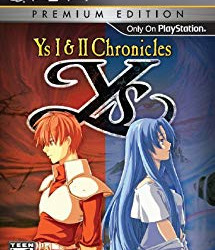
Ys 1: Ancient Ys Vanished: Omen
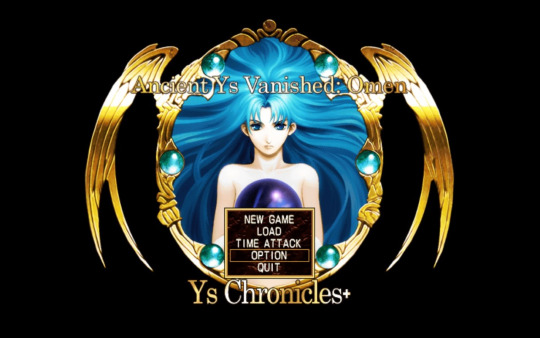
Story:
The story of Ys 1 is about the titular land of Ys (pronounced ees, like ease, or the middle part of geese), a mysterious floating island, which was, in ancient times, part of the island of Esteria. Ys was said to be watched over by twin goddesses and six great priests, named Tovah, Dabbie, Hadal, Mesa, Gemma, and Fact, until a mysterious evil forced them to raise Ys into the sky, with a few descendants of the priests and a gigantic crater being among the only remnants of Ys left in Esteria. 700 years later, odd things are happening in Esteria, with a wall of storms appearing to surround the island, cutting it off from the rest of the world. On the island itself, monsters have suddenly appeared as well, and something is stealing anything made of silver from the inhabitants, even resorting to assault. In the middle of this, the red haired swordsman Adol Christin, fueled partly by intense wanderlust, sets off to Esteria to investigate... only to predictably shipwreck against the Stormwall, washing up on the island and being rescued by the citizens of port Barbado, setting a fantastic standard for himself to repeat several times in future games. After setting out and reaching the town of Minea, Adol allies with the fortuneteller Sara, a descendant of priest Tovah, and sets off to collect the 6 Books of Ys, written by the priests, said to contain the secrets to the rise and fall of Ys, and the power to save Esteria, along the way meeting Feena, an amnesiac girl specifically imprisoned by the monsters, Reah, a troubadour with a silver harmonica, Luta Gemma, another descendant of the priests, and Adol’s future traveling companion Dogi, who has a hilariously small role considering his role in future games.
It’s definitely nothing too deep by today’s standards, not helped by the game’s short length, but having such an old game, we’re talking 1987, have an active focus on the story is pretty impressive, and to its credit, it does manage to make Ys genuinely mysterious, with an interesting explanation behind its fall, namely, the valuable metal of Ys, Cleria, caused the summoning of demons, and its discovery in Esteria, mistaken for silver, led to the island’s current troubles. While the characters as a whole aren’t anything special either, they have a likeable quality to them, and the main villain does have a fairly interesting twist to him; he’s also a descendant of one of the priests, Fact, out to collect the books for his own purposes. That said, the main strength of writing is just the general dialogue itself. For such an old game, the remakes added a lot of detail to the NPCs, giving everyone a name and a personality, and the translation gives a lot of life to them, making them pretty fun to talk to, turning what would otherwise be a lot of empty dialogue into amusing moments. They even gain new dialogue after certain points in the plot, which is another nice touch.
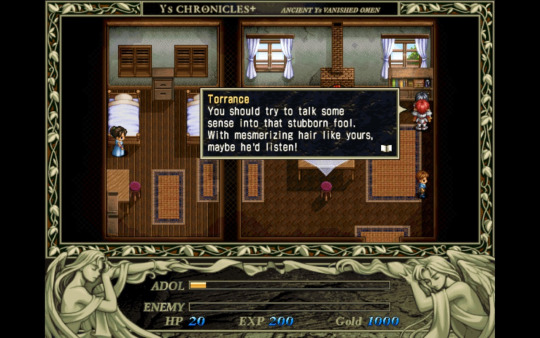
Overall, though, the biggest strength concerning the plot itself is the actual dedication put into it just relative to the time it was released. Touches like the Books of Ys being in a completely different language than what Adol knows, forcing him to find a way to translate them, and Luta Gemma’s mentions of guiding dreams, something that would become a much more common occurrence in the sequel. Speaking of which, this game was clearly betting on having a sequel with its plot, which is a pretty ballsy move even now. The deeper details to the downfall of Ys, the mysteries behind characters like Feena and Reah, and just what Ys itself is really like are left unanswered, with the game ending on an outright cliffhanger, with the books transporting Adol to Ys after saving Esteria, very likely one of the first video games to do so, at least in regards to following up on it. Overall, the writing side is still entertaining enough, and as long as it manages to be fun, that’s a success in my book.
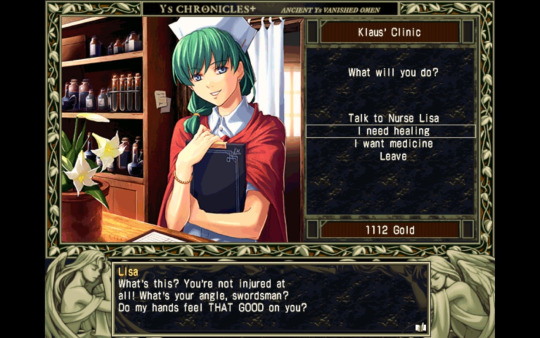
Gameplay:
Here’s where stuff gets a bit, let’s say, contentious. Ys is played at a top down angle with you controlling Adol, and only Adol. Combat, compared to almost any other video game, even from the 80's, is rather unusual. You see, instead of using a dedicated attack button, Adol suffices with ramming into his enemies, swinging his sword and damaging them automatically on contact. This system, called the Bump system, may sound, well, dumb and overly simple, but it’s quite a bit more complicated than it may seem. Running directly into an enemy, rather sensibly, kills Adol dead in just a few hits, though he at least trades hits with them as well. In order to attack safely, you need to hit them at a vulnerable angle, such as to the side or behind them. Thankfully, you don’t need to pull hit and runs for every individual attack, as once you hit an enemy at a good angle, you can just keep moving forward and attacking, with them being unable to resist unless you choose to move away, or are knocked back by another enemy. While it can be difficult to put to use at first, it’s actually a fairly well designed system. It gives the game a fast and surprisingly intense pace, with enemies being able to kill you in just a few hits, and having telegraphed attacks of their own in addition to being able to hurt you just through collision. On the opposite side, being able to run into enemies and kill them in a second is pretty satisfying, and makes grinding for EXP and gold a lot less troublesome than usual in RPGs, considering you can just take things down on your way to something else. The game also takes mercy and allows you to automatically regenerate your HP on the overworld and in towns just by standing still for a few seconds, and considering enemies only respawn when you move the screen, it isn’t much of a risk to you either to just stop and take a breather.
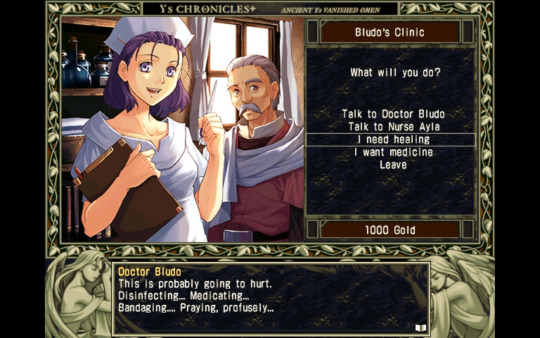
Adol’s equipment consists of swords, shields, armor, and rings. The first three are pretty self explanatory, boosting his attack and defense, and acquired by buying them in shops, finding them in treasure chests, or even received from NPCs for free in a couple of cases, while the rings give effects like boosting attack or defense, slowing down enemies, or boosting health regeneration, either doubling it when Adol is outside, or allowing it in dungeons, where it is normally restricted, though unfortunately the rings do not work in boss battles. Adol also has a regular inventory, mostly containing key items, including a few equip able ones like a mask revealing secret passages, and a few other things like potions to restore health and wings to instantly transport him back to Minea. As this is an RPG, there’s also a leveling system, which gives Adol downright dramatic stat increases each time he gains a level. Problem is, these levels matter way more than equipment, and with the jump between each level, the early game consists of just grinding a few levels until you’re capable of taking on the next set of enemies somewhat safely, with several bosses in particular being outright immune to damage until you reach certain levels. At the least, you don’t have to do this many times, considering the level cap is only 10, which you need to reach to beat the third boss out of seven, after which you’re at the mercy of any equipment the game gives you to get any stronger. Speaking of which, bosses mix up the gameplay a bit by being vulnerable at any angle, meaning you just have to focus on getting to them in between their attacks. Unfortunately, most of the bosses aren’t exactly great, either being really easy, or really, really annoying, with special mentions going to the previously mentioned third boss, which spends most of its time as a swarm of bats capable of covering most of the screen, only being vulnerable when it reforms for the briefest of moments, and we’re talking barely a second. Sometimes it’ll reform almost immediately after transforming, but other times it’ll chase Adol much longer, and it stays as the bat swarm longer if you get hit. It doesn’t take much damage even when you do hit it, as a cherry on top, making for a very drawn out fight.
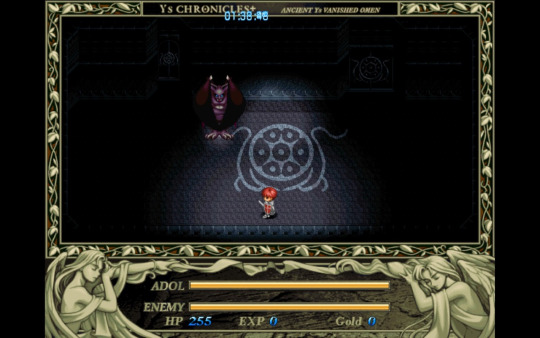
The 4 bosses after this one are a lot more fun, at least. From a giant mantis that constantly throws scythes at you, to a giant rock creature constantly firing projectiles at near bullet hell levels, to two giant floating heads bouncing around a room with barriers around them, forcing you to slip in between the barriers to hit while they swap between who is vulnerable, they’re legitimately intense, and a lot of fun, culminating with Dark Fact himself as the insane final boss, ping ponging around a room, firing near impossible to dodge projectiles, turning it into a game of rushing to meet him once you can predict his path and damaging him as much as you can, while he destroys parts of the floor for every hit he takes, killing you if you’re not on a different tile when he destroys it. It’s a nightmare attempting it at first, especially since you can’t even use your best equipment, as he is immune to any sword that isn’t the silver sword, and will kill you near instantly if you don’t use the silver armor and shield, and the instant death floor destruction is a cheap move, especially since you can outright get trapped if the right tiles get broken, nearly always forcing you to reload. Still, it’s actually pretty fun once you get the hang of it, and certainly lets the villain live up to the hype he built up. It should be mentioned there’s also a time attack mode that lets you go through a boss rush. It’s actually pretty fun, if let down by some of the roadblocks a few bosses present.
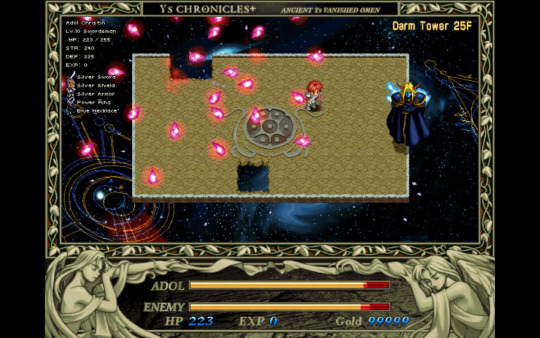
While at its core, Ys is an enjoyable time, there is one pretty difficult to ignore aspect to it: it is a very short game. There’s only three towns, a fairly small overworld, and three dungeons to go through. The first two dungeons, an old palace and a mine, are pretty decently lengthy, with quite a bit of stuff to find, but otherwise, it’s just a lot of backtracking and grinding. There’s not much in the way of puzzles, either, mostly only a few in the final dungeon. Once you’re forced into Darm Tower, with a full set of silver equipment and half of the books in your possession, you don’t think this last dungeon will be much. But that’s when the game throws you for a loop. Darm Tower is a behemoth of a dungeon, at a massive 25 floors you have to trudge through, with plenty of detours and backtracking. There’s new enemies every few floors, and 4 whole bosses are contained in this place. In the original versions, it easily took up half the game, and even in the newer versions, it’s a third of the game at minimum, if you spend enough goofing off. I have some mixed feelings towards this place. It’s miserably long and difficult, that mostly just has the same look to it in each floor, and even the music is the same until towards the end, not to mention once you go in, you’re stuck, and forced to keep on marching until you reach the top. On the other hand, I kinda like it just because of how unique it is. Darm Tower is hyped up even during the intro to the game, and plenty of NPCs say it to be an awful, fearsome place. If you’re savvy with RPGs, you might figure it won’t live up to that... but no, it lives up to all the hype it’s given. It’s utterly massive and exhausting, with tons of dangerous enemies that’ll hunt you down relentlessly. They’re even able to stick in plenty of plot and characters within, and seeing the day slowly turning to night as you make progress is quite a sight. In just living up to, and even surpassing, this hype, I kinda have to respect it. Overall, the gameplay of Ys works a lot better than you’d expect, successfully polished through over 20 years of remakes, but the short length alone could make it a difficult recommendation on its own.
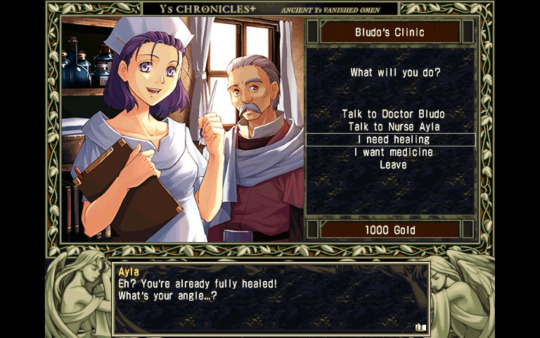
Graphics:
Ys is actually a very pretty game to look at. The characters and regular enemies are in a sort of chibi style, which is pretty adorable, but not too detailed by themselves. The environments, on the other hand, look great, with lots of little details and allowing some fantastic views. While the enemy designs and locations aren’t anything too special, they still look quite good, especially the bosses, which are significantly bigger than normal enemies. Enemies also explode in a cloud of blood, bones, and body parts when defeated, which is both funny and satisfying, while not being anything too gruesome. You may have also noticed the border portrait in these screen shots, which I find quite nice to look at, if a bit restricting. You are allowed to go completely full screen, though, if it’s not to your tastes, but it doesn’t actually cut anything off.
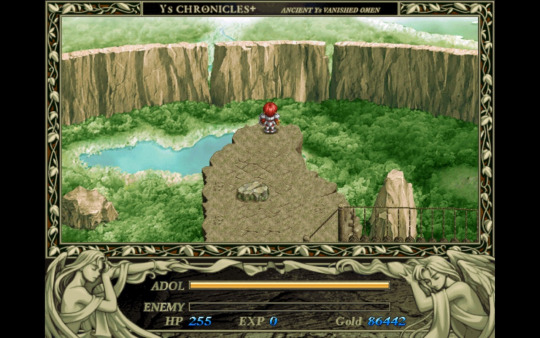
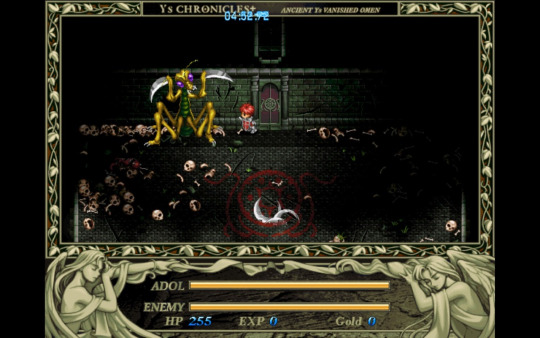
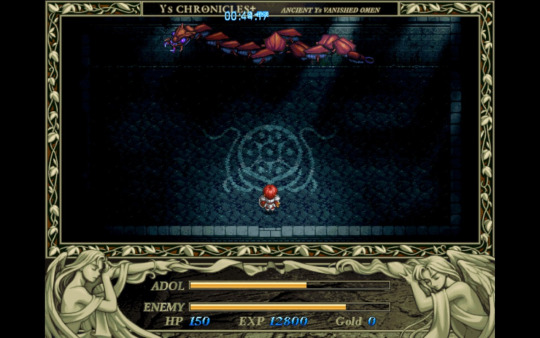
The best aspect of the visuals, though, is the character artwork used when talking to important characters. It looks absolutely beautiful, and is a good contrast against the otherwise lesser detailed sprites.
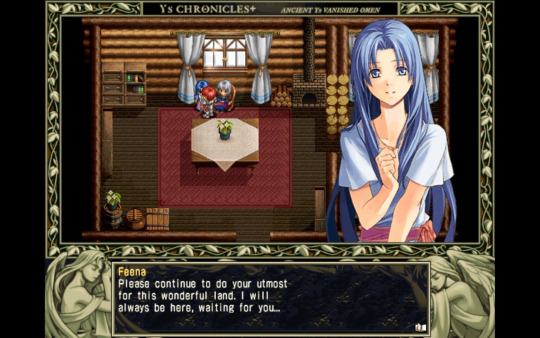
This version also goes above and beyond in this regard by giving you options regarding this character artwork, namely a choice between using the newer artwork made specifically for this version, Ys 1 & 2 Chronicles, and the older artwork originally used in Ys 1 & 2 Complete, the PC remakes that have served as the basis for almost every port of these games since their release. Which you use comes down to a matter of preference, and while I do find the Complete artwork to look a bit odd at times, overall both options are beautiful. (Chronicles artwork is used first in these comparisons, and Complete artwork is used second)
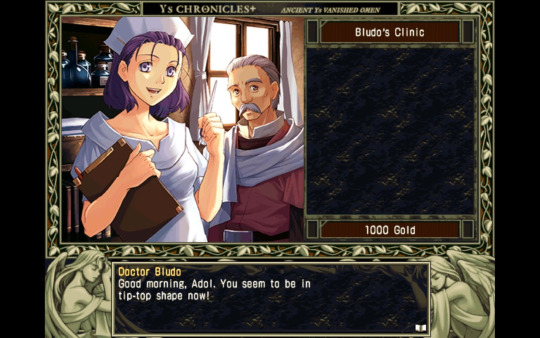
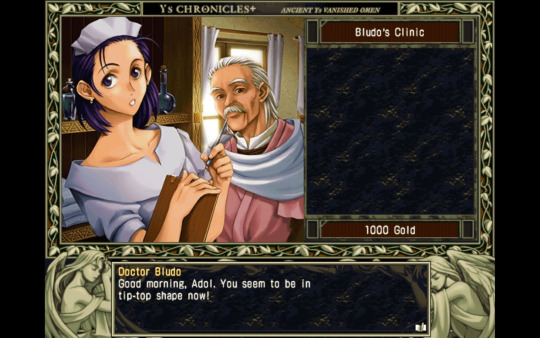
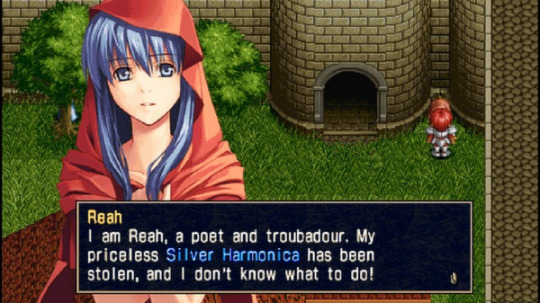
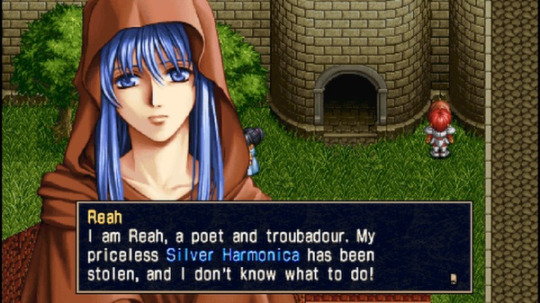
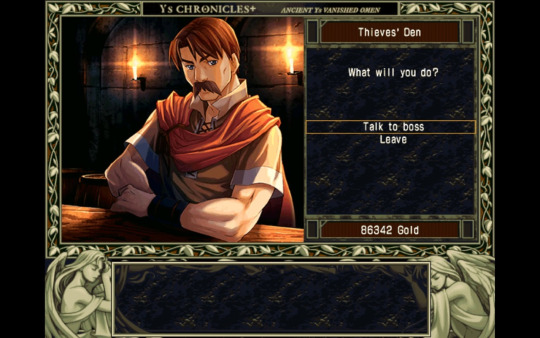
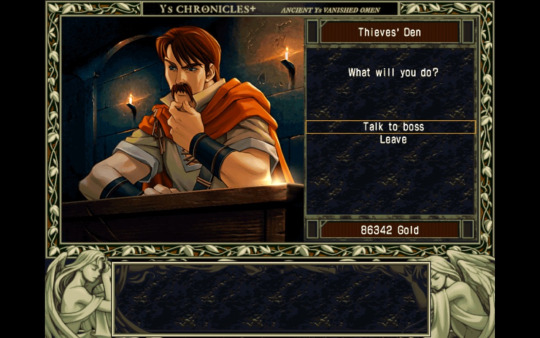
Sound:
Ys 1 has an absolutely fantastic soundtrack, courtesy of Yuzo Koshiro, also known for the soundtracks for The Revenge of Shinobi, Etrian Odyssey, and, probably most famously, Streets of Rage, setting a standard for Falcom games in general, and providing quite an influence on video game music as a whole. This version again gives options in regards to the soundtrack, giving three different versions to choose: the original soundtrack on the PC-88, which holds up well even today, the Complete soundtrack, which gives a refreshing and different take on several songs, even if it’s very blatant in being in MIDI at times, and a new soundtrack recorded specifically for this version yet again, which is amazingly metal. It, again, comes down to preference, though while I like all of them quite a bit, I easily like the Chronicles soundtrack best, though it’s telling when the original PC-88 version of the title screen theme, Feena, is just as pretty as the other versions. Speaking of which, when it comes to individual pieces, some big standouts to me are Feena, again, for the title screen, Palace of Destruction, the theme of the first dungeon, Fountain of Love, Minea’s theme, Tower of the Shadow of Death, the maddening theme of Darm Tower, and Dreaming, played during a memorable maze section of Darm Tower. It is, overall, among some of the best music I’ve heard in a game, and is worth looking up even if you otherwise have no interest in Ys.
Ys 2: Ancient Ys Vanished: The Final Chapter
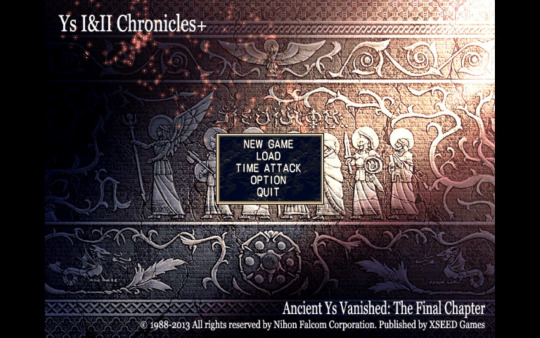
Ys 1 and 2 are so tightly connected to each other that I could not go without giving both games a proper looking through. Most releases of them nowadays can’t either, with almost everything bundling them together, which makes the short length of both a lot more acceptable, especially if you look at them as two split up parts of one game, like the acclaimed TurboGrafx-16 version did.
Story:
Ys 2 picks up right where Ys 1 left off, with Adol being transported to Ys itself. Unfortunately, his journey is not too smooth, resulting in him ending up unconscious and losing everything except for the six Books of Ys, eventually being rescued by a girl named Lilia and taken to her home of Lance Village. At least it wasn’t a shipwreck this time. But yes, as it turns out, people still live on Ys, and lived so in peace, until the same events that caused monsters to appear on Esteria caused the demons that once devastated Ys to reemerge. After being told that returning each tome to the sanctuaries of each great priest would open the way to the Shrine of Solomon, the former temple of the twin goddesses, and the current base of locations of the leaders of the demons, Adol sets off once again, to restore peace to Ys once and for all.
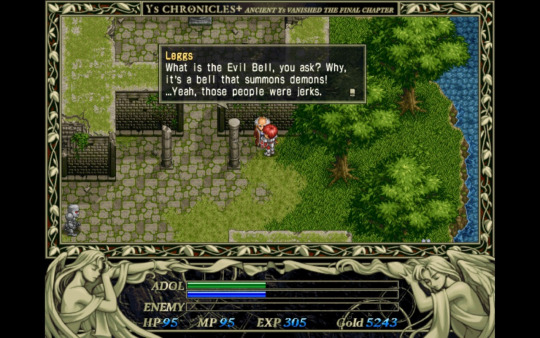
There unfortunately isn’t that much more for me to say regarding the writing. It’s about the same quality as the original when it comes to plot and characters, but overall, it’s a good conclusion to this tale, and the general dialogue is as entertaining as ever. I will say, though, that the tone works quite well, carrying a somber feeling reflecting the misery of the people of Ys, and their wish to return to happier times. Additionally, using a certain spell in the game, Adol is able to talk to the demons on friendly terms, and every one of them has unique dialogue. Not every type of enemy, every enemy has unique dialogue. Some of it is informative, but others just seem to be Falcom and/or XSEED going out of their way to prove how dedicated they are to detail, and I for one love it. Another notable thing to me is the setting of Ys itself. Esteria was a fairly normal location, but for such a mythical place... Ys itself isn’t too much different. It has some more extreme environments, like an ice wall and lava filled caverns, but it’s remarkably normal otherwise. While this may come off as disappointing, it fits quite well, considering Ys was never meant to be so grand and mysterious, and is a relatively normal place forced into an abnormal situation. Overall, again, it is a solid conclusion and step forward.
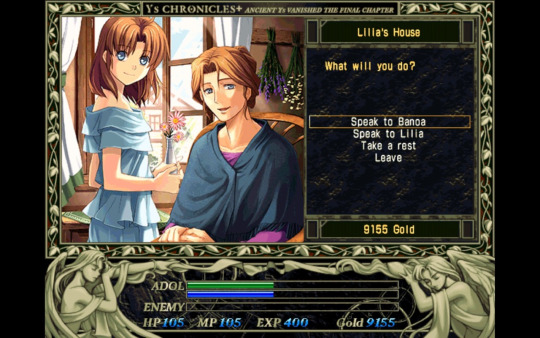
Gameplay:
The gameplay of Ys 2 is more or less the same as Ys 1, for the most part, divisive bump system and all. It does, however, feature several improvements, mostly to the combat. Firstly, the bump system has been changed so that ramming an enemy while moving diagonally will always count as a safe hit for Adol, making combat a lot safer, and enemies generally don’t deal as much damage either. The level system has also been revamped, going from the paltry level cap of 10 to a level cap of 55, meaning you’ll be leveling up and improving till the end of the game. Conversely, individual levels don’t mean nearly as much, but not only are they easier to grind for when necessary, they also make equipment much more important. The biggest gameplay addition, however, is the magic system. Over the course of the game, Adol gains several spells, most notably a spell to shoot fireballs, which can be shot rapidly or charged for a stronger attack, but also includes a spell to temporarily stop time, freezing enemies in place and leaving them defenseless, a passive, yet constantly active spell that reveals secret passages, a spell that allows Adol to appear as a demon, allowing the previously mentioned interactions, and even a spell that can warp him between various towns and other important locations, something that proves extremely helpful. This system alone adds so much to the game, and is a great way of expanding upon the rather limited system of the first game. Accessories have also been overhauled, as rather than just rings with simple effects, they’re various objects with much more unique effects, such as yet another ring that occasionally allows Adol to parry an attack, and an idol that gives homing properties to his fireballs. All bosses except for the last two now require the use of the fireball spell to defeat, making them a lot more reliant on skill than just being at the right level, making them a lot more fun as well, while retaining the frantic feel.
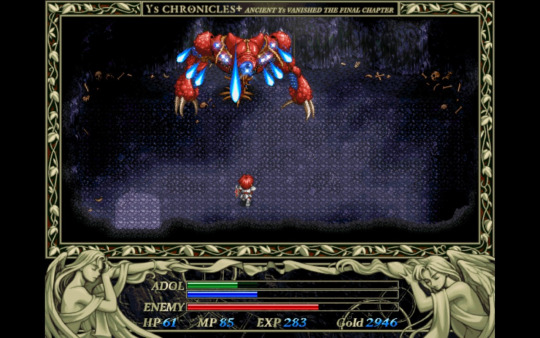
Another addition is the ability to give items like flowers and apples to NPCs as gifts. A few of them will reward you with valuable information, or even items, but for the majority, all you get is some amusing dialogue, all of which is unique, once again proving how insane these writers and localizers can be. You can also choose to throw fireballs at them, causing them to shout some pretty funny comments, which often include references to other games like River City Ransom and Final Fantasy 6. Still, it’s not very practical considering it lowers their affection, requiring more gifts just to get back to neutral. While it doesn’t affect normal dialogue, this little system is worth messing around with, just to see what laughs you can get from it.
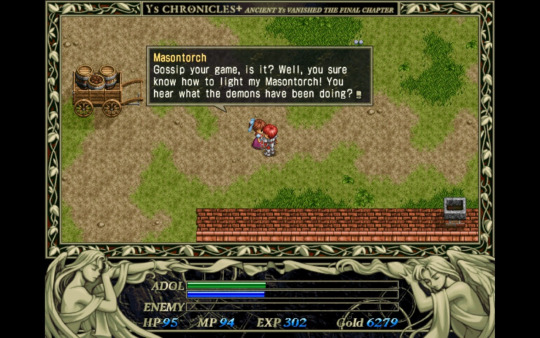
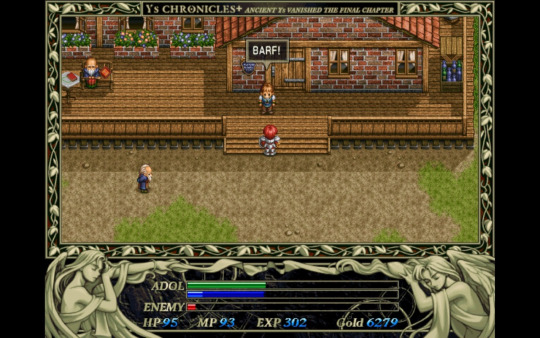
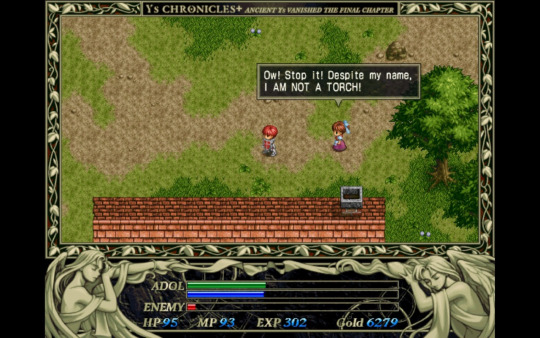
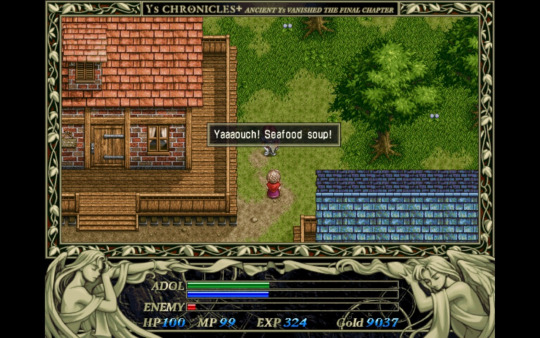
Otherwise, the game is more fleshed out, with a lot more places to go to. You’ve got a shrine and a mine combined into one general dungeon, a beautiful ice wall, volcanic caverns, and finally, the Shrine of Solomon. Compared to Darm Tower, the Shrine of Solomon isn’t quite as dominating, but it’s still huge, and sadly still requires a lot of backtracking. I’d wager it’s about a fourth of the game in of itself, possibly a third if you’re quick enough with the rest, and can still get pretty draining. Still, it’s a lot more enjoyable than Darm Tower, having more interesting environments, such as plenty of outdoor areas and a subterranean canal, and certainly lives up to the hype itself had built up. There’s no overworld, but considering how you were gated off by anything you weren’t a high enough level to take on in Ys 1, combined with how tiny and featureless said overworld was regardless, this linearity is preferable, giving a nice sense of progression. There’s also 4 towns spread out quite nicely, giving some much needed breathers after some of the more expansive parts of the game. The game is a decent bit longer than Ys 1, especially if you allow yourself to goof off and take in all the detail, like I did. Overall, Ys 2 has some much improved gameplay, and is a lot more fun than the already enjoyable first game.
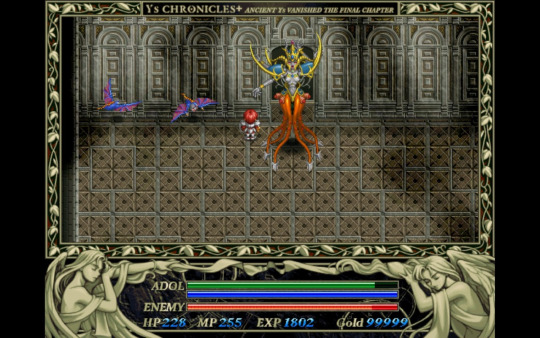
Graphics:
The graphics of Ys 2 are about the same level as Ys 1, namely, it looks great, especially the character artwork. One noticeable improvement comes in the area and enemy design, looking a lot more distinct than in the first game, making it all look a lot better. There’s also a dumb, but cute option that lets you hang a “mascot” on the screen, which just amounts to the sprites of various characters and enemies, more characters unlocking at maximum affection. Otherwise, I could just copy and paste I said in this section for the first game. Still, very good.
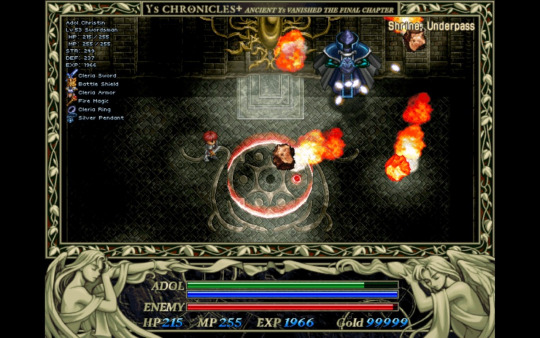
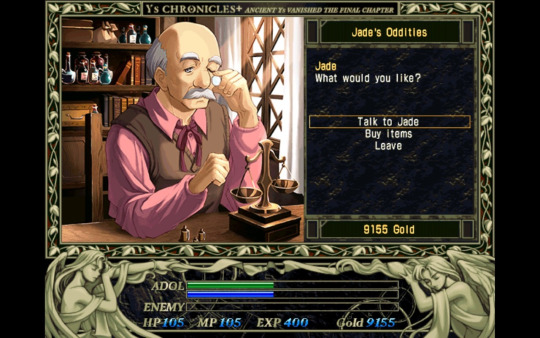
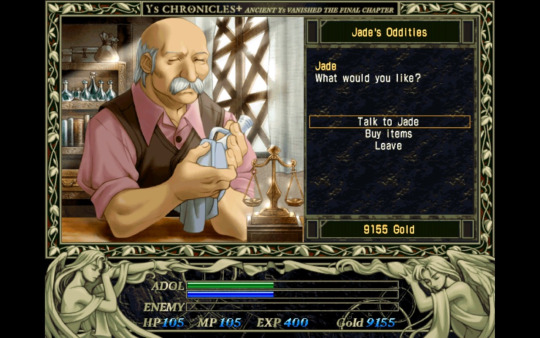
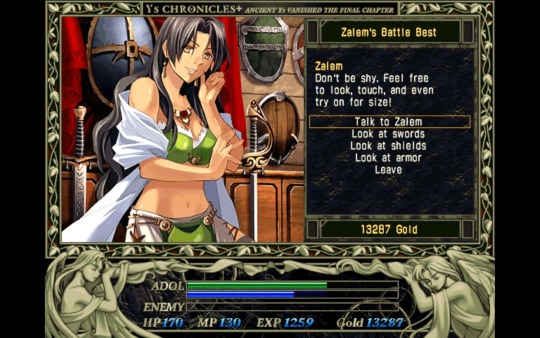
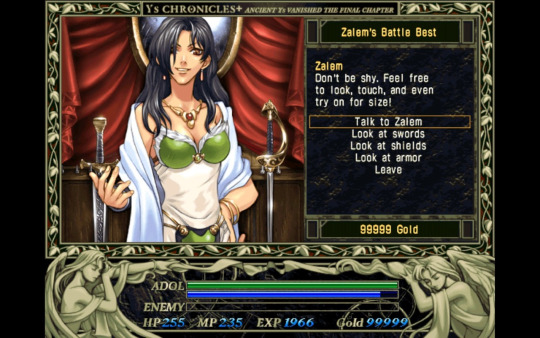
Sound:
The music, again, is very similar in quality to the first Ys, and is still amazing. Personally, I find the Complete remixes are a bit weaker compared to the first game, but the Chronicles soundtrack still hold strong. Some stand out pieces to me include Too Full of Love, Lance Village’s theme, Ruins of Moondoria, Ice Ridge of Noltia, Palace of Solomon, Tender People, Ramia Village’s theme, and this game’s remix of Feena, which is even better than the version in Ys 1. Overall, still a fantastic followup.
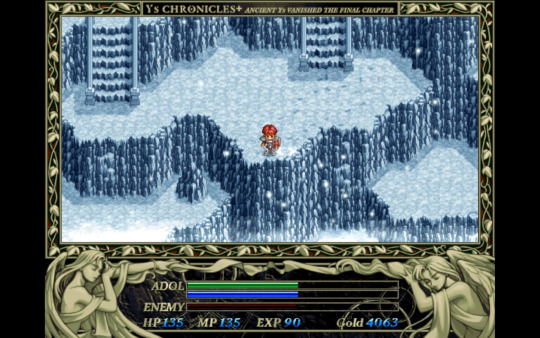
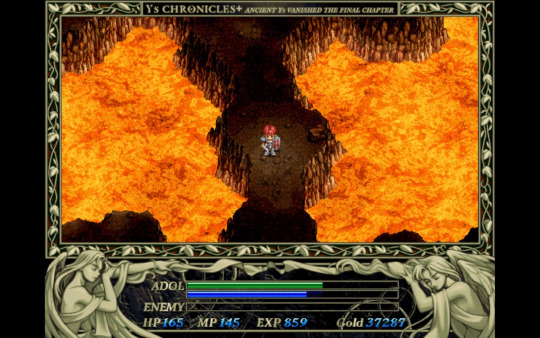
Conclusion:
Overall, Ys 1 & 2 Chronicles gets a recommended from me. It’s short length, questionable combat system, and overall signs of age can certainly be enough to make one wary, but getting past that leaves you with two games full of charm and passion. More than anything, they feel rather comfortable and relaxed. The shorter length, the various options for graphics and music, the general charm of it, and even the goofy and often context-less achievements, these two games manage to be memorable experiences.

This collection is a great introduction to one of the grandfathers of RPGs, a grandfather that’s still going strong after more than 30 years. Till next time, and apologies to anyone who reads this for how horrendously long this ended up.
-Scout
3 notes
·
View notes
Text
Review: Princes of the Apocalypse
by Colin Padgett Arnold
After running it for seven months, my home table has made it through the first four dungeons of Wizards of the Coast’s Princes of the Apocalypse, an adventure book for Dungeons and Dragons 5th Edition. This comprises the book’s first act and covering roughly a third of its content. I figured this was as good a point as any to reflect back and review the book thus far. Specifically, I’ll be covering Chapters 1, 2, 3, 6, & 7 as well as Appendices A, B, & C.
Some quick notes for bias and control. I am a fairly experienced GM with most of my experience running games spread over D&d 4th Edition, 13th Age, and Dungeon World, and experience playing in just about everything else. The players consist of two experienced role players and table top gamers, two experienced creatives who have none the less never touched an analog role playing game, and one inexperienced player with impeccable comedic timing - a fine mix of sagely wisdom and fresh perspectives. The party is made up of a cleric, a paladin, a ranger, a barbarian, and a warlock. Suffice it to say, they are running a surprisingly balanced party with one more player than ideal for the adventure, but not enough to have to necessarily change anything prewritten. I won’t be detailing the specifics of how my players have played through the adventure, but if you’d like to follow my group’s exploits against the elemental cults then you can find us at #Kru.
Addendum: when I originally started writing this the group was seven months in, now we’re a whole year. A combination of me putting off covering the appendices and summertime simply being a busy time of year for me professionally had this just not happen! In a few weeks they’ll be through Chapter 4 with several more Side Treks under their belt. However, I won’t be covering that chapter in depth. Each of the dungeons in Chapter 4 are impeccably well designed and where the game really shines. The problem is, it’s also where the game becomes infinitely mutable. While you can run each of these as a highly tactical dungeon crawl, players can also get by them largely through skulduggery and diplomacy or, my favorite, using a cataclysmic weapon of the cults introduced in this chapter along with a myriad of spells and abilities to upend the sand box. My players have done all three, including clearing a dungeon entirely by leveraging a character’s backstory and the character arc we’ve been building to destroy it in a handful of encounters. Chapter 4 will be truly different for every single group that plays it, especially if the dungeon master is heavily integrating their players’ characters and backstories.
At a Glance
Princes of the Apocalypse is a heavy tome at 256 pages, brought to us by Sasquatch Game Studio. Its lead designer, Richard Baker, has had a prolific career in game design running Forgotten Realms development during the early 2000s, working on D&d since it’s TSR days, and writing a number of other games and novels. Princes was specifically written to bring the classic Temple of Elemental Evil storyline and concept into 5th Edition and to create a more free form foil to the previously released Tyranny of Dragons story line. The adventure sees you going on a hex crawl inspired by the classics to take down four cults devoted to elemental magic in a sleepy frontier valley. The scenario is structured into three acts, each one delving into a deeper layer of dungeons controlled by the elemental cults and is designed to take a party of four adventurers from level 3 to 14. It also contains two short adventurers to take a party of level 1 characters up to the book’s starting point.
On the whole, I’m on the fence on how effective Princes is at being an exploration game. Taking place in the Dessarin Valley just inland of Forgotten Realm’s Sword Coast, the meat of the adventure takes place in a measly ten hexes of a sum nine hundred and ninety hex map. Occasionally the book proper takes you out of this clump, and the adventure’s side quests are all far reaching into the rest of the valley. However, I’ve had to very heavily bait the party to any part of the map that isn’t the small neighborhood of scrub hills the elemental cults are based in. Not because they don’t want to explore the world, but because comparatively the distance to any extra location is two to four times the distance between the town Princes starts you in and the cults themselves. The game certainly is a sandbox as every situation has a number of vectors to approach from and contexts to find it in, but I rarely see my players tempted off the major roads and landmarks.
The cults themselves, who at the start are organized in four surface level strongholds, seem to have been designed with a “correct” order in mind, with each one being balanced around a party level one higher than the last. While a smart party could certainly take down the level 4 or even level 5 dungeons right out of the gate, the “final” stronghold is filled with a number of enemies capable of casting Fireball. A level 3 or 4 party simply doesn’t have the mechanics to deal with or throw back that kind of firepower. Likewise, each stronghold has an entrance to that cult’s corresponding Act II dungeon and each one feels like the natural place to proceed in the moment. This does, however, land the party into dangers designed around a party 4 levels higher than they are.
I feel like Princes has two separate games inside it, just playing with the same elements. You can certainly run the game like Tyranny of Dragons or the Starter Box, with a lightly railed plot where the party goes around kicking in doors, one dungeon at a time. The surface text almost expects it. Each of the main villains of Act I’s “how to role play” blurb ends with “and then they probably just attack the party.” If you want traditional, heroic, storm-the-dungeon fantasy then Princes has you, which is weird because that’s not what it says on the tin.
A smart party that approaches Princes like a sandbox game will do perfectly fine in Act I as long as they at least half expect to get in over their head. That level 6 dungeon with all the Fireball casting mages? It’s a rickety tower in disrepair with spotty defenses that, if players have a mind to, could just be burned down with minimal effort. Every cult has a fairly easy way to infiltrate their ranks with a subtext that the players might even seriously join one. And the NPC villains are certainly more fun to play in Act I when they’re more concerned about their rival cults than this band of adventurers loping through the valley.
Ironically enough, the things that have helped motivate my players to range far away from home and the cults themselves have been trying to scrounge up resources, aid, and solutions when they’ve bitten off way more than they can chew. I think where the genius of this design comes in is when you run it as a sandbox for players that haven’t learned how to approach one. Yeah, I’d prefer if all four of the “Haunted Keeps” where on more even difficulty with each of them having some threats that were particularly too much to deal with. But looking forward to Acts II and III, I’m hoping that the rather large disparity of letting a party walk into a dungeon twice their level at the start of play is to help teach players how to scout, retreat, and really think about when they should fight, talk, or completely circumvent a problem. Princes really does present you with an exquisite chess set to play around with, even if the directions themselves are rather straightforward. There are relatively few cues for how to use the NPCs and their resources outside of letting the players roll up on dungeons, but each cult and character’s motivations are clear, concise, and interesting. I’ve honestly been surprised how easy it’s been to go off book with this adventure and have it still feel seamless to what’s already there. Any game master with a little experience willing to play back and forth with their players will find a fun way to run it.
Whew, that was a long glance.
Chapter 1: Rise of Elemental Evil
Simple enough, the first chapter gives you a sweeping backstory for the adventure. Four cults each drawn to a different Prince of Elemental Evil (supremely powerful beings who are each King of an Elemental Plane and associated with air, earth, fire, and water respectively) have taken up residence in some ancient castles on top of an ancient Dwarven city on top of some spooky Underdark caverns. A diplomatic mission to Waterdeep gets kidnapped by these cults, which kicks off the whole adventure. Chapter 1 details the philosophy of each cult and their elemental master, along with the history and motivations of each cult’s Prophet - the leaders that are ultimately going to be your big villains at the end of the game. Out of any of the story set up, I think the character write ups on the Prophets are the best things in this book. I’ve been so anxious to introduce them, I’ve been giving my players short aside scenes to build them up between major events. Every one of them has something akin to the Sending spell to start a real dialogue with the player characters, though it’s unlikely they’ll be on the cults’ radar until after Act I.
For players, there’s a list of several adventure hooks to give characters a reason to join the adventure. Some are cryptic rumors to help lead the party to any of the first four dungeons. Some are connections or bounties to encourage a character to seek out and deal with certain mid level villains in the cults’ chains of command. Some help reveal hidden information about the dungeons that lay beneath the valley, and a few even point all the way to the final dungeons. Regardless, each hook is a hint and a set of criteria for the character to receive 2-4 inspiration points. A little advice: don’t give out the adventure hooks that won’t pay off until the end game. If you plan on making your players stick with character deaths, you’ll need them to help fold in new characters. If you like to play fast and loose with character death so that it only happens when it matters to the story and characters, then you can always assign new, relevant adventure hooks at the start of each Act.
If you’re a big fan of Forgotten Realms, 5th Edition’s focus on Faerun’s faction system makes an appearance in this book as well. Each faction has an investment tied up in the delegation that goes missing at the start of the game, and each is represented by agents across every settlement in the valley. If a player would like to start as a part of a faction they get an easy in on the adventure, but there’s no additional benefit. My group elected not to start with any affiliations, and has still managed to frequently interact with them. The book leaves plenty of room to encounter the various factions at your leisure, and they feature in several of the Side Treks.
Chapter 2: the Dessarin Valley
Princes is set in the Dessarin Valley, a frontier wilderness off the Storm Coast of Faerun. Chapter 2 details the various towns, villages, and settlements throughout the valley, provides random encounter tables, and contains a helpful map of the whole region and all the various hidden fortresses and goodies. The most in-depth attention is paid to Red Larch, the town the adventurers start in.
Red Larch is a tiny little crossroads town with about twenty or so major businesses and locations for the players to interact with. It has everything from competing caravan carpenters and an adventurer supply shop to agents of every major player faction and either a spy or lead for every cult. Each location has an entry describing it’s look, business, and the key NPCs that reside there. Some also have entries for leads relating to the cults’ business in the area (Rumors of Evil) and secret agendas concerning the townsfolk for an optional side quest (Trouble in Red Larch). Of particular note: the local temple hosts shrines to any god imaginable and is manned by a single priest who is relieved every two weeks. The initial NPC is a contact for The Gauntlet faction, and getting the players involved with rotating clergy can give them a more personal connection to the outside world and the powers and resources of Waterdeep, the nearest major city, without having to abandon the adventure to actually go there.
The other half of the chapter details exploring the valley. Every major settlement or location has a quick description, details on any NPCs that might be found there, and a summary of why in the world the players would even want to go there. Mostly this details which faction can be found where, what can be bought, and whether or not the place is tied up in a side quest. All the locations have some nice flavor but, again, they are all particularly out of the way.
Aside from distance, my only real complaint is that the valley is inhabited overwhelmingly by humans, and humans end up being most of the cultists as well. Feel free to spice that up as you see fit. I certainly like my fantasy to be a little more fantastic, and you have plenty of room to add in things without out-shining some of the crazy stuff the cults will bring to the table.
A note on the scale of the map: the book’s scale says 1 hex = 10 miles, while the errata for the book says 1 hex = 4 miles. I’ve been operating under the errata’s listing but using The Alexandrian’s guide for traveling a Hexcrawl. Even ignoring terrain types, this travels a little slower than rules as written 5th Edition. However, even when running 5th Edition’s travel times, 10 mile hexes make most locations a week or more away, which doesn’t always match up with cues and notes throughout the book.
It does, however, match up with the math for random encounters. Princes’ random encounter check will have you encountering something every 3 or 4 days which is perfect for 10 mile hexes but with 4 mile hexes leaves the players mostly alone in the wilderness. If you go with 4 mile hexes, which I highly recommend, either roll double the twenty sided dice when doing random encounters or just throw in one whenever you deem it appropriate.
The biggest thing this adventure is missing is some kind of random weather or event table. The book frequently mentions how the Elemental Planes are affecting the valley, changing the weather, and disrupting daily life. Aside from the random encounter table, the cults themselves, and a few events keyed off of hitting checkpoints like clearing dungeons, Princes largely leaves it up to you to narrate. I would have loved to have a few prewritten tables for flash fires, thunderstorms, or earthquakes just to remind myself to remind my players the huge stakes early in the adventure.
Chapter 3: Secret of the Sumber Hills
One of the most important parts in this section is right on page 41 in a grey text box. This little box lists the level around which each of the four major dungeons are designed around, and suggests letting the players gain a level every time they clear one of the haunted keeps. This is fine if your players are clearing the scenario cleanly and easily. However, if your group embraces the sandbox aspect a little more or really likes tracking experience, take note: the math for experience in this adventure does not match up to rules as written. Raw experience for a four person party comes a few hundred short even with side quests under 5th Editions rules of only rewarding experience for killing, routing, charming, or otherwise neutralizing another creature. So feel free to throw them some extra exp for role playing, story events, creative problem solving, or whatever.
The first section gives details on how to get the players out the door. Details from any of several factions come in that an important diplomatic delegation has gone missing in the Sumber Hills, your own little neighborhood of the Dessarin Valley. A variety of clues can be found in Red Larch which can lead the the party around the local area in a simple investigation with a few combats. At the very least, the clues should get the party started and lead them to the Water, Earth, or Air cult dungeons. Just after this is a section titled “Cult Reprisals” with encounters to run after each dungeon to point them towards a new target. The Air and Water cult encounters expressly include directions to their bases, and fairly easy to find information in the Early Investigations lead directly to the Earth and Fire cult bases. If all else fails, the Air cult’s Feathergale Spire is visible on the horizon of Red Larch.
Of the four dungeons, Feathergale Spire is the most scripted. The party can walk right in, socialize, go on a quick hunting trip, and get back in time for the game master to figure out how long they want to stretch this one out. The air cult here is the easiest of the four mechanically, but strategically as a tower in the middle of a canyon with knights mounted on vultures it’s the hardest structure to assail by force. If they can charm their way through the front door, which is an easy task, they shouldn’t have any problems. The unit gives you two named NPCs: a rather blank knight named Savra who’s pretty easy to take in any direction you want, and the tower’s captain Thurl Merroska who will be an easy way to make the players distrust any NPC of authority they meet for the rest of the campaign.
The second dungeon, Riverguard Keep, is located on the major river of the area. The book recommends playing it out as a mercenary group attempting to renovate the castle to protect the river from pirates, who they secretly are. Fairly quickly my players gathered more than enough information about the local river pirates and the water cult that trying to keep up the deception would have been ridiculous, and this was the first place they visited. Mechanically, the keep throws a lot of bodies at the party which could be overwhelming, but there’s only a few spell casters spread out over the whole dungeon. This dungeon’s named lieutenant is a Genasi river boat captain that your players are just as likely to meet on the river or in the port of Wormford. Their leader Grimjaw can be particularly troubling depending on how much you stick to the rules as being a Wereboar leaves him immune to most early forms of damage and capable of saddling one or two of your players with lycanthropy for their next couple of levels. Goldenfields and Summit Hall are two religious locations that should have a high level cleric with remove curse, should you need to point your players towards one.
The Stone Monastery, the Earth Cult’s base of operations, is the first problematic dungeon as far as order goes. The abbey contains four gargoyles which can be particularly tough without some strong magical damage. And while the Earth Cult’s base enemy monk is fairly easy to deal with, they have two other unique enemies with strong defenses, strong attacks, and some very good spell casting. The dungeon itself has some specific notes about what to change if the party leaves and returns to take the cult down another day, which is likely to be the case. The monastery gets three named NPCs. A friendly Lich has been living in the building since it was his family home and can drop some exposition about the area’s history. A rather boring priest is there to greet visitors and possibly induct the characters into the lowest level of the cult. Lastly, the abbess of the monastery is Hellenrae (or, as my players have taken to calling her “Literal Actual Toph Bei Fong.” A blind, no nonsense, female kung-fu master who can see through vibrations in the very earth? Yeah, checks out.) Probably the most dangerous thing about the Stone Monastery, though, is that the entrance to it’s Act II counterpart is right in the basement and only needs a key that the party can pick up from either leader on site. Equally frustrating for dungeon masters: depending on how you approaching looting, the Earth Cult’s priests and guards all wear splint and plate mail. Granted, it’s all made out of magically shaped stone as opposed to metal, so if you do allow your players to upgrade their armor this early you can at least saddle them with the awkwardness of constantly looking like Earth Cultists.
The last dungeon, Scarlet Moon Hall, is a burnt out hill with an old wooden tower and a flaming wickerman where some long lost druids are performing some kind of a sacred right. Fantasy Burning Man’s mechanics do a lot to compartmentalize all the various forces in the area, and many of the camps around the hill are druids and adventurers come to see the supposed ritual that can be recruited to the parties cause. This is great because between the giant fire elemental in the burning giant, the hell hounds, the fire cultists with magically flaming swords, and the several priests capable of casting fireball twice per day Scarlet Moon Hall throws some heavy punches. The big boss is Elizar, a fire themed druid who can summon smoke mephits from his tobacco pipe and possibly the most fun I’ve had running an NPC in this whole book. Princes’ NPCs have only the minimum of text to motivate specifics, but Elizar is the only one depicted coolly taking a drag in front of an explosion.
Chapter 6: Alarums and Excursions
Here we have the side quests. The first set includes a number of small excursions into the wilderness around Red Larch and two dungeons. Designed to take a party quickly from level 1 to 3, I feel like it gives new players a very nice crash course on combat, exploration, and investigation without bogging things down too much for experienced players. The first dungeon focuses on a necromancer who can net the party an early wand of magic missile. While the quest does end with a perfect moment to pass around a piece of paper with the Elemental Evil logo drawn on it, it never really ties back into the deeper machinations of the book. If you happen to start your party at level 1, be prepared to tie this back in during Act III somehow.
The second dungeon is wrapped up in a conspiracy controlling Red Larch. It’s dungeon directly hints towards the ancient Dwarven city which makes up Act II, and helps throw a little action to endear the party with the townsfolk of Red Larch. The aftermath shows a number of town elders in the pockets of the Earth cult, and leaves you to elevate whatever NPCs the party has really taken a shine to to be their reliable home contact when they come back. The villain of this dungeon, an Earth priest by the name of Larrack, makes a perfect recurring villain if your party happens to kill all the other cult captains. I’ve personally got a soft spot for the village idiot, a half-orc named Grund who spends most of his time pickling, and elevated him up to a major supporting character for the party.
The rest of the chapter is devoted to what it calls Side Treks, largely one shot style side quests. These are fun romps to try to entice the party off to the four corners of the valley. All of them net new equipment, opportunities for allies, or magic items, so don’t worry about the challenge for experience if you’re running by the book’s estimates of leveling up after each major dungeon in Chapter 3. Do try and keep an eye on the recommended level for each as they’re meant to be peppered over the whole adventure. The Vale of Dancing Waters is an adventure designed for a party at level 8 that’s particularly easy to accidentally run for a party of 3rd level characters poking around in the early game.
Chapter 7: Monsters and Magic Items
While there are some wild magic items made for this adventure, you really don’t come across many of them early on. For the time being, you really want to look at the sections on Monsters and NPCs. Every cult has a more physical, warrior thug and a spell caster priest that make appearances. Some even have two! Enemies inspired by the Monk character class make a big show. All of the spell casters have heavily elemental themed spell lists, and might have some particular inspiration if you have a sorcerer in your party. The most interesting of all of them is the Water cult Fathomer, a second spell caster that can transform into a watery serpent.
Largely, I don’t really like 5th edition monsters. Either their complexity is so simple that it comes down to how many attacks they get with their multi attack, or you’re tracking an entire spell list for them (I highly recommend the 5th Edition Spellbook app found in the iTunes App Store and Google Play. It contains every spell available through the Players Hand Book and Princes of the Apocalypse, and lets you organize individual spell lists for characters. And it’s free). Some of the lower level enemies have once per combat abilities or special circumstances like the Crushing Wave Reaver’s double damage to unarmored enemies. The Assassin ability along with sneak attack damage plays a recurring role in many NPC enemies in the Side Treks, which is good because it’s potentially fatal no matter what level it shows up in and does a great job at teaching why players should start combats on their own terms instead of charging into every situation head first. Combats that don’t involve spell casting enemies largely become boring, however, and the Black Earth Guard’s plate mail leads to some particularly slogging combat as the party levels up. At the very least, Princes adds a large number of spell casting enemies to the game, something I found sorely lacking in the Monster Manual. If your players really need a challenge, I’d suggest playing around with how enemies from different cults can interact mechanically under the narratively plausible idea that the cults are so fed up with the player characters that they’ll actually work together to try and stop them.
Appendices A, B, & C: The Good Stuff
Appendix A details a new player race for 5th edition: the Genasi. Listen, there are one hundred different articles out there talking about the optimization standards of the Genasi and their sub-races. Who cares? Do you want to play an elementally powered humanoid? The peasant version of a Djinn/Jeanie? Do you want to have rock skin, flaming hair, fin ears, or just constantly float a few inches off the ground? Do you want to have jewel colored skin and magical abilities regardless of class choice? Genasi are amazingly fun to play and for once you have a setting and adventure that neatly ties them in regardless of how Tolkienic you like your fantasy. Each cult has a major Genasi NPC to pit against the party as well. Beyond that, if you pick up the free player supplement for Princes, you’ll get Aaracokra and Deep Gnomes as well. Aaracokra can fly, which is considered the most broken level 1 ability in the whole game. Take that as you will.
Appendix B adds a slew of particularly elemental themed spells which are included as part of 5th Edition’s free content. Druids, Sorcerers, and Wizards make out with the most additions, the first two getting the most thematically out of having more elemental spells. Each element gets their own Prestidigitation/Thaumaturgy style cantrip to control an element. Frostbite, Create Bonfire, and Thunderclap are all cantrips worth considering for build optimization period, if that’s a thing you’re into. Regardless of if you’re playing Princes of the Apocalypse or not, the added spell list does a ton for filling out spell lists for characters that just want to cast Ice spells and nothing else, or whatever element happens to take a player’s fancy.
Lastly, Appendix C describes how to take Princes and apply it to different settings. Mostly focusing on transplanting the campaign into Darksun, Dragonlance, Greyhawk, and Eberron, this section details a lot of focus on how to pick the region your players will explore and exactly what function each player faction is supposed to bring to the story. Even if you intend drop Princes into a wholly original setting or just keep it in Faerun, seeing four more takes on the adventure’s context helps understand what’s supposed to be important and what isn’t.
Final Review
All in all, this is one of the best pre-written adventures I’ve ever run or played. My biggest complaints are a somewhat mundane cast of races and a lack of a full service for weather and elemental effects in the overworld, which are things that are easily changed and designed at home. Princes’ set piece dungeons are so tightly designed, inspiring, and well notated that any dungeon master should have plenty of time and energy to fill in whatever gaps the book leaves in their play style. As for length, a focused and effective group of players could finish this adventure in around a year with weekly sessions, though there’s plenty of room for role playing and side content to keep a group content for even a whole two years. This ranks up there with the best games I’ve ever been a part of.
Thanks to Peter Tesh for editing.
#review#dungeons and dragons#dnd#d&d#Princes of the Apocalypse#Elemental Evil#prewritten adventure#adventure module
4 notes
·
View notes